























FARMERS have battled a barrage of rain, hail and snow as April’s erratic weather has continued to pile pressure on farm businesses and farmers’ mental health.
While some areas have seen some relief from the relentless wet weather this week, others have faced snow and hail as a difficult lambing and spring planting period continues.
Farmers in England, Scotland and Wales said it has been one of the worst 18 months of farming in their history, which has affected lambing, calving, their ability to plant autumn and spring crops, with serious reservations about the success of harvesting healthy crops.
But new figures from the Royal Agricultural Benevolent Institution (RABI) showed strong public backing for fair prices and protecting farmers’ mental health.
Most of the 1,039 respondents supported British farmers, with 90
per cent agreeing farmers cannot be expected to provide food and environmental benefits at the detriment of their mental health.
Recognition for farmers’ contributions to the countryside, local economy and rural community was also high, as was their contribution to national targets on food security, climate, and the environment.
When asked ‘where best should wellbeing support for British farmers come from?’, responses advocated for improved collaboration across society, including the third sector, Government, retailers and consumers themselves.
RABI chief executive Alicia Chivers said she had been ‘heartened’ by the public’s recognition of farmers’ contribution.
“Collaboration is key if we are to make a tangible difference to the health of our farming communities,”
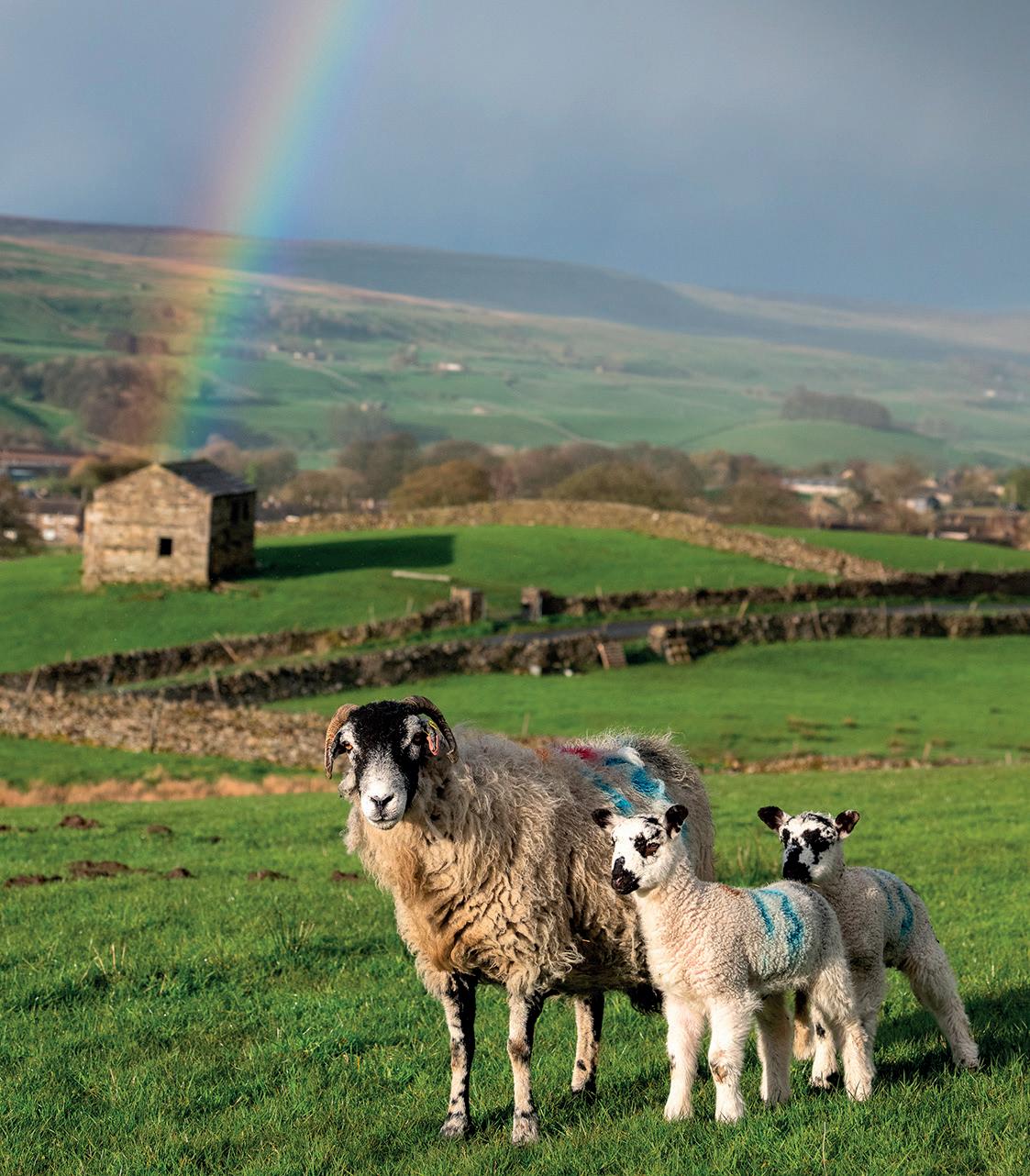


British farmers have to meet tougher assurance criteria than overseas competitors. See p14.

21 of classified ads starts after p35

With the focus on landlord-tenant relationships at the NFU tenant conference, farmers felt ignored and that bad practice must be called out. Rachael Brown reports.
r‘Despicable’ situation for some in Cumbria
FARMING Minister Mark Spencer has been accused of ‘brushing off’ what has been described as a ‘despicable’ situation faced by tenant farmers in Cumbria.
Farmers attending this week’s annual NFU tenant conference highlighted a ‘growing trend’ of large landowners and private landowners ‘intimidating, bullying and pushing tenants off the land’ to take advantage of Environmental Land Management (ELM) schemes and bring land ‘back in hand’ for inheritance tax planning purposes.
Cumbrian tenant farmer and representative at the Farmer Network, Jim Campbell, criticised Defra and the NFU’s lack of acknowledgement of the reality of the situation faced by tenant farmers in Cumbria.
Mr Campbell praised his current landlord, Church Commissioners, for its ‘collaborative and engaged approach’, adding some other large private landowners in Cumbria were ‘not willing to talk to or collaborate’ with their tenants.
Speaking at the conference, the Minister said while he ‘continued to watch closely and did not rule out future legislative options’, so far Defra had ‘not found any significant changes to areas of tenanted land or the area of land that is being used for food production specifically from ELMs’, adding he would ‘continue to monitor it’.
Mr Spencer said he wanted to make sure payments went to ‘active farmers not landlords’ and to create a system which ‘incentivised landlords’ to have farmers carry out the work.
The NFU has been clear, we see value in a commissioner, we want to see it be delivered
DAVID EXWOOD
“He has obviously not been to Cumbria. People are feeling so scared to put their head above the parapet,” Mr Campbell said, adding that tenants said they were fearful to speak out.
“It feels like he is just brushing it off. When I challenged the NFU about it, they said nobody is coming forward with this evidence and they brushed it off too. It feels like it is just an annoyance in the background.
“But it is not, it is people’s livelihoods and peoples’ lives.”
As one farmer summed up to the conference, there were ‘two sides to the story’ in the tenanted sector right now, ‘success and stalemate’. He said he had been left in the dark by his landlord.
Members heard from representatives from four big institutional landlords – the Duchy of Cornwall, Church Commissioners, The Crown Estate and the National Trust, who emphasised the importance of working as a partnership.
Head of rural at The Crown Estate, Malcolm Burns, said they were moving away from an ‘arm’s length

traditional’ landlord-tenant relationship. Land and estates director for National Trust Giles Hunt said they wanted to be a ‘good reliable trustworthy landlord’.
All four estates agreed while collaboration and communication were vital, none of them could ‘guarantee business viability’.
When asked by a Farming Community Network charity representative, what the estates were doing to protect farmers’ mental well-being through this challenging transition, they all agreed with its importance.
The Duchy of Cornwall emphasised it was a priority for the estate and Prince William, highlighting there was a dedicated funding stream for support and a phone line available.
Ciara Williams, principal rural asset manager from the Church Commissioners, said: “Farms are homes, families and generations, it is about understanding the problems and having those conversations.”
All four estates said they had em-
braced Defra’s new code of practice. But questions were raised at the conference on whether the code had enough ‘teeth’, with many members in favour of appointing a Tenant Farming Commissioner (TFC) to add ‘more weight’.
First generation Herefordshire tenant farmer Bill Quan said the code was not enough.
Mr Quan highlighted there was still a lot of ‘very sharp practice’ and people were cautious of calling out landlords.
“If you are a tenant farmer and call out your landlord and land agent, you could lose your farm,” he said.
But chair of the Farm Tenancy Forum (FTF), Julian Sayers, said the code ‘indirectly’ did have teeth.
Mr Sayers said: “When you get into a situation with an arbitrator, mediator or a court of law, the person sitting in judgement will now be looking to ask if the parties adhered to the code.”
But when probed by a farmer about
the ‘Del Boy land agents of the agricultural world’, he said while that was a ‘minority’, it was a problem that a code or legislation ‘would not solve’.
He added that ‘those who want to deal with things in a certain way will continue to do it’.
NFU deputy president David Exwood, who sits on the forum, said tenant farmers must not be taken for granted, and ‘collaboration between tenant and landlord’ was the future.
“The NFU has been clear, we see value in a commissioner, we want to see it be delivered and that is what I expect in the coming weeks,” he said, adding the principle and the value it offered was clear.
Mr Exwood alluded to the fact not everybody wanted to see a TFC introduced, but said ‘every tenant farmer would like to see one, which tells us something’.
The Minister stressed that he and his team were ‘examining the impact and the role of commissioner’ and would provide an update ‘very soon’.
TRADITIONAL farming practices could be under threat from landlords seeking to reclaim farmland, the National Sheep Association (NSA) has warned.
NSA chief executive Phil Stocker said they were hearing of an ‘alarming number of cases’ involving the loss of significant areas of land on five-year Farm Business Tenancies.
Mr Stocker said he was also seeing a ‘breakdown in traditional sheep farming and grazing practices’, with tenants often not having the opportunity to benefit from the schemes that land is being entered to.
Will Rawling, chair of the Herdwick Sheep Breeders Association and fifth-generation Ennerdale fell farmer, said many small, tenanted farms rely on traditional management, which he said had been ‘severely affected’ by Natural England requirements.
He said many were struggling to ‘remain viable’.
“We are finding our hefting system is at the point of collapse, due to people being forced to reduce stocking densities that are unsustainable in terms of maintaining a working hefting system across the National Park.”
Mr Sayers added the FTF had been looking at the Scottish TFC model, and said while they would not follow the model directly, they were looking at how it works, how it was set up and the cost of running it.
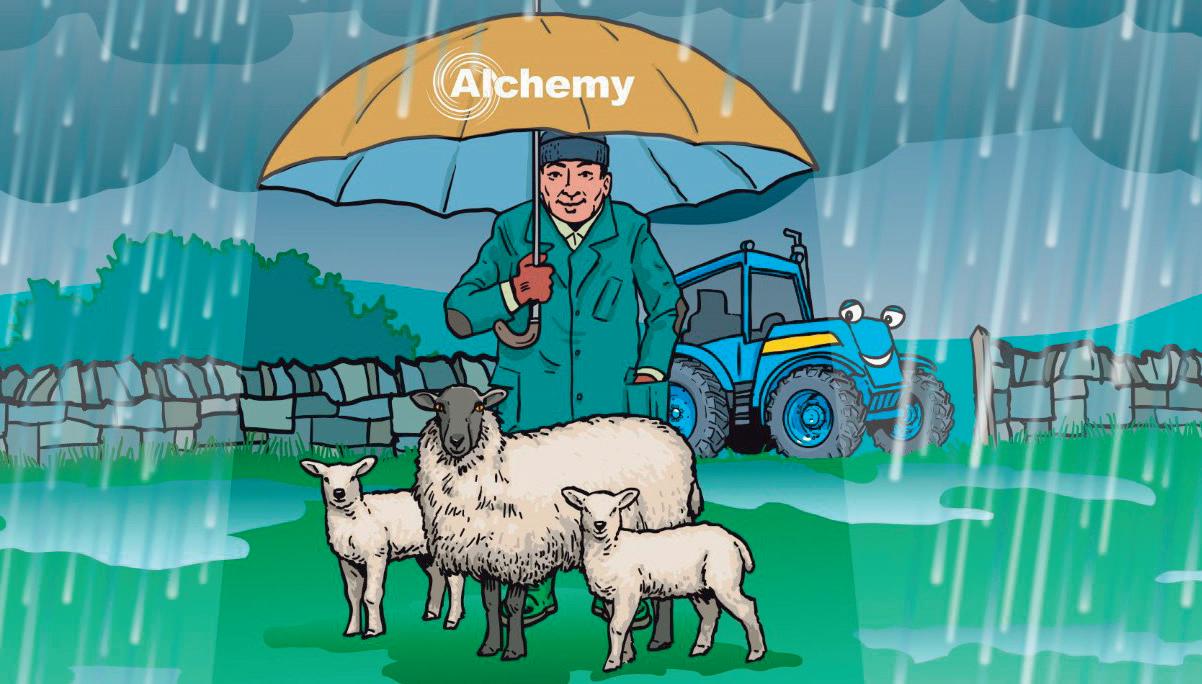


Farmers Guardian, Unit4,FulwoodBusinessPark, CaxtonRoad,Fulwood, Preston,Lancashire,PR29NZ
Editor
OliviaMidgley,07787240750
olivia.midgley@agriconnect.com
Head of News and Business
AlexBlack,01772799409
alex.black@agriconnect.com
Chief Reporter
RachaelBrown,07974039778
rachael.brown@agriconnect.com
News and Business Reporters
JaneThynne
jane.thynne@agriconnect.com
ChrisBrayford,07773110733
chris.brayford@agriconnect.com
Business Reporter
CedricPorter
cedric.porter@agriconnect.com
Arable Technical Specialist
AshEllwood,07786190188
ashleigh.ellwood@agriconnect.com
Head of Machinery and Farm Technology
TobyWhatley,07583054831
toby.whatley@agriconnect.com
Machinery Reporter
JamesHuyton,07787242185
james.huyton@agriconnect.com
Head of Livestock
KatieJones,07786856439
katie.jones@agriconnect.com
Features Editor and Head of Livestock Sales
AngelaCalvert,07768796492
angela.calvert@agriconnect.com
Livestock Specialists
EllieLayton,07814997407
ellie.layton@agriconnect.com
KatieFallon,07815003227
katie.fallon@agriconnect.com
ENGLAND’S local election results will likely be a key indicator of how political parties will perform on the national stage, with more than 2,600 council seats and 10 metro mayor seats up for grabs on May 2.
Labour has 45 per cent of the vote, with the Conservatives on 19 per cent, according to latest figures by YouGov.
Tim Bonner, chief executive of the Countryside Alliance, said: “There is a long history of voters making judgements on national politics when voting in council and mayoral elections. Although local issues will have some impact, the results are unlikely to contradict the trends recorded by national polling.”
CLA president Victoria Vyvyan said now was the time for policymakers to engage with rural communities with the countryside vote up for grabs.
with those of rural voters will give themselves the best chance of winning.”
He said the Conservatives were being challenged in the countryside by both Labour and the Liberal Democrats.
“In recent elections, the opposition parties have almost ceded rural seats to the Conservatives, but there has been a change of language and approach from the other parties in the last couple of years.
“If they continue to prioritise policies that will deliver for the countryside, rather than doing things to the countryside, then there will be all to play for with the rural vote.”
The forthcoming elections will also

KatieHaydock,01772799561
katie.haydock@agriconnect.com


“Candidates and parties who show commitment to, and ambition for, rural communities will pick up support at the ballot box,” she said.
Mr Bonner added: “The countryside will be a key battleground in both local and national elections this year and parties that align their priorities
From page 1
shesaid,callingforpeopleto worktogetherto‘developsolutions whichpreventpeoplespiralling intopoormentalhealth’.
RABIlauncheditsyear of‘EmpoweringtheWorthofWellbeingofFarmingPeople’initiative inParliamentonApril17,joinedby farminginfluencersandwithFarming MinisterMarkSpencerinattendance.
Butwithrecordtake-upforservices, farmerswerereallyfeelingthepressure.
AdamLewis,whogrowsspring oats,oilseedrape,beansandwheatin Leominster,Herefordshire,saidtime wasoftheessencetorectifya‘crisis’.
Hesaid:“Farmersarethemost resilientpeopleintheworld,butIam surethestruggleformanyfarming familiesgoingthroughthisseasonhas beendestabilisingforsomany.There
UNDERSTANDING the market, knowing the business’ unique selling points and having a plan in place, were key to making a success of diversification.
Warner’s Gin founder Tom Warner, speaking ahead of the Cultivate Conference, advised farmers looking at new ventures to do their research.
“Really understand the consumer demand for what you are doing in your area,” he said, giving the example
aregoingtobesomanylarger businesseswhichcanjustabout copewiththisleveloflosstotheir businesses,butitisthesmallfamily farmsIthinkaboutduringthesetimes.
“Onebadseasoncouldputanend totheirdreamsoffarming,whichis reallyconcerning,butsomanypeople havefaced18monthsofthis.”
Reduced harvest
NFUCombinableCropsboardchair JamieBurrowssaidcerealbusinesses facedtheprospectofareducedharvest thisyearwithsignificantreductions inincomeduetothelevelofrainfall.
JackWard,chiefexecutiveof theBritishGrowersAssociation, saidconsumersdidnotrealisehow luckytheywerethatfarmerswere continuingtogrowcropsduringone
Now is the time to engage with rural communities with the countryside vote up for grabs.

see metro mayors elected in several rural areas which have been created as part of recent devolution deals. Both Hull and East Yorkshire and Greater Lincolnshire will gain elected mayors, while extra devolved non-mayoral powers have also been announced for Lancashire, Cornwall and Surrey.
Jeremy Leggett, policy adviser at rural campaign group Action with Communities in Rural England, said it was about time countryside communities were given the political recognition they deserved.
“Nearly 9.7 million people live in the English countryside, equivalent to the population of London. But more often than not, they do not get the same attention from the Government as their counterparts in the city,” he said.
of someone with a good farm shop ‘down the road’ who would ‘dilute’ the market if they opened a shop. He added people needed to think about their value proposition and what type of business model they wanted to run.
For more from Mr Warner, listen to the podcast at farmersguardian.com/podcasts
oftheworstseasonsmanygrowers hadfacedintheirlifetimes.
WelsharablefarmerRichard Anthony,whomanagesmorethan 1,214hectaresoflandinBridgend, said:“Therehavebeensomany reasonswhyfarmersandtheir businesseshavefeltonthebrinkat themoment,butthisweatherhas beentheworstIhaveseeninmore than30years.Wehavealreadylost about60percentofourOSRandwe haveincurredincreasedcosts,such asbuying-inmorefertiliser,because wecannotspreaddigestateon-farm duetothewetweather.
“Itisleavingourlandinanawful conditionanditleavesmanyworrying aboutthedamageithasdonetosoil healthandourabilitytogrowhealthy cropspeopletakeforgranted.”














On your marks, get set, go!

Take the opportunity to test our Rotana round balers and Tigo forage wagons in action. Choose your favourite from over 30 models and see for yourself the performance and harvesting quality of Fendt green harvesting equipment. Request a demonstration from participating sales partners or at fendt.com/test-the-best24











rRelevant information needed from Defra
By Jane ThynneINCREASED methane measurement across all aspects of the livestock sector is required if the farming industry is to fully address the issue of emissions, industry experts urged this week.
Speaking to members of the House of Lords Environment and Climate Change Committee, in the first of a two-part inquiry into methane emissions, Rebecca Fisher, reader in atmospheric science at Royal Holloway University of London, Prof David Frame, of the University of Canterbury in New Zealand, AHDB special adviser Prof John Gilliland and Phil Bicknell, chief executive of the AgriTech Centre, agreed much more could be done to better measure methane calculations.
According to Ms Fisher, UK methane emissions from enteric fermentation stand at 841 kilotonnes, while manure management is responsible for 153 kilotonnes. She said 85 per cent of agricultural methane is from enteric fermentation.
However, Mr Bicknell said while the industry was very aware of the situation, much more now needed to be done to disentangle individual farm business figures from national calculations.
“There is a difference between


UK methane emissions from enteric fermentation stand at 841 kilotonnes, according to Rebecca Fisher.
the macro level – what we produce nationally versus what is relevant to a farm business. What is relative to my farm – how much methane are my livestock producing and how much is this down to my farm practices?
“I think at the moment, the ability to measure at the national level versus at the individual farm is the big disconnect. It is one of the major barriers that always comes up.”
Mr Bicknell added it was down to Defra to gather and provide farmers with more much ‘micro’ information which would in-turn encourage farmers to be more ‘pro-active’.
Prof Gilliland said cost was another barrier, and called on Government to provide farmers with more cost-effective technology.
“If we cannot measure we cannot manage,” he said, adding without a low-cost solution then it will be
really difficult for farmers to change behaviours and reduce methane.
DEFRA has removed its 150-metre limit from the Farming Recovery Fund in just 48 hours after it was heavily criticised by farmers who found they were not eligible.
Initially Defra said only farmland ‘within 150m of the midpoint’ of one of the rivers listed by the Rural Payments Agency, where there had been notably ‘high river level gauge’, would be considered.
But after farmers complained, including Lincolnshire farmer Henry Ward, who was left with
more than 810 hectares of land submerged, this criteria was removed.
Farming Minister Mark Spencer said: “We have immediately listened and responded to feedback on the launch of the initial phase of this scheme, fully removing the 150m limit. This means that farmers will be able to receive payments for all land parcels which are flooded contiguous to an eligible river.”
Defra said it will continue to look at ways to expand the scheme.
A CAMBRIDGESHIRE farmer has pleaded guilty to 16 animal welfare offences after being accused of failing to provide basic needs for his livestock.
Jack Smith who farmed cattle and pigs on land at Mill Hill Farm was given an 18-month conditional discharge and ordered to pay a victim surcharge of £26 following an investigation by Cambridgeshire and Peterborough Trading Standards.
Peterborough Magistrates Court heard despite officers from the body visiting the farm on a number of occasions and Mr Smith receiving exten-
sive advice from both Trading Standards and a veterinary surgeon from the Animal and Plant Health Agency, he failed to act, and that animals were kept in a hazardous environment and given an inadequate diet.
The court also heard farming practices were poor, and sick and injured animals were not housed appropriately with the necessary bedding or protected from pain and suffering.
Veterinary advice was also not sought within appropriate timeframes to enable animals to receive the care they needed.



















WALES’ bovine TB Technical Advisory Group (TAG) met for the first time this week, 21 months after it was first announced. The first meeting took place on April 17 following the announcement of the members of the group, but NFU Cymru and others have criticised the lack of any farmer representation.
As already announced, Prof Glyn Hewinson will chair the TAG. Welsh Rural Affairs Minister Huw IrrancaDavies said he had a wealth of knowledge and as Ser Cymru chair of the TB Centre of Excellence in Aberystwyth, he will be at the forefront of leading the group.
The members of the group are: clinical scientist and public health infectious disease epidemiologist Robert Smith; retired former head of the department of livestock health and welfare at the University of Liverpool David Grove-White; Aberystwyth University lecturer Gwenllian Rees; farm vet Sarah Tomlinson; Cardiff University professor of human geography Gareth Enticott; and veterinary sur-


The bovine TB Technical Advisory Group’s first priority will be to review the current on-farm slaughter policy.


geons Gareth Edwards, Ifan Lloyd and Sarah Woollatt.
Mr Irranca-Davies said the group had listened to the views of the farming community, with the TAG’s first priority to review the current on-farm slaughter policy.





In addition, following the recommendations of the Task and Finish Group, the TAG will also be inviting external organisations to give evidence to inform the group findings.
The TAG will meet quarterly and provide advice to Welsh Ministers through the forthcoming TB Programme Board.
In the interim, until the Programme Board is established, advice will come to the Cabinet Secretary via the Chief
THEREarenoplanstopausethe
rolloutofthecontroversialSustainable FarmingSchemeinWales,according toWelshRuralAffairsMinister HuwIrranca-Davies.
Veterinary Officer Richard Irvine. Shadow Rural Affairs Minister Samuel Kurtz said the length of time taken showed eradicating bTB was not a priority.
He said: “More of the same in bTB eradication policy is not an option, especially when across the border there has been marked success in the reduction of bTB.”
He added he hoped the TAG could ‘convince Welsh Government to follow the science’.
Hesaid:“Whatwehavetodo isrecognisetheneedforcertainty forfarmersandworkinthenextfew weeksandmonthstoputforward exactlywhereweare.”

Itfollowsmajorprotests outsidetheSeneddinFebruaryin responsetotheschemeandother WelshGovernmentpoliciesimpacting farmers.MrIrranca-Daviestoldthe BBC‘knottyissues’couldbeworked outandhewas‘seeingwhatother ideaswereoutthere’withregardsto farmsneeding10percenttreecover.
Hebrandedcallsto‘pause,stop orkicktheschemeintothelonggrass’ as‘theworstthingwecando’.
Tree cover MrIrranca-Daviesalsodismissed theideathatthe10percenttreecover issuecouldbecomeaproblemforthe LabourpartyinaGeneralElection. InFebruary,LabourShadow FarmingMinisterDanielZeichnertold Farmers Guardian UKLabourwould notbeintroducingasimilarpolicyin England,althoughhewasreluctant tocommentonWelshissues. No plans to pause Sustainable Farming Scheme

















What

NFU vice-president Rachel Hallos said the community throughout the Wye catchment ‘wanted to see it thriving’.

rAgriculture not the only problem
By Jane ThynneTHE Government’s new action plan to address pollution in the River Wye catchment has been broadly welcomed by farming groups, amid warnings agriculture is not the only industry which needs to clean up its act.
Farming Minister Mark Spencer last week unveiled a raft of measures, including requiring large poultry farms to export manure away from areas where they would otherwise cause excess pollution and the provision of up to £35 million in grant support for on-farm poultry manure combustors in the Wye Special Area of Conservation catchment to facilitate the export of poultry litter to where it was needed.
British Poultry Council chief executive Richard Griffiths praised the move and the support it would offer to poultry producers who were keen to manage soil and nutrients.
He said: “It reinforces responsibilities in supply chain management and emphasises the importance of enforcement of standards and regulation.”
Mr Griffiths also warned water quality was not solely the duty of the agricultural industry. He said: “The safe and effective use of fertiliser is a broader farming concern, and poultrymeat is just one voice in this conversation.
“We will continue to work with Defra and play our part in its action plan because poultrymeat businesses have a duty of care while manure is under their control. But river health is in everyone’s interest and is, therefore, everyone’s business.
“It requires collective action to promote environmental stewardship across all agricultural sectors.”
NFU vice-president Rachel Hallos also welcomed the action plan and said the union would now consider in detail its impact on the farmers in the area.
She said the community throughout the catchment cared about its future and ‘wanted to see it thriving’.
She added: “We recognise there are challenges for the River Wye, such as reducing levels of nutrients and farmers and growers have a role to play in restoring its health.”
However, the Soil Association said while the ‘belated’ action was positive, the proposal to shift manure from the Wye catchment would only bring problems elsewhere.
Soil Association campaign adviser Cathy Cliff highlighted its Stop Killing our Rivers campaign, which identified 10 further rivers in England and Wales ‘at risk from intensive poultry pollution’.
She said: “These rivers are already failing UK phosphate targets. The most certain way to avoid river pollution would be to stop intensive poultry units producing such large volumes of manure in the first place.”



Our essential products for grass silage:
• True uniform compounds for accurate application
• Sulphur up to 15% yield increase
• Potash for high demand silage crops
• Immediately available, reliable and consistent source of N
Olivia Midgley, Editor – olivia.midgley@agriconnect.com

And finally...
Entries are open for the British Farming Awards. Two of our 2023 winners share their thoughts and what the honours mean to them on pages 18-19.
ANALYSIS by AHDB lays bare the prescriptive nature of Red Tractor farm assurance when compared to the schemes of other major food-producing nations and exporters, such as Australia and New Zealand.
On the face of it, British farmers see more frequent expectations and greater bureaucracy, which obviously takes its toll.
Not only this, but the extra time filling out paperwork and cost swallowed up by the process chips away at assured farmers’ competitiveness.
As our letters correspondent Patrick Sleigh writes over the page, farmers already feel the current system is over bureaucratic and leaves them at a commercial disadvantage.
This is especially the case when their assured produce sits alongside that which is unassured, either domestically produced or imported, on the supermarket shelf.
The industry will eagerly await the publication of AHDB’s analysis on assurance schemes in Europe and Ireland and later reports on North and South America.
While new trade deals with Australia and New


Zealand are at the forefront of people’s minds, it is trade with Europe and the goalposts of its assurance which could matter most, particularly when considering the value of UK exports.
And rather than assurance being a hinderance, it may be mission critical to securing and growing these export markets.
We know UK farmers produce food to the highest quality and standards in the world, but they should not be penalised for this at home.
The scheme needs to find ways to bring value back to the farmgate or members will continue to feel disenfranchised.
The latest consumer research from the Royal Agricultural Benevolent Institution shows the public feel empathetic towards farmers and the strain many are under, but the market is the market.
In a spiralling cost of living crisis with wages not keeping up with inflation, consumers are voting with their feet and for many there is no choice other than to buy on price – no matter how loud or big the fanfare is around the high standards of British produce.
‘There is not a lot of place for sentimentality’
Conversation: Comingbackinto farmingafterpursuingacareerasa racingdriver,Ihavehadtogetused toaslightlystrangeconversationwhich Iamsuremanyofyouknowwell.
Yougotoanevent–beitamarket, showorploughingmatch–andyou areintroducedtosomeonenew.
Inthenormalworldyouwould shakehandsandintroduceyourself beforetheconversationmovedon.
Infarming,thingsseemdifferent.
Weshakehands,Isaymynameis Jonandtheotherpersonstaresatme blankly.Whattheotherpersoniswaiting forismy lastnameandwhereIamfrom. Insomeways,thisisquite charmingastherewillinevitably besomeconnectionalongthelines somewhereofknowingafamily memberorafarmbysomelandmark.
To the outside world it must be baffling.
Onecrucialpartofthisconversation is‘whatdoyoufarm?’.
Livestock: Eversincegettingmy firstcattleIhavethoroughlyenjoyed introducingmyselfasa‘pretend mixedfarmer’.
Ibelievemysmallnumberof cattleneverreallyqualifymeas atruelivestockfarmer.
Irecentlyconfirmedmy‘pretend mixedfarmer’statusasIsenttwo ofmyfirstcattletoslaughterlast month.Itmademeabitupset, whichIamnotafraidtoadmit.
Whenyouhavefedananimalthat looksatyoulovinglyeverymorning forseveralyears,havingarrivedonyour farmasaspindly-leggedandawkward calf,itdidfeelabittoughagreeingtokillit.
However,thereisnotalotofplace forsentimentalityinfarmingandIcan hardlyaffordtokeepapetcow.
Threeweekslater,Iwenttothelocal

butchers and they invited me into the cold room to see the carcases hanging up.
WithsometrepidationIagreed; seeingavarietyofbreedsintheprocess includinganenormousLimousin. This became so interesting by the time the butcher showed me a well-aged and marbled rib-eye on my carcase.
Ithinkfarmersaredisconnected
Watt
Woodbridge, Suffolk
Jon Watt, 27, is an NFU Student and Young Farmer ambassador, East. He works at his family’s beef farm near Woodbridge in Suffolk.
fromtheirproductsometimes.I certainlywasand,untilrecently, asagrowerofmostlyfeedwheat, Iamunlikelytohaveeatenanything Ihavepersonallygrown.
‘Farmtofork’issomethingbanded aroundalot,butitishavingcattle thathasreallyallowedmetoundertake thatjourney.
Appreciation: Thesheereffort involvedinputtinggoodfoodon thetabledeservesourappreciation.
MaybeinafewyearstimeIwill havegotusedtoitbutfornow,Iwill stillanswerthequestion‘whatdo youdo?’thesameway.
ALL farmers will certainly be welcoming the second review into Red Tractor and farm assurance.
Hopefully this exercise will be completely independent, fully transparent and will seek to address the many issues which our farmers are concerned about.
The effect on many farmers’ mental well-being while dealing with some inspectors and auditors of these schemes is shocking.
It is simply unacceptable that these audits have become ‘quality control’ and not ‘quality assurance’ schemes.
The founding fathers of these schemes (namely Maitland Mackie and David Jack) created quality assurance in order to create higher standards of production and to reward those producers who achieved.
Nowadays, as we all know, most quality assured Scottish producers receive more monies from the market by trading with England, and the Scottish label is irrelevant, despite all the hoops and hurdles suffered to achieve the Scotch Assured status.
Mackie and Jack never intended for these schemes to be so bureaucratic, time-consuming and stressful, but rather that they should be a very simple exercise to demonstrate that farmers are good at what they do and ensure that the market would pay a premium.
Sadly, the Frankenstein monster called quality assurance (but is actually quality control) has now evolved and is devouring us and wrecking our lives. Meanwhile, we are importing food products world-



If you have a classic picture you would like to share, please email it to marcello.garbagnoli@agriconnect.com ■ IF you would like to send us a letter for consideration, please note that our email address has now changed to fgeditorial@agriconnect.com Contact us

wide which are only required to meet the minimum import UK standard and frequently have lower standards in comparison.
Consumers, understandably more than ever, are price-driven and purchase mainly based on price and possibly presentation.
The assurance organisations have now become unaccountable, powerful and dictatorial organisations, offering little advantage to most producers. Do we need them?
This entire scenario can best be likened to the Post Office Horizon scandal where sub-postmasters cruelly suffered at the hands of uncaring, self-preserving people in high places. Many feel as if they are being treated no differently from the sub -postmasters.
Hopefully, James Withers and his team doing this review will see what we all see and make the right decision upon the future of these assurance organisations. Change cannot come fast enough.
Patrick Sleigh, Oldmeldrum, Aberdeenshire.ANOTHER very damaging blow to farmers’ finances has come from the wettest 18 months on record and the so-called Farming Recovery Fund brought in to help.
This is another example of Environment Agency (EA) incom-
petence. Why has it taken three months to start when the flooding situation was serious in January?
Why have the prescriptive judgements been made so restricted?
If poor, long-suffering Henry Ward in Lincolnshire, with totally submerged farmland is to get a tiny drop in the ocean, what hope do other fund claimants have?
He is to get compensation for only 24 hectares out of his total 810ha that are underwater.
How can Prime Minister Rishi Sunak say he ‘has farmers’ backs’ when he obviously does not care about farmland.
Suzanne Greenhill, Bishops Cleeve, Gloucestershire.
about how you use our site, for example, the type of device you are using, your operating system, IP address, uniform resource locator (URL), clickstream and length of visit. How we use the information you provide: We will use your personal information: • to administer the Competitions, on the basis that the use of your personal data for this purpose will be necessary to enter you into the competitions and, if you are successful, contact you to notify you of your prize; and, • if you are new to Farmers Guardian and where you have agreed to this, to provide you with news and updates from time to time about our services; and, if at any point in the future you do not wish to receive any news and updates from us or from, you can unsubscribe from our marketing list at any time by following the steps below. To unsubscribe from any communications using the link on the email we send you or by emailing us at dataprotection@farmersguardian.com. We will not use your information for any purposes except those listed in this policy without letting you know and getting your permission, if necessary, first. Who do we share your information with? We will not disclose your information to any third parties without your consent, except where:
• it is necessary to enable any of our staff, employees, agents, contractors, suppliers or commercial partners to provide a service to us or to perform a function on our behalf;
• we have a legal obligation to disclose your information (for example, if a court orders us to); or • there is a sale or purchase of any business assets, or where Farmers Guardian or any of its group companies are being acquired by a third party. Where we use third parties as described above to process your personal information, we will ensure that they have adequate security measures in place to safeguard your personal information. For how long do we keep your personal information? We keep your personal information for 36 months for the purposes for which it was collected or for any period for which we are required to keep personal information to comply with our legal and regulatory requirements, or until you ask us to delete your personal information. Your rights: You have a number of rights in relation to your personal information. These include the right to: • find out how we process your personal information; • request that your personal information is corrected if you believe it is incorrect or inaccurate; • obtain restriction on our, or object to, processing of your personal information; • ask us not to process your personal information for our own marketing purposes; and • obtain a copy of your personal information which we hold about you. We will take steps to verify your identity before responding to your request and will respond as soon as possible and in any event within a month. If you would like to exercise any of your rights or find out more, please email us at dataprotection@farmersguardian. com. Complaints: If you have any complaints about the way we use your personal information please contact us at dataprotection@farmersguardian.com and we will try to resolve the issue. If we cannot resolve any issue, you have the right to complain to the data protection authority in your country (the Information Commissioner in the UK). If you need more information about how to contact your local data protection authority please let us know. Contact us: Please read this policy carefully and if you have any questions, concerns or comments about this policy or, specifically, how we might use your personal information, please contact us by email at dataprotection@farmersguardian.com.
Almost 8,000 Young Farmers will flock to Blackpool over May Bank Holiday for the DIY AGM. Ellie Layton speaks to YFC member, John Houseman, who established the event.
rYoung Farmers urged to take a break
By Ellie LaytonTHOUSANDS of Young Farmers will head to Blackpool on the May Bank Holiday weekend (May 3-5) to attend the DIY AGM which has replaced the former National Federation of Young Farmers’ Clubs (NFYFC) AGM.
The event in both forms has been the highlight of the YFC social calendar for more than 50 years.
Formerly taking place between the North West and South West of England in alternate years, in 2019 it found its home in Blackpool under the umbrella of the DIY AGM, organised by the Young Farmers Community.
The DIY AGM was founded by John Houseman, who comes from a mixed livestock farm in North Yorkshire. Mr Houseman studied agriculture at Askham Bryan College, near York, before attending Harper Adams University. A keen member of the Yorkshire Federation of Young Farmers’ Clubs, he enjoys competing at rallies and getting involved in his home club.
He said: “I would encourage anyone to join their local club, the organisation has been invaluable to me; I have learnt a range of skills and met friends for life.”
Following the cancellation of the NFYFC AGM in 2018, he decided to resurrect it by creating an unofficial

■ FGLiveYoungFarmers Conferencewilltakeplaceatthe WinterGardens,Blackpool,onMay 4,2024.Forthefullagendaandto registerforyourfreeplace,visit farmersguardian.com/fglive-agm24
event on Facebook. It has grown over the years and, this year, Farmers Guardian will host its inaugural FG Live conference on day two (May 4), with a seminar programme packed full of inspirational speakers and farming influencers.
The annual weekend away typically falls on the early May Bank Holiday, when Young Farmers from England, Wales and Scotland descend on Blackpool for what is known as a ‘post-lambing and -calving holiday’, giving Young Farmers and like-minded individuals a break from the farming calendar.

To listen to the full interview, scan the QR code below.



Mr Houseman said: “The main aim is to keep an annual event going where Young Farmers from all over the country can come together and enjoy time off, have fun and meet new people.
“Working in agriculture, people are often tied down in quite isolated positions with long hours and very little time away from the farm. There are few industries like agriculture where you work with family, and I think this gives a nice break from the pressure cooker of living and working with the same people day in and day out.”
A major focus of the Young Farmers Community is raising money for charity, and since 2019 the group has raised more than £20,000.
Mr Houseman said: “The money is raised through ticket sales and customised polo shirts which have personalised slogans. These considerable donations have been split between





various charities which are in the interest of the farming community, such as the Air Ambulance UK and Mind, but also local non-profit organisations such as the Blackpool Royal National Lifeboat Institution.”
In the first year, more than £7,500 was raised for charity, and since then, there has been as much as £16,000 donated in one year.
Due to the growth of the event, Mr Houseman is assisted by two business partners, Alex Huckerby and Sam Hargreaves.
“We work behind the scenes to bring the event together, with all of us providing different skillsets. This is not a non-profit organisation as we do make money by providing merchandise,” he added.
“There is a great deal of work that goes into the organisation, which incurs serious costs to produce the entertainment, staging, lighting, insurance and event promotion. We are incredibly grateful to be supported by various agricultural sponsors, including Farmers Guardian.
“I believe we are doing a good job of running the DIY AGM; we have seen successful attendance numbers and have built it up over the last few years to get it to where it is today.
“People enjoy the weekend, so we plan to make the event bigger and better in 2024, and we look forward to seeing everybody there.”
CAMPAIGNERS staged a national rally in Westminster this week in a bid to protect food production and natural habitats from industrial-size solar farms. Organised by UK Solar Alliance (UKSA), the action was in response to the growing number of 50MW-plus solar parks which are being proposed across swathes of UK farmland.
The alliance said the Parliament Square event was a chance to get its ‘20 questions’ – covering issues such as why so many speculative bids for land are being allowed to take place and what checks are present to ensure no utility scale solar installations come at the cost of home-grown food – in front of politicians.
Event organiser and vice-chair of UKSA Karen Squibb-Williams said: “There is not enough being done to check who is behind the solar schemes. At the moment these proposals are just PR noise talking about sheep grazing under panels and more insects – there is no real investigation, no research, no data management.
“It is all very well saying ‘we are only
taking a small piece of land’, but what if that piece of land is the only one in which we grow most of one particular crop. No-one is looking at this and it is time they did.”
The group has also launched a petition calling on Defra to introduce ‘new restrictions on solar facilities to protect land and food security’.
It has three main aims: to prohibit ‘mega solar facilities’ over 50MW on UK farmland; establish solar development preference hierarchies and regional density caps to help protect our natural landscapes; ensure food security; and conserve biodiversity.
A spokesperson for the Department of Energy and Net Zero said the Government was actively encouraging the ‘deployment of solar’ on brownfield sites or low agricultural grade land while financially encouraging


A petition has been launched calling on Defra to introduce ‘new restrictions on solar facilities’.

the incorporation of solar into farm infrastructure.
The spokesperson added: “Solar and farming can be complementary, benefiting each other both financially and environmentally. In some cases, solar farms can increase the local abundance of bees, birds and butterflies, which are essential for pollinating crops and improving biodiversity.
We are providing grants of between £15,000 and £100,000 for farmers towards solar equipment which can be fitted on rooftops and float on irrigation reservoirs, helping increase energy resilience and take-up of renewable energy generation on farms.”
Go to uksolaralliance.org












BRITISH Wool has confirmed it will no longer be using the L.E. Jones site from this year, with two new sites announced for the delivery of wool, both based in Denbighshire.
Billy Hewitson, head of operations, said: “We thank all at L.E. Jones for their hard work and service to members over the last 15 years.
“Looking at the area and the service to members, following a detailed review, we have decided to offer two new sites, one at Bathafarn Farm near Ruthin and one at agricultural merchants Corwen Farmers in Corwen.
“This will hopefully make things easier and more convenient for our members when they need to drop their wool off with us.”
A BEDFORDSHIRE egg producer has announced it will phase out colony cage egg production by 2028 as part of a new multi-million-pound strategy.
The British Lion-accredited Bird Bros said it was shifting to barn egg production at its Sunny Farm headquarters to strengthen its range of higher welfare products.
Stuart Bird, production director at the company, said: “As we look to the future, barn eggs will have a significant role to play.
“We want to be among those leading the charge in moving away from colony cage production.”
The move marks a strategic shift for the family-owned business, which has been producing eggs since 1969.

Red Tractor was consistently found to be prescriptive, containing more detail than other schemes.



farmers have to meet ‘more prescriptive’ and detailed requirements for farm assurance as well as more frequent inspections, compared to key international competitors New Zealand and Australia.
The first of four reports evidencing

current competitive English farmgate production standards for the beef and lamb sector have been released by AHDB.
The independent report was delivered by Birnie Consultancy and independently reviewed by experts.
It compared the most broadly used schemes of Red Tractor (RT), Australia’s Livestock Production Assurance (LPA) and New Zealand Farm Assurance Programme (NZFAP).
When directly compared, RT achieved higher scores than the LPA and NZFAP schemes in most areas, with the only exception being biosecurity and disease control.
RT was consistently found to be more prescriptive, containing more detail than the other schemes.
However, the report emphasised this does not necessarily indicate a scheme is sub-standard, as practices and requirements varied between countries and customers had different needs.
It also highlighted there were areas of potential improvement for every scheme in all categories measured.
RT audits are the most frequent, conducted in-person every 18 months, with NZFAP in-person audits required every three years. LPA does not publish inspection frequency.
Differences between the schemes
often stemmed from their focus, with RT designed to meet requirements in the domestic market, while the others were created with export markets in mind.
Production differences were also highlighted on areas such as housing and vermin control, with RT having more of a focus on these due to the use of housing in the UK.
Will Jackson, AHDB divisional director, said: “Together, these four reports will deliver clear evidence to support crucial discussions for the beef and lamb sector, including the impact of standards on farmgate returns, the involvement of the wider supply chain in conversations about future standards, and maximising value from higher standards when it comes to market access or higher prices.”
He added that the work would provide important evidence, such as for the recently announced independent Farm Assurance Review.
He said: “It will also be central in helping AHDB to underpin our messaging in key areas, such as marketing and exports.”
Future reports will focus on key EU countries, North America and South America.
































TESCO has become the latest UK retailer to launch a ‘Best of British’ section on its website.
It becomes the seventh major retailer to launch British sections since a campaign was launched last year by Conservative MP Luke Evans.
It comes as Ulster Farmers Union president David Brown criticised Tesco, after comments that its surge in profits was on the back of ‘price pressures’ easing.
He said this must not lead to a further correlation on the prices paid to farmers, which remain under pressure from aggressive retailers despite rising costs on farms.
“The retailer is taking no risks, while farmers struggle with costs, weather and the incessant pressure from retailers on their margins,” he said, adding an effective food chain ‘depends on fairness and these figures confirm that does not exist for farmers’.
POOR weather has helped stabilise the dairy markets, keeping demand steady while keeping a check on seasonal milk production.
That was the message from Steve Bradley, a milk price analyst with milkprices.com, who added this was on the back of farmers being frustrated by wet weather.
He said: “With the number of milk price increases announced pre-spring flush, buyers would have been rubbing their hands together at the potential opportunity through Q2 of being able to ratchet downward pressure on markets prices. All that was needed was the catalyst of a good early spring.
“However, things are certainly









not turning out as buyers might have expected, and while the physical challenges on-farm are currently increasing by the day, the dairy market situation could be somewhat more negative had Mother Nature blessed us with a decent early spring.”
While the cheese market was not performing better than any other, certain milk buyers for cheese were ‘doing their best to try and keep their suppliers’ morale from sinking deeper by trying to show they were investing in their supplier milk pool moving forward’.
He said: “This is especially the case in competitive milk fields, such as in the South West.”
Estimated GB milk deliveries in March totalled 1,086 million litres, only 0.1 per cent down on the same month last year, according to AHDB.



With March completing the GB milk season, adjusting for the
leap year, there was a comparative year-on-year decline of 0.5 per cent seen on 2022.
AHDB livestock analyst Becky Smith said: “This is the lowest milk-year volume recorded since the 2016/17 season.”
The decrease in production could be attributed to lower yields per cow, with producers not incentivised to push production by lower prices and high input costs.
The wet weather will be impacting dairy farmers at present.
Ms Smith added: “We expect to see subdued production as the wet ground delays turning out cows onto grass, with some concerns about the ability to carry out groundwork and the potential knock-on effects on grass and silage quality for the coming season.
“This is reflected in the latest forecast as a marginal decline is expected in GB milk production for the 2024/25 season.”


EXCEPTIONAL grain prices helped Frontier achieve a ‘record performance’ in 2023, but highlighted market challenges in a volatile environment.
During the period ended June 30, the grain marketing businesses’ earnings before interest and taxation grew to £51.2 million, and profit on ordinary activities after taxation also increased to £31.9m.
In 2023, 41 per cent of earnings were realised from Frontier’s ‘outputs’ business, which comprises grain trading and handling operations, with 55 per cent from its ‘inputs’ business.
It highlighted that grain markets experienced high volatility and unpredictable trade flows due to the ongoing conflict in Ukraine, resulting in an exceptional and rapid rise in grain prices.
This allowed the company to hedge new crop grain contracts for customers at both ends of the supply chain, with healthy crop gross margins also enabling UK farmers to buy higher volumes of crop protection products.
In 2023, Frontier said it approved £14.7m for capital expenditure in the core business.
It also emphasised its investments in start-up subsidiaries and joint venture enterprises, including farm banking services via Oxbury Bank and farmgate data analytics via Yagro.
Since the year end, Frontier announced the start of successful production from its joint venture business, Navara – Europe’s largest oat processing mill.

During the period ended June 30, 2023, Frontier’s earnings before interest and taxation grew to £51.2 million.
But it said there were challenges ahead, with wet weather and flooding impacting crops and grain markets remaining turbulent, plus added volatility from the war in the Middle East.
Mark Aitchison, group managing director, said: “We are a highperforming business that remains focused on continuous improvement and strategic investment in relevant capabilities and services that add value to our customers across our supply chain.”
He hailed the company’s ability to achieve results in challenging conditions.
Diana Overton, deputy group managing director, said that as well as its financial credibility, the
AGRICULTURAL machinery business Balgownie and Balgownie Rentals has been sold to MacGregor Industrial Supplies (MIS) after entering administration earlier in the year.
The sale included both its Inverurie and Turriff sites, and preserved 15 jobs at the 117-yearold business.
Richard Bathgate, of joint administrator Johnston Carmichael LLP, said they were delighted to have sold the business and assets.
He said: “Balgownie is a well-respected name and long-established brand that provides machinery to
the agricultural, construction and groundcare industries in the north of Scotland.”
Managing director of MacGregor Industrial Supplies John MacGregor added: “This acquisition is in line with our mission to grow MacGregor Industrial Supplies and we believe customers will benefit as we continue to strengthen our product and service capability throughout Aberdeenshire and the MIS branch network.
“It is our goal to continue providing the highest level of customer service during this time and in the future.”
business had also showcased its ‘strengthening commitment to sustainability and environmental, social and governance considerations’.
“These are increasingly important to our supply chain customers as well as our employees and farming communities,” she added.








The winners of 2023’s Farmers Guardian Farming Hero Award opened the doors to the farm more than 30 years ago in 1989, with millions of people now having passed through their gates.
Roger Nicholson and his sons Richard, David and Rob run the farm and attraction and have also featured in TV programmes including Springtime on the Farm, The Yorkshire Vet and flagship Channel 5 programme The Great Yorkshire Show.
The farm in Barnsley, South Yorkshire, is home to a farm shop, adventure playground, a reptile house and hosts special events throughout the year, as well as a working farm.
Their commitment to educating consumers as to where their food comes from and the role British farmers play has helped bridge the gap between the public and agriculture.
On winning the award, Roger says: “We were absolutely delighted.”
He says it was great to be recognised, especially alongside previous winners Jeremy Clarkson and Kaleb Cooper.
David adds they were especially pleased to have their friend Kelvin Fletcher there, of ITV’s Fletchers’ Family Farm, when they won the award, adding as a new entrant he really showed how farming was ‘good for the soul’.
Since winning the award, the family say life on the farm has ‘no let up’.
“There is always something else creeping up,” Roger says.
XCannon Hall Farm is a 51-hectare (125-acre) working farm which is open to the public
XBased in Barnsley, South Yorkshire



Sponsored by
The Nicholson family at Cannon Hall Farm have been connecting the British public with farming via their television appearances and directly on the farm. Alex Black finds out more.

He adds some of the highlights include selling a Dutch Spotted sheep for 16,000gns.
“We are busy lambing at the moment, which is taking everyone’s focus. We have opened a new playground.
“Hopefully it will be really well attended by children.”
In the coming months, the family are looking to attend many of the major agricultural shows.
Rob says: “We have some really good livestock. It gives us an opportunity to spread the message, celebrating everything which is great about farming.”
With the farmers interacting
XThe farm includes a shop, cafe, an opportunity to meet the animals, an adventure playground and seasonal events
with the general public every day, Rob says farming does have a ‘good reputation’ and there is a lot of positivity towards farming.
He adds: “We get a lot of people coming to us because they have nostalgia about farming. Maybe their relatives were farmers, or they used to play on a farm as children or in a village.
“But you cannot live on goodwill alone. It has to be translated into better returns.”
Richard highlights school visits
XFor more than 100 years, our innovative roofing solutions have been helping farmers improve animal welfare, boost profits and future-proof their businesses. With increased focus on improving animal welfare and farms’ profitability, there has never been a better time

to the farm and how they strive to ensure they have a positive effect on the children, which helps to shape their views on British agriculture.
Rob says while the family have obviously created a hugely successful diversification, he believes farmers should be able to make a living from the core farming business without necessary diversification. He says: “That is what most farmers want.”
to upgrade or invest in new farm buildings. And we are here to help whatever your farming focus. Our roofs are specifically designed for the needs of British farmers.
Tenacity, resilience and overcoming the odds are some of the traits which have laid the foundations of Alex and Emily Crawley’s business as new entrant farmers. Chris Brayford reports.
Alex and Emily Crawley are clear examples of doing everything within their power to make a dream become a reality, and rightly being rewarded with the fruits of their labour.
Winning the British Farming Award was the first step into transforming their careers in the farming industry.
At the time of being nominated and winning the New Entrants Award last year, they had managed 0.97 hectares (2.4 acres) of rough pasture land which had no fencing, no livestock and no water while working other jobs away from the farm.
Now they manage 81ha (200 acres) in St Briavels in the Wye Valley to become full-time farmers and to live their dreams.
Earning their stripes for hard work and valour to win the award provided a platform for their ideas and business to grow.
Their award-winning business, Grazing Management, which supports landowners and managers in reaching their conservation grazing needs by restoring grazing land back into work production, was established in 2018 as the first foot in the door to building a career in farming.
Overcoming challenges to reach this point has been a
X91-hectare (200-acre) farm with native Belted Galloway and Traditional Hereford cattle breeds based in Gloucestershire
XWorks in partnership with landowners and land managers to deliver biodiversity improvements
key focus and a sign of their commitment.
Gaining work experience in farming from farmers, who were willing to give Alex a chance to fulfil his dream after a career in the Armed Forces as a veteran in the Afghanistan conflict, was a pivotal turning point in his career.
He also quotes farming as helping to manage a posttraumatic stress disorder diagnosis in 2017.
Together, Alex’s experience of conservation grazing and Emily’s knowledge of environmental management has provided the vital ingredients for a successful, rewarding and fulfilling career.
Alex says: “For any new entrant, trying to build a career in farming without the skills and experience can be extremely difficult.
“The strength and dedication we have demonstrated day in and day out is testament that with belief and determination, any dream can be achieved.
“Not only has the award elevated the standing of our business, but it has also built our confidence and reputation among those in the farming community.”
Alex remembers the first day he received the news about earning a land tenancy after winning the British Farming Award.
He says: “I have never felt so
on Sites of Special Scientific Interest, peat bog restoration and invasive non-native species management
XUses NoFence geo-collars, which gives the farm greater flexibility than U-fencing to graze areas such as common land
Sponsored by

ecstatic as I did when I could see my farm for the first time. We are now living our best lives and we feel very proud to call ourselves farmers, which was helped massively by winning the award.
XFrom its factories in the United States of America to China, Massey Ferguson represents an impressive brand which provides an impressive line-up of agricultural machinery, consisting of tractors, harvesters, materials handling, compact grounds care equipment and hay tools. Winning more than 30 prestigious

“I cannot wait to be a judge for the New Entrant Award this year and help progress someone else’s journey into farming. Helping someone achieve their dream like we did will mean so much to us.”
awards over recent years, including the Farm Machine of the Year Award in 2023 for the Massey Ferguson 5 S tractor, the company continues to deliver world-class products for farmers across the world.
RAINFALL across Europe’s key production regions could impact UK wheat imports this season, with large areas of western, northern and parts of eastern Europe facing similar issues to the UK.
According to AHDB, crop conditions have been driven downwards in major producing countries including France and parts of northern Germany.
AHDB trainee analyst Ella Roberts said: “FranceAgriMer reported last week that the state of French soft wheat this season is the poorest
since 2020, when similar weather patterns were seen.
“As of April 1, 65 per cent of French soft wheat was rated as being in good or excellent condition. This was down from 66 per cent a week earlier and down 93 per cent compared to the same point last season.”
With poor winter and autumn conditions, reliance upon spring planting weighed heavily on French farmers.
Barley sowing has accelerated after a slow start, but remains well behind the five-year average. Last year, the entire crop had been planted at this point. In Germany, a key source of milling grade wheat, record levels of precipitation were seen from November 2023

Crop conditions have been driven downwards in major EU producing countries due to rain.
until mid-February 2024. This resulted in flooding in many key regions, putting stress on winter crops.
However, many crops were expected to be resown in spring, making up for some of the winter losses, with rainfall back to usual levels in late February and March.
Ms Roberts added: “Given that the UK has also experienced continued wet weather this season, it is likely that our requirement for imported wheat will be historically high in 2024/25.”
It was likely much of this would be
milling standard, which typically comes from Germany and Canada.
“Though given the volume of feed wheat in the UK at the moment, and the fact that feed wheat imports compete with maize, it is likely that much of what we will import will be of milling standard, with German condition a key watchpoint.
“If the quality of German wheat suffers even more due to ongoing rains, we could see UK milling premiums strengthen further. Though as it stands German wheat is still pricing into the UK and imports remain firm,” she said.
Farmers Guardian delivered directly to your door every week including full digital access. Plus, check out our brand-new features exclusive to Farm Futures members.







A one membershipyear is only

£289


Insight – Quarterly, in-depth, analytical reports into the latest agricultural trends. Recent topics include, diversification and low carbon agriculture Exchange – A series of digital events focused on learning from real case studies and exchanging knowledge with agricultural thought leaders Weekly Digest email – From the desk of FG’s editor every Sunday morning, discover exclusive insights which impact the business of profitable farming Members’ Lounge – Enjoy an exclusive space for members to network at leading events, such as LAMMA, CropTec and Farm Business Innovation.
Spreading the risk among various on-farm enterprises has been a winning strategy for Staffordshire-based Lower Drayton Farm. Chris Brayford reports.
Developing a multitude of diversification projects has been the pillar of a Staffordshire farm’s attempts to grow and sustain a business.
Father and son duo, Raymond and Richard Bower, are behind the ever-expanding business at Lower Drayton Farm, based in the village of Penkridge, Stafford.
Raymond’s parents, Jim and Doris, farmed 177 hectares (437 acres) of land at Hatherton Hall Farm in Staffordshire. His father grew up at Mansty Farm in Penkridge, which the Bowers had rented in the 1920s.
When Lower Drayton Farm was purchased in 1982, it was anything but the operation it has become today.
The 132ha (325 acres) of land has been revolutionised into a £1 million indoor and outdoor farm attraction.
Over a 40-year period, the farm has welcomed new income streams from self-catering holiday accommodation, a soft play centre, a maize maze, Lambing Live event, pick-your-own pumpkins, airsoft, paintballing and more.
Farm diversification at Lower Drayton Farm started in the 1990s for the family with funding which helped them to host Open Farm Sundays.
Richard says: “Back in the 1980s, the farm was very much traditional in the sense of growing crops such as potatoes, going to livestock markets and selling beef cattle.
“In 1998, we were early adopters


of Countryside Stewardship which enabled us to fence off our river, plant trees, sow grass margins and start
thinking about educational access on the farm.
“We had a grant for our first


on the farm, to give people a first-hand flavour of what we do and how hard we work in order to grow our businesses.”
He says he remembered a talk he attended where they were encouraged to create income streams from all sectors of the economy – primary, secondary and tertiary – to spread the risk.
“Farming and Countryside Education was very supportive in the early years and, in 2008, Lower Drayton Farm undertook its first Leaf Open Farm Sunday and grew a summer maize maze on the farm.
“From 2008 to 2015, the maize maze grew into a fun farm in a field location and attracted 30,000 visitors per year.”
Mr Bower says that more than anything, diversification had been the result of having an open mind.
He says: “It has been rewarding in so many ways to create a stream of income to enable us to think of more ideas and ways to improve the farm experience.”
As well as live lambing and pickyour-own pumpkin experiences, the main diversification at Lower Drayton Farm has been the building of its farm




park including an adventure barn, several cafes, a play-zone activity centre and up-close animal experiences.
“The Brexit referendum result in 2016 was the catalyst to diversify and invest heavily into a new purpose-built farm park with soft play, cafe, animal zone and outdoor play,” Mr Bower says.
“It took us three years to get planning permission and then two years to build.
“Our launch date was August 15, 2020, during Covid-19, which was equally daunting as we were living in unknown territory for many who had never experienced anything like it.
“However, the farm received some welcome news when the then Prime Minister Boris Johnson had said soft
plays could open again shortly after. It was a godsend.”
Financial backing has also played a ‘pivotal’ part of the success behind Lower Drayton Farm.
“The farm park cost £1.8m to build and we received funding from various sources, including a £107,000 grant from the European Union, £20,000 from the Frank Parkinson Agricultural Trust and a bank mortgage to cover the rest after selling 650 cattle in a farm sale,” he says.
“We always find the bank supportive as long as you are not asking them for 100 per cent of the cost via a loan.”
The farm includes a paintball site, a field for a model aeroplane club, clay









pigeon shooting, phone towers, a care farm to provide mental health and well-being courses for the local community, plus an anaerobic digestion plant producing enough biogas for 7,000 homes in the area.
Around 150,000 people per year visit the farm, from ‘all corners of the globe’ says Mr Bower.
He says: “More specifically, around 6,000 customers visit during the lambing season, 10,000 for Easter, 20,000 for our summer Dino Discovery maize maze, 25,000 for pick-your-own pumpkins and 10,000 for Christmas.
“We have 1,000 members, 208
schools visited us last year and we had 200 birthday parties.”
“Depending on which days, we can generate £8.50 to £16.50 per adult and child who come to visit the farm and all it has to offer on day ticket sales.”
However, the trials and tribulations of implementing an idea are never straight-forward or easy in return for the additional cost it generates.
“The pressure of diversification comes at a price on labour and increasing the number of full-time staff with the relevant skills to deliver the projects day-in and day-out,” he adds.


Energy costs were highlighted as a challenge, made more difficult through the cost of living crisis.
“But diversification and turning those ideas into a reality has helped make the farm even more sustainable in the long-term, so we can overcome additional costs which arise over the years,” he says.
Looking to the future, the business has gained planning permission for a children’s day nursery to add income during the week in term time.
“We have phase two plans approved to extend the playbarn. The weather has taught us to create as





“I would not look back after making the switch to EASYFIX Dairy Housing Solutions, just seeing how comfortable & content the cows are, a picture paints a thousand words"
much weatherproof space as we can and to identify new areas of possibility.
“We have to keep evolving and seeing potential.”
Mr Bower adds the family did have disagreements about specifics, but they ultimately came to an agreement on what was best for the farm and customers. Farming still plays a key role in the farm business.
“Our business thrives from our personality as farmers and our ability to connect with people,” Mr Bower says, adding the success was also testament to their ‘fantastic staff’.
He says the farm is an opportunity to showcase their business to the world, with livestock producing milk for the vending machines and Lambing Live growing the connection between the public and farming.
“Another way we have diversified on the farm is the way we grow our crops by embracing regenerative farming through direct drilling and using sheep to graze our arable crops.
“This year we will only use 3.6 tonnes of man-made bag fertiliser to grow our crops.
“The rest of our crops’ nutrition comes from organic fertilisers, mainly digestate and manures.”






■ The Toon family farms a total of 259 hectares (640 acre) across two farms, Lower Grounds Farm and Birdsgrove Farm, both of which are tenancies of the Okeover Estate, Ashbourne
■ The Okeover herd of Albions totals 22 animals, of which 12-14 are in the milking herd and the remainder are kept as sucklers; the Okeover pedigree herd of North Devons totals 40 pedigree cows and there are around 140 black and white dairy cows on the farm at any time
■ Between 16ha (40 acres) and 20ha (50 acres) at Birdsgrove is drilled to either spring barley or brassicas as both crops make a good entry to a grass reseed
■ Richardfarmswithhiswife,Anita andtheirson,Arthuranddaughter, Libby,alsohelpout;theyemploy FrankieHardyasherdswomanand twoex-dairyfarmers,RodneyStanley andRichardGreen,asreliefmilkers
■ Allthefieldwork,including cultivations,silage-making,muck andslurryspreadingandharvest, iscarriedoutbylocalcontractors, includingStephenGullifordwho hasundertakencontractingworkat LowerGroundsFarmfor50years
■ ThefarmhasbeeninaHigher-Level CountrysideStewardshipagreement formorethan12years
A traditional approach to dairy farming is paying off for a first generation tenant farmer. Chloe Palmer reports.
Richard Toon’s experience in the dairy sector spans 40 years and it is this experience and knowledge which has paved the way for the sustainable farm business he runs today.
Since arriving at Lower Grounds Farm 22 years ago, he has followed a set of guiding principles and his enthusiasm for his cows and the business is evident.
He says: “Progress is always viewed
as a positive, but I think we can dip back into the past and pinch the better bits. For me, farming is the whole picture and it is about having the cows to fit the farm and not the other way round.”
Describing himself as the ‘oldest first generation farmer around’, Richard always wanted to be a farmer so began his career freelance relief milking and driving a cattle wagon.
“I worked part-time for a farmer and on his retirement he rented 75
I look at it from a commercial perspective; these cows [Albions] have to be a good fit and they must give a return because they are not hobby cows
acres to me. A few years later I was offered another 110 acres near where I lived, also from someone I worked for.
“We were taking in dairy heifers to rear for other farmers and trying to build our own suckler herd at the time.
“I heard the tenancy at Lower Grounds was likely to come up and so put in a bid for it and in November 2001 my wife, Anita, and I found out we had secured the farm.
“We moved there in March 2002 and we thought we had cracked it as all the land was ring-fenced. But this was only the beginning,” Richard says.
He was not in a position to buy-in much stock, as prices were very high in the aftermath of foot-and-mouth, but he eventually built up numbers to around 100 continental cross sucklers and 350 ewes. Alongside the farm he ran a small mineral and feed business and then started to collect and deliver wool from local producers to British Wool in Bradford.
As he reached his half century, Mr Toon was offered the parkland on the Okeover Estate and this signalled the start of his love affair with North Devon cattle.
He says: “The parkland was unimproved and unimprovable. We knew the continentals would not do well there, so we bought four in-calf North Devon cows.
“They fit in well to their surroundings and are aesthetically pleasing and will run on the parkland all summer and do well. They are quiet, so safer to graze on land with public access.”
Shortly after this in 2016, the Toons were offered a neighbouring former dairy farm on the estate and this signalled a major shift in direction for the farm.
“We realised it was no use faffing about with beef cattle on a farm with this quality of land and we knew that after the Brexit vote, the Basic Payment Scheme would be disappearing.
“Added to this, we had suffered occasional bovine TB breakdowns and we




were struggling to sell youngstock. We decided to swap the continental suckler cows for dairy cows,” Richard says.
Around that time, dairy processors were competing for new producers and the family secured a constituentbased contract with Cheshire-based cheese manufacturers Joseph Heler. Richard says: “All we needed was a start and that is what Joseph Heler gave us. We bought a second-hand parlour for £2,000 and had it refurbished and installed.
“On October 1, 2018, I milked nine cows at Birdsgrove and sent 285 litres
to the dairy after two days. At the time we were milking Friesian black and whites and we continued to buy-in more and added a few Jerseys and cross-bred grazing types.
“I read an article about Albion cattle and how they were native to Bakewell but were becoming endangered.
“I liked them and then saw some advertised for sale on the society website from Colin Nankervis’ herd on the Cornish coast.
“Colin told us his cows were very
milky and they were used to a hard farm and we decided to buy 12 cows and a bull unseen.
“In 2021, we purchased another 14 Albion cows from John Ball in Sandbach and while they were very different, they fitted in well.
“We find the Albions are cheap to keep and easy to look after. I look at it from a commercial perspective; these cows have to be a good fit and they must give a return because they are not hobby cows.
“They must be true to type, good milkers and easy calving. I want cows

which I have an interest in because milking is routine and the Albions provide some variety.
“I appreciate the breed needs to be maintained but we need to breed quality. I make a better job of things which I like doing, even though I like all cattle.”
Since the first day of milking more than five years ago, Richard has built up the herd to around 140 cows, of which 100 will be milked through the parlour at any one time. Of these, there will generally be around 12 to 14 Albions and they typically yield between 5,500 and 6,000 litres per year compared to the herd average of 7,200 litres.
Richard says: “They typically do six or seven lactations, so lower our replacement rate. They are fed silage and fodder beet with the other milkers, but a lesser quantity of cake in
the parlour. Dry cows receive a little rolled barley and beet pulp, and silage to appetite.
“All milking cows are given a coarse dairy blend, with silage fed to appetite and they receive an 18 per cent cake in the parlour. No replacements are reared but cows are purchased in-calf from the south and south west of England through herd drafts and dispersal sales.
“Our cows are turned out all-yearround for at least some of the day, and in the summer they are out fulltime. We like to leave them out as long as possible, but we have respect for the land, so in mid-winter we scatter fodder beet on a stubble field and turnout there.
“We bring the dry cows up to Lower Grounds Farm when we dry them off so we can keep an eye on them and
they go back to Birdsgrove as soon as they have calved. Calves are left on their mothers for up to 36 hours to ensure they receive enough colostrum and are then fed whole cows’ milk.
“We wean at between eight and 10 weeks and only retain the pure-bred Albion heifer calves. The Friesian cross Albion females are marketed locally and any other beef cross calves are sold through the Livestock Link Marketing Group.”
Making the most of all the ground across both farms is Richard’s aim. After the very dry summer of 2018 when they ran short of grazing at Birdsgrove, he bought another second hand 10:10 herringbone parlour for £100.
“We had it refurbished and it was installed at Lower Grounds, so now we


can milk 50 cows here and better utilise the grazing at this farm. The Albions will go out on our steepest ground here and thrive,” he says.
The North Devon cows, bought initially for the parkland, have become an important asset and registered pedigree females now number 40 plus followers.
“I think North Devons are the South West’s best kept secret. They are very quiet, good to handle, they have excellent conformation and easy fleshing comes as standard.
“We have several cows which are between 10 and 12 years old and still calve on the dot. They have a very dense coat and cope well with bad weather and they thrive on the parkland.
“We keep nine or 10 females each year and make the cut very early and only register these animals. If we do not think animals are good enough as a breeding animal, we will sell them as stores at Sedgemoor market.
“Repeat buyers often retail meat boxes and they are looking for Devons to make up their orders because they know what they are buying and how to feed them for the right end product.
“The Devon will typically finish at between 500-550kg liveweight which is ideal for direct selling,” Richard says.
As he approaches retiring age, Richard shows no sign of slowing down and appears as energetic as many people half his age.
He adds: “We would like to remain here as long as we can while we stay healthy. Every time we have some money to put into a property of our own, another opening comes along and we always seem to follow farming.”
Anita, a freelance riding instructor, agrees.
She says: “We have weighed up the chances each time and taken the opportunity and it has paid off.”
rSeed rates down compared to last year
By Jane ThynneDESPITE the wet weather continuing to dominate both the farming and national news headlines, growers in some areas are pushing on with their spring drilling as planned.
Rory Craig is based on the family’s 400-hectare farm in Hatfield, Hertfordshire, and has so far managed to drill about 75 per cent of the expected amount of spring oats, with the remainder planned to go in the ground over the coming days.
Mr Craig says that in total, at least 24ha of failed winter wheat would be redrilled, alongside 150ha of planned spring cropping.
He says: “We started off quite high in terms of seed rates, as it was quite a late campaign to start with and the short window we have had has meant we have stuck with that.”
Owing to the prolonged wet weather this year, the team had not undertaken any of the usual pre-drilling cultivations.
He says: “We have been punching it straight into the top because we did not want to risk pulling it up and mak-
It is a familiar tale here in the North West, with ongoing rain continuing to hamper farming operations.
It is not the amount of precipitation which is causing problems, but its consistency. We have hardly had a dry week since last June and there are still puddles in fields pretty much everywhere.
The backlog of work is building and it is going to be a case of doing what we can when we can.
Another main topic of conversation is the Sustainable Farming Incentive

ing the situation worse when we are working in such small windows. We have repurposed our non-direct drills to turn them into direct drills – one being a Vaderstad Rapid and the other a Kverneland TS Tine Drill, which is not ideal but seems to be doing the job.”
In Stone, Staffordshire, Andrew Court has managed to plant all of the planned spring oats and is now waiting to plant a crop of sunflowers.
The family grows winter wheat and spring oats for human con-


sumption, and spring peas and winter barley for animal feed.
Mr Court says: “There are wet patches all over the farm and the wheat struggled a little bit, but we are a lot better than many of our neighbours so we cannot complain.”
He adds seed rates were down compared with last year and, as a regenerative farm, pre-drill cultivations had been kept to a minimum.
“We generally decide on a fieldby-field basis. I have been told that every drop of rain falls with a pressure of 60 psi, so because our cover crops are a little bit sparse or have died, the rain has had a terrific effect on the compaction in the top layer of soil.
“So, we have had to cultivate where normally we may have got away without doing so,” he says.
with Simon Nelson

(SFI) and which options to use. Legume and herbal ley options are the main contenders and most will be slot-seeded or direct-drilled.
Care will be needed to optimise establishment and secure the benefits on offer, both financial and agronomic. Drilling should be delayed until June to August, when the growth of the ‘host’ grass crop slows down. The grass should also be defoliated by grazing or cutting, so seedlings have a chance to grow.
Perennial weeds, such as docks and thistles, must be controlled before these SFI mixtures are drilled, as it will not be possible to treat herbal leys afterwards.
However, do bear in mind that nearly all herbicides have a no-sow period following application, up to three months with clover.
Winter crops are now growing away as temperatures rise. Unsurpris-
ingly, hybrid barley and rye are approaching growth stage 32, but, at the time of writing, ground conditions will not allow a sprayer or fertiliser spreader in the field.
All winter barley will receive an application of Jaunt fungicide as soon as possible, together with a growth regulator and manganese as necessary.
Wheat will need a fairly robust T1, particularly if earlier drilled, as septoria is evident on lower leaves and will soon spread up the plant through rain splash.
I usually advise applying all nitrogen on winter cereals by April 20. If you get the chance, apply whatever is left to go on.
I doubt 10 per cent of the planned spring cereal area has been drilled yet. We do not have a cut-off point up here; a lot of crops are destined
 Simon Nelson
Simon Nelson
for wholecrop or home feeding, and our damper climate and longer day lengths help later-drilled crops maintain potential. I would emphasise that all fertiliser needs to go into the seedbed at this late stage.
Maize drilling is a test of patience. The key is waiting for the right conditions – the crop will grow a lot faster drilled into a good seedbed than muddled in.
With hybrid oilseed rape varieties still popular among growers, seed breeder Elsoms Seeds advises growers to consider new conventional varieties which can offer high yields while displaying similar levels of vigour. Farmers Guardian reports.
Growers and agronomists are being advised to reconsider new conventional oilseed rape varieties in variety selection planning based on their targeted special traits, agronomic merit scores and shorter breeding cycles, confirms Elsoms OSR breeder Mark Nightingale.
Mr Nighti ngale, who has bred OSR for more than 20 years, has seen a significant rise in popularity of hybrid varieties in recent years, based largely on their reputation for enhanced vigour. However, he now feels that the arrival of new conventional, open-pollinated variety types can offer high yields while displaying similar levels of vigour.
Mr Nightingale says this new offering could encourage growers back towards conventional varieties.
He adds: “Although rape prices are currently lower than in recent years, we still annually import 1.5 million tonnes of oilseeds into the UK, so market demand is still strong.
“As a breeder, my role is to ensure that growers have all the right tools to grow the crop successfully and that includes utilising new breeding techniques to produce conventional varieties which can not only match hybrid varieties, but actually outperform them in many areas, including higher yields.”
Many breeders can breed new
The current trend towards early establishment has prompted growers to become overly reliant on overyeared seed which tends to be less vigorous
conventional varieties faster than hybrids, meaning the cost of conventional OSR seed is often much lower, according to Mr Nightingale.
“That can make a significant difference when it comes to lowering upfront costs and mitigating risk when it comes to establishing OSR,” he adds.
Despite many strong economic and agronomic arguments for conventional varieties, there is little doubt they have been overlooked when it comes to OSR variety selection.
“Currently no-one has bred a variety that is resistant to cabbage stem flea beetle [CSFB] and the current trend towards early establishment has prompted growers to become overly reliant on overyeared seed which tends to be less vigorous, regardless of whether it is a conventional or a hybrid variety.
“In order to combat the threat of CSFB, Elsoms are selectively breeding new varieties that can cope with much higher larval loads. And, because breeding cycles for conventional open-pollinated varieties are much quicker than for hybrids, we have found that OP varieties can adapt to this selection pressure much quicker than when breeding hybrids,” says Mr Nightingale.
This recent advancement is just one element of a wider risk mitigation strategy for growing OSR more successfully, linking in with establishing OSR after the CSFB migration period to minimise larval damage and the use of new, later applied OSR herbicides.
“Focusing specifically on Elsoms’ new conventional varieties, we have Powerhouse, Firebird and Hallmark, all currently in AHDB Candidate trials and each offering UK OSR growers something specific to suit their needs.
“Powerhouse has high seed yields, Firebird combines a high gross output with built-in turnip yellows virus [TuYv] resistance and Hallmark offers diversity in genetics to the other two varieties, with a high oil content and excellent verticillium resistance,” he says.
Beckii Gibbs, seed manager for
Many breeders can breed new conventional varieties faster than hybrids, according to Mark Nightingale.


United Oilseeds, also calls for a rethink from growers on their future use of conventional varieties.
She says: “While there has been a definite trend towards hybrids in recent years, it is also fair to say that there has always been a strong place for good conventionals.
“Many consistently successful OSR growers that I talk with grow both as part of their selection strategy –although Mr Nightingale’s points about there being no resistant variety to CSFB with both hybrids and conventionals equally susceptible to larval damage are entirely valid.”
Stacked traits in hybrid varieties
are good, but only if growers are experiencing issues with those resistances.
“If growers [are not having issues], then [they] do not need them and there are certainly some exciting conventional varieties with targeted special traits out there for growers.
“I see agronomic merit scores as an excellent, farmer-friendly way of comparing varieties when combining yield, oil content, lodging and disease resistance into one figure,” adds Ms Gibbs.
UNUSUAL weed species being spotted in winter cereals are causing concern among growers and agronomists, prompting questions about whether typical spring herbicide programmes will be effective.
Hazel Blanshard, product manager at FMC, says that there are a number of weeds which have established in the unseasonably warm and wet conditions that some growers have not historically seen in such high populations.
Ms Blanshard says: “Willowherb, corn spurrey, lesser celandine and coltsfoot are being reported as unexpected and out of place this year.
“Volunteer beans, while not that uncommon, are also causing problems, as are larger than expected populations of groundsel.
“The reasons we are seeing greater populations of these weeds is
threefold. Firstly, the lack of autumn residual herbicides applied in some areas; certain weeds favouring germination in wetter soils, and finally, the relatively high soil and air temperature over the winter.”
In most cases these weeds are still relatively small and at a growth stage where control remains relatively straightforward.
None of the unusual species reported so far should cause a headache, as long as herbicide strategies are managed correctly, she says.
“Most of these can still be successfully controlled with metsulfuron-based products, with better and more consistent control achieved with metsulfuron and thifensulfuron, or metsulfuron and tribenuron coformulated products.”
For those who were tackling volunteer beans, Ms Blanshard recommends tank-mixing SU herbicides with a hormone herbicide to provide better control of the bigger plants.











Volunteer beans, while not that uncommon, are also causing problems within cereals this season.
If weeds are large, using higher dose rates is advisable, she adds.
“Maintenance of water rates and correct nozzle choice, combined with a reasonable forward speed, should always be a high priority, but this year it may also be




key to achieving the best results. Speaking to your agronomist and following product labels is always important to ensure successful weed control is still achieved and a good quality crop is harvested,” she says.
















Cover crops are one way to increase diversity on the farm and can potentially install multiple benefits both above and below ground.
Dr Tracy Valentine, research leader in plant:soils interaction at The James Hutton Institute, says: “These benefits include adding carbon and nitrogen to the soil, improving soil structure, capturing nutrients and passing them to the next crop, and reducing weed burden, depending on the specific cover crop species or mixture grown.”
In Scotland, winter cover crops are established after the main crop harvest in August through to September and are grown through the winter season before being destroyed, usually by frost, herbicide or mowing, she adds.
Climate change projections of Scotland’s weather include an increase in average temperature across all seasons, with warmer and drier summers and milder and wetter winters.
However, there is still significant local variability in both temperatures and rainfall event patterns across the different months of the year.
Dr Valentine says: “These variations could have several impacts on cover crop implementation. For example, while projections suggest that central eastern areas of Scotland will become warmer, it also projects it to be much drier in the August-September cover crop sowing window, potentially affecting germination rates.
“Further north, the projections become much more uncertain, but
the issue of quickly fading light for plant growth will still remain whatever the weather brings.”
Farm management interactions and cultivation techniques also affect the success of cover cropping.
Data is being collated from two The James Hutton Institute trials, including a multi species trial and the long-term Grieves House Tillage Trial (GHTT), both situated at Balruddery Farm, near Dundee.
So far, the data is highlighting that during the 2022-2023 growing season, cover crop biomass produced (measured in March) in the GHTT was significantly lower in the no-till plots than in the inversion plough plots for both radish and rye cover crops sown. The reduction was recorded at more than 50 per cent between the two cultivation methods.
Dr Valentine says: “Cover crops within no-till systems are key approaches to climate change mitiga-

Cover crop trials in Scotland highlight up to 50 per cent above-ground biomass reduction when comparing minimumtillage with ploughing.

Multiple cover crop trials in Scotland are highlighting changes in above-ground biomass due to the changing weather patterns. Ash Ellwood reports.
SCOTTISHGovernmentfunded‘CropImprovementfor SustainableProductionina Changingenvironment’andthe ‘HealthySoils’projectareexploring thedifficultiesinestablishingcover cropsunderdifferentclimatic conditionsandunderdifferent managementconditions.
tion, through reduced fuel and attempts to increase carbon sequestration. So, while biomass is only an indicator of cover crop success, reduced effectiveness in these systems of cover crops species is important information.
“Data gathered on responses to management will be combined with seed germination metrics, plant temperature and light growth data in models which link to climate change projections for different regions in Scotland, to help assist the uptake of cover crops,” she adds.
As pressures to attain net zero mount, Gareth Whatmore, project partner at Drone RePeat, speaks to Ash Ellwood about the carbon storing and alternative income stream opportunities that could be presented by UK peatland.
Peat is the UK’s single largest carbon store, with about three million hectares of peatland across the country.
According to the UK Centre for Ecology and Hydrology, the UK’s peatlands store around 3.2 billion tonnes of carbon.
However, those same peatlands are estimated to emit around 23.1 million tonnes of CO 2 into the atmosphere every year, largely due to degradation and draining.
Gareth Whatmore, project partner at Drone RePeat, says peatlands are a unique natural resource and are often not given the attention they deserve.
“Peatlands form distinct ecosystems that act as a carbon sink, so the degradation of these important landscapes comes with serious environmental impacts,” says Mr Whatmore.
“But, if we can find ways to protect and harness these landscapes, we can maintain this important resource for future generations, making a significant positive impact on the UK’s net zero aims, all while opening up new income streams for landowners.”
So, how do we balance these sometimes conflicting interests and could technology-enabled paludiculture, or farming on re-wetted peat, be part of the net zero solution?
Mr Whatmore pointed to Government targets which are aiming to restore some 280,000ha of peatland in England by 2050.
“[This will] Make it easier to manage these landscapes, and make it economically attractive for landowners to do so,” he says.
Paludiculture allows for the profitable production of wetland crops.
“An example is typha [bullrush], as it has many potential uses such as a building material, bioenergy crop and in clothing.
“Sphagnum also has potential in agricultural, biomedical and industrial chemical applications; while food crops – such as bilberry, celery, cranberry and nettles – can


also be cultivated in these environments,” says Mr Whatmore.
While cultivating or restoring peatland is often difficult due to its inaccessible nature, the use of drone technology could be a solution.
He says: “Growing berries in peatland requires fresh thinking around how they could be sown, grown and harvested in a landscape that can be difficult to access.
“Drones can offer both air spray [for sowing] and crop monitoring [for growing] capabilities, making the process far less time-intensive and increasing economic viability.
“Landowners can be easily trained to use spray drones, meaning this method can grow and be widely adopted at scale.”
The key focus is on crops that can be grown on wet peat soils and, ideally, be manufactured into net zero products such as clothing or construction materials.
“This is where it becomes gamechanging technology, to not only help landowners manage delicate landscapes, but also open up new income streams while helping
them become peat net zero or negative,” adds Mr Whatmore.
Drone technology supports the wider system of aerial surveillance needed for active peatland management and the validation of data around peatland through remote monitoring of dipwells.
Members of the SEAD Artists consortia are actively developing solutions for the end-to-end cycle and have already obtained the first permissions to spray via drone in the UK, according to Mr Whatmore.
“They have also secured approvals and delivered the first Beyond Visual Line of Sight flights in England and Scotland, including for drones carrying heavy payloads.
“This means the capability is there to fly drones safely over longer distances, opening up opportunities to trial the technology at scale,” he says.
In addition, through DronePrep’s Ordnance Survey and HM Land Registry-backed platform, access to Hartpury Agri Network and the Natural England Paludiculture Fund, a good proportion of major peat land-
lords in the country have now been identified, so work can now begin to create airspace approvals.
“If the country’s peat landowners take on the challenge, calculations suggest the potential carbon gains will effectively make the drone flights neutral, enabling this innovative approach to achieving net zero,” Mr Whatmore adds.
“In short, the arrival of new technology means the environmental, commercial and economic potential of paludiculture development is now huge. Once our peatlands have degraded, they can take centuries to re-establish.”
Drone RePeat is a project funded by Natural England’s Paludiculture Exploration Fund, visit: paludiculture.org.uk and seadartists.com for more information.

rPre-sale champion sells for 5,000gns
A NEW centre record of 10,000gns was set at the sale of dairy bulls on behalf of the Border and Lakeland Holstein Club at Carlisle. This was for Whinnow Gateway,
AT Wharfedale spring lambs sold to 519p/kg and £210/head from R.M. Gray, Langbar selling to Shan’s Group, Ossett.
Hoggs topped at 514p/kg for Nick Asquith, Moor Monkton, selling to Shan’s Group and to £237/head for J.J. Dalby and Sons, selling to J.B. Wilkinson and Sons, Rawdon.
Cull ewes sold to £180/head for continentals from Freddie Harrison, West End, selling to Shan’s Group, with Mules to £120 and horned ewes to £95.
Richard Stevenson, Farnley, topped the prime cattle at 330.50p/ kg and £2,122/head with a steer which sold to Messrs Wilkinson, and also topped the culls with a continental at 201.50p/kg and £1,541/head to Harry Thompson, Gargrave.
Auctioneers: Wharfedale Farmers Auction Mart.
THE sale of ewes and lambs at Carlisle on Monday topped at £138/life for a pair of Texel shearlings with single Beltex lambs from Caleb Todhunter, Greyrigg House, Wigton, who also topped the Mule ewes with twins at £92/life and the hoggs with lambs at £128/life.
Aged ewes with lambs topped at £131/life for Neil Comish, Wigton, who also sold Hampshire ewes and lambs to £128/life. Dorset ewes with lambs sold to £95/life for F.R. Dotchin, Brampton.
Auctioneers: Harrison and Hetherington.
an October 2022-born British Friesian bull by Carrickshock GTW from the Blamire family, Thursby.
The maternal brother to Beaufort Milkman, whose dam by Rodbrook Barney is one of the breed’s
highest production cows which produced more than 14,000kg as a six-year-old cow, sold to the Tincknell family, Somerset.
The Blamire family also had the top average of £7,875, which included 7,000gns for Whinnow Journey by Lakemead Jingle. It sold to Messrs Adams, Stranraer.

The judge, Jimmy Baillie, Lanarkshire, awarded the pre-sale show championship to Warnelview Karma, a son of Dropbox from Kevin and Chrstine Wilson, Thursby, which sold for 5,000gns to Messrs Tiffen, Penrith.
The reserve champion, from the same vendors, was Warnelview Navigate by Davinci, which sold for 6,200gns to the Allen family, Whitchurch.
The Warnelview herd sold another 10 bulls to average £5,176.
28 bulls, £4,155; 21 Holstein bulls, £3,865; 7 British Friesian bulls, £5,025.
Auctioneers: Harrison and Hetherington.
THE Cholmondeley herd of Holstein Friesians was dispersed onfarm over two days on behalf of Chris and Claire, Willis, Malpas, topping at 2,600gns twice.
This was for a February second calver by Optimal giving 52kg out of a 12,379kg Nadal dam, which went to a Pembrokeshire buyer and a Medley-sired March second calver selling to a Shropshire buyer.
A late February-calved daughter
of Boghill Glamour Damian, out of a 11,671kg Promis dam, sold for 2,500gns and two March second calvers sold for 2,500gns.
October-calved
Also at 2,500gns was an Octobercalved heifer by Applejax and back in-calf for October to Westcoast Retrolook.
In-calf heifers calving in May sold to 1,950gns for a Mystic daugh-
ter off a 11,417kg Promis dam. Bulling heifers peaked at 1,250gns and yearling heifers sold to 920gns.
AVERAGES
416 milking cows, £1,752; 83 cows with faults, £1,065; 47 in-calf/served heifers, £1,507; 24 bulling heifers, £949; 124 yearling heifers, £586; 34 heifer calves, £170.
Auctioneers: Gwilym Richards and Co with Market Drayton Market.
THE sale of 350 store cattle at Bishops Castle peaked at £1,900 for a 500kg Limousin heifer from Bowen and Bowen, Penthryn, which also topped the per kilo prices at 425p.
Steers sold to £1,770 for a British Blue steer from S.J.C. Morris and Sons, Craven Arms, and 360p/ kg for three Limousin cross steers from H. Jones, Dinas Mawddwy.
The pre-sale show championship went to a pen of 525kg Limousin steers from Messrs Morris, which sold for £1,695/head.
Limousin steers
Runners up were Messrs Bowen and Bowen, with 410kg Limousin steers which made £1,460. E.J. and G.M. Trickey, Caersws, secured the top two heifer prizes
with 420kg and 400kg Limousins at £1,330 and £1,250. Feeding bulls sold to £1,800, £1,770 and £1,690 for I.E. and M. Gittins, Brooks.
Steers, 308p/kg and £1,440/head; heifers, 228p/kg and £1,325/head; feeding bulls, 343p/kg and £1,515/ head; overall, £1,400/head.
Auctioneers: Halls.


r44 bulls forward average £3,612

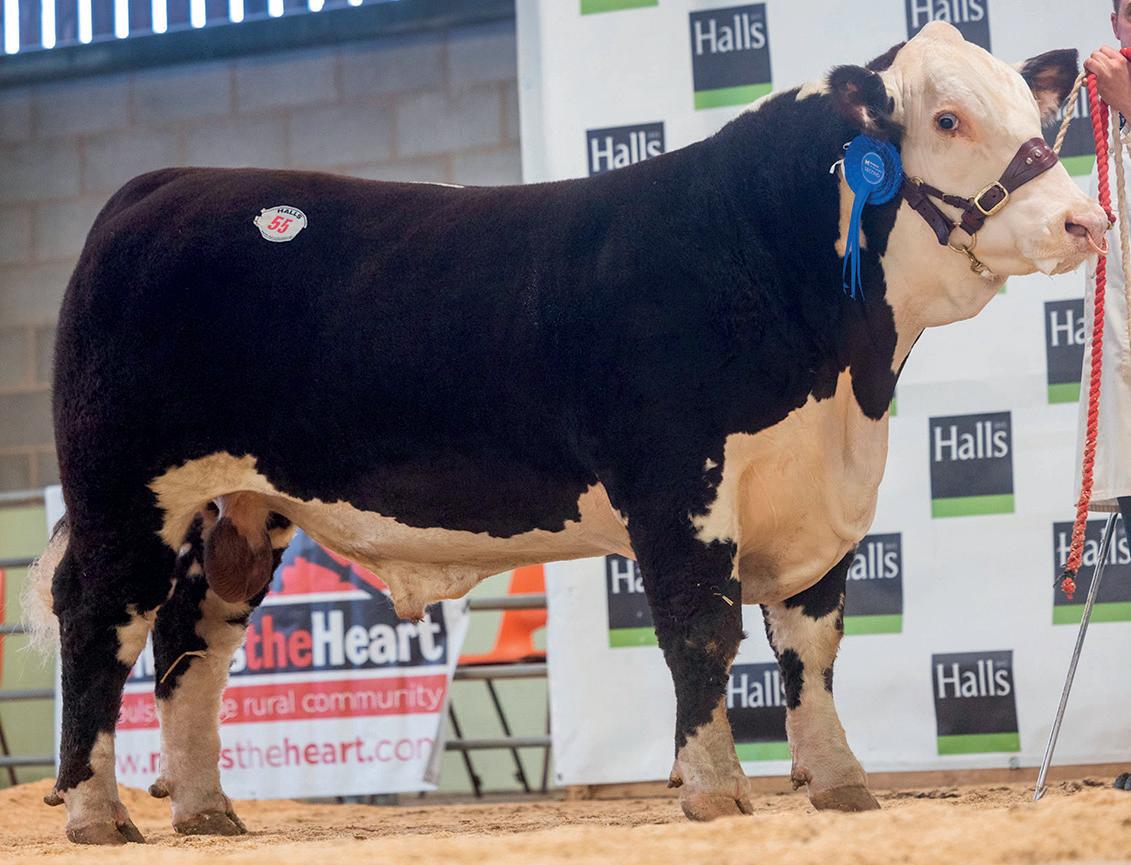
Ludgate,
1 Socrates S509 out of Fisher
Consigned by breeder M.
1 Cherry N431
to Andrew

Thomas, Llanelli, who is establishing a Hereford herd.
Next, at 6,300gns, was Romany 1 Avatar FR A22 by Fabb 1 Rocco out of Romany 1 Ishbel H12 M33, from Robert Wilson and family, Kelso, which was knocked down to Highridge Farm Partners, Oxted, Surrey.
From the same home and by the same sire, Romany 1 Ali-Price FR A41 sold for 4,600gns to H.A. Colburn and Son, Cheltenham.
Will Medforth, Llanrug, Gwynedd, then sold Penryhyn 1 Watchman, a son of Gouldingpoll 1 Stockman out of Sky High Miss Staffordshire, for 5,000gns to J.H. Morris and Son, Craven Arms.
At 4,900gns was Panmure 1 Apollo by Romany 1 Thor FR T4, from J.M. Cant and Partners, Angus, which went home with R. Williamson, Nantwich.
Females sold to 6,400gns for the champion, Harveybros 1 Crocus Aurora by Sky High 1
Take-a-Chance, out of Harveybros 1 Crocus Tiara, from father and daughter team, George and Sophie Harvey, Glasgow.
Having been junior female champion at Agri-Expo and overall junior and reserve native interbreed champion at Stars of the Future, it was knocked down to Vaughan Farms, Hereford.
The reserve female champion, Harveybros 1 Crocus Ariel, from the same home, sold for 5,300gns to Bethan Hutchinson, Cleveland.
Making 5,800gns from Messrs Cant was Panmure 1 Plum W9, a daughter of Romany 1 Thor FR T4, which sold to F.J. Wood and Sons, Devon.
AVERAGES
44 bulls, £3,612 (68 per cent clearance); heifers, £3,533.25 (67 per cent clearance); overall, £3,592.31. Auctioneers: Halls.

rPedigree British Blue bulls sell to 5,400gns
THE East Midlands Limousin Club show and sale at Melton Mowbray topped at 7,000gns for the pre-sale show champion, Calogale Topgun, a Meadowrig Pedro son out of Trueman Florence, from G.J. Lee and C.M. Lloyd, Carmarthen. The buyer was J.B. Thompson, Stainby.
Making 5,100gns was Woodmarsh Ubelter, a January 2023-born son of Sympa out of Wilodge Romance from M. and J.C. Gould, Shrewsbury. It sold to S.J.S. Loveless, Dorset.
First prize winner, Stain Tornado, by Powerful Irish, consigned by T.J. Denby and Son, Alford, sold for 5,000gns to K.D. Walker and Hollyberry Tarzan by Mereside Lorenzo,
from A. and V. Brown, Selby, made 4,500gns.
The female section topped at 3,800gns for Calogale Primrose, a 2019born cow by Bernish Memphis, from Messrs Lee and Lloyd. It sold with a bull calf at foot and in-calf to Meadowrig Pedro, to D.N. Burbidge Farms, Market Harborough.
The female champion, Brockhurst Teagan, from W.J. and M. Mash, Chesham, sold for 3,500gns to Lowesby Farms, Leicester.
Two-year-old heifers from Messrs Mash topped at 2,800gns for Brockhurst Unique, by Shaws Rover, with Brockhurst Sassy, by Baileys Mercedes, at 2,700gns and Brockhurst Talulah, a Burndale Orlando daughter, at 2,100gns.
THE coloured dairy breeds show and sale at Skipton topped at £2,310 for the reserve champion Jersey, Regatta Video Craze Jane VG85, consigned by the Coates family, Baildon.
Having calved mid-January and giving 19kg per day and carrying a short service to Avonlea Chocochip, it sold to online buyer, Sarah Howie, Dreammaker Jerseys, Swindon.
The Coates family also took first place in both the maiden heifer and incalf heifer classes, the latter with Regatta Video G Jane, from an EX dam and due August to Chocochip. It sold to Stephen Porter, Cartmel, at £1,470.
The first prize maiden heifer, a September 2023-born calf from a previous show winner, Regatta Ferdinand T Auriel, and a potential sixth generation VG or EX, made £1,050 to the Butterfield family, North Craven.
In the Holstein section, Peter War-
ing, Cherry Burton, took champion and reserve, also claiming £2,000 joint top price with his first prize heifer, 35kg Winton Sound System Rose, which went to Alan and Emily Middleton, Beamsley Bank. So, too, did the other joint top price, the second prize cow in-milk, a De Su Hartley second calver from the ongoing dispersal by the Bolland family, Airton.
Richard Sutcliffe, Queensbury, bought four, among them at £1,900, Mr Waring’s champion, the 40kg Februarycalved Winton Awesome Trixie.
The late Ian Hall and wife Ruth, Kilnsey, had forward a quartet of fresh milkers, with trade led by two early April-calved heifers giving 32kg and 26kg respectively. Both made £1,750, with another 27kg heifer at £1,700.
Auctioneers: CCM.

Lloyd, Carmarthen, which sold for 7,000gns to J.B. Thompson, Stainby.
The yearling heifer Brockhurst Uptowngirl, by Goldies Relish, also made 2,100gns.
The annual consignment of yearling heifers from H.G. Sharman and Son’s Coxfield herd, Bedfordshire, topped at 1,600gns three times.
A small entry of pedigree British Blues saw two bulls from Price and Shelbourne, Kent, sell to 5,400gns for Bedgebury Sprite to G. Dunmore and 5,200gns for Bedgebury Superstar to Messrs Hedges.
A consignment of British Blue heifers from A. Dobin, Solihull, topped at £2,800 for a two-year-old.
Commercial bulls sold to £5,000 for Messrs Sharman, selling to B. Smith, Market Harborough, with another at £3,500.
Store cattle topped at £1,900 twice for 20-month-old steers from David and Rachel Burns, Melton Mowbray, with Stratton Farms, Thatcham, selling three bulling heifers at the same money.
Auctioneers: Melton Mowbray Market.
THE sale of feeding bulls and store cattle at Barnard Castle topped at £1,795 for a Limousin bull from Dowson and Sartin, Lartington.
Top price heifer, at £1,775, was a Limousin from T. and D.I. Allen and Son, Wolsingham.
Steers sold to £1,725 for a Limousin from R.I. Scott and Sons, Newbiggin in Teesdale.
In the over-30-month section, top price per kilo was 253.5p (£2,319.53) for a 42-month-old Limousin bull from C.R. Raine and Son, Stanhope Gate.
Cows sold to £1,681.43 for a British Blue from G.S. and S.E. Wilson, Marwood, and 247.4p/kg for two British Blues from J.W. Dent and Sons, Lartington.
AVERAGES
Bulls, £2,462.20; steers, £1,336.91; heifers, £1,233.37.
Auctioneers: Barnard Castle and Teesdale Farmers Auction Mart Co.
Future-proof your farm business, gain insight and exchange knowledge with a Farmers Guardian Farm Futures membership.
A one membershipyear is only £289

Included in your membership:








Farmers Guardian delivered directly to your door every week including full digital access. Plus, check out our brand-new features exclusive to Farm Futures members.
Insight – Quarterly, in-depth, analytical reports into the latest agricultural trends. Recent topics include, diversification and low carbon agriculture
Exchange – A series of digital events focused on learning from real case studies and exchanging knowledge with agricultural thought leaders
Weekly Digest email – From the desk of FG’s editor every Sunday morning, discover exclusive insights which impact the business of profitable farming

Members’ Lounge – Enjoy an exclusive space for members to network at leading events, such as LAMMA, CropTec and Farm Business Innovation.
Become an FG Farm Futures member today
Visit farmersguardian.com/membership


Buttington Cross, Buttington, Welshpool, Powys SY21 8SR
T: 01938 553438 F: 01938 554607

www.welshpoolsmithfield.co.uk
TUESDAY 23RD APRIL
Sale of 710 Store Cattle Principally Charolais x, Limousin x, British Blue x, Salers x, Hereford x, Aberdeen Angus x & Blonde d’Aquitaine x Bulls, Steers & Heifers from 7-26 months
Sale to commence at 10am
SATURDAY 27TH APRIL
Sale of 71 Pedigree Charolais Bulls
On Behalf of The British Charolais Cattle Society Show to Commence At 9am, Sale to Commence at 11:30am
Sale of Pedigree Salers comprising of 19 Bulls & 39 Females
On Behalf of the Salers Society Show at 11am, Sale at approx. 1.30pm
Sale of 8 Pedigree British Blonde Bulls
On Behalf of the British Blonde Cattle Society Sale at approx. 2.30pm
SATURDAY 11TH MAY – ONSITE MACHINERY SALE
Collective Sale of Tractors, Loaders, Plant, Vehicles, Trailers, Implements, Machinery, Livestock/Workshop, Gardening Equipment etc. Entries being taken, please contact nickhyne@morrismarshall.co.uk


Leek Smithfield • Barnfields • Leek • Staffordshire • ST13 5PY • www.leekmarket.co.uk
Market Results




57 Dairies to £2740, Cull Cows 201p/kg - £1871.50, Fat 258p/kg - £1960.80, Pigs -195p/kg - £173.55, Calves BB Bull to £440, Lambs 562p/kg - £226.80, Ewes £184
Store Cattle Sales
500 STORE CATTLE
SATURDAY 27TH APRIL 2024 – Further Entries Invited
Fat/Barrens: Graham Watkins 07976 370894
Dairies: Meg Elliott 07967 007049 Stores: Mark Elliott 07973 673092
Sheep: Robert Watkins 07929 946652 Visit us at www.leekauctions.co.uk





LIVESTOCK AUCTIONEERS � VALUERS
www.nwauctions.co.uk info@nwauctions.co.uk
LANCASTER AUCTION MART
Tel: 01524 63308
Monday 22nd April
10.30am SPRING LAMBS, PRIME HOGGS & CAST SHEEP
Followed By SHEEP WITH LAMBS AT FOOT
Friday 26th April
10.15am 150 REARING CALVES & WEANLINGS
10.15am 150 CAST / OTM CATTLE
11.15am 300 STORE CATTLE & FARMER STIRKS
Monday 6th May Show & Sale of Hoggs with Lambs at Foot
J36 RURAL AUCTION CENTRE
Tel: 015395 66200
Tuesday 23rd April
10.30am ALL CLASSES OF PIGS 11am SHEEP WITH LAMBS AT FOOT 1pm SPRING LAMBS, PRIME HOGGS & CAST SHEEP
Saturday 27th April
THE NATIONAL BEEF EXPO


HAWES, NORTH YORKSHIRE, DL8 3NP
Tuesday 23rd April
1000 Prime Hoggs at 10am
300 Cast Ewes & Rams
200 Ewes with Lambs at Foot at 11.30am
Tuesday 30th April
Spring Show & Sale of Calves for the Bill Thompson Trophy
300 Ewes with Lambs at Foot inc. consignment
100 Ewes with Lambs from S & A Bland, Gaisgill to include 15 Pure Texels, 35 Mules with Cont x Lambs & 50 Swales with Mule Lambs. Gimmer Hoggs (All Breeds Please Enter)
Telephone: 01969 667207, 015396 20895, 07974 126397. 07711 469280



Thursday 2nd May
‘GREAT ANNUAL GRASS DAY SHOW & SALE’ 10am 150 REARING CALVES & WEANLINGS
10.30am 100 CAST / OTM CATTLE
11.15am 1000 STIRKS & STORE CATTLE
Wednesday 8th May
Annual Show & Sale of Hoggs with Lambs at Foot PEDIGREE SHEEP DAY
Sale for Pedigree Ewes with Lambs & Gimmer Hoggs
Thursday 16th May PEDIGREE BEEF DAY
Sale for all Breeds & Classes of Pedigree Bulls & Females
Saturday 27th April 1pm
Farm Dispersal on behalf of R&EA Gardner, Kendal To Inc: MF 6480, MF 5455 c/w loader, MF 390T, MF 135 & a range of well maintained grassland machinery & livestock equipment. Please see Website for full list of details.
23rd May
28th May
Special Online Sale of Vintage & Classic Tractors, Vehicles, Farm Machinery, Equipment & Rural Bygones

support, registrations, annual publications, catalogue work, promotions, equine passports, meeting and event support.





Tuesday 30th April

Opening Sale of Ewes & Hoggs with Lambs at Foot Entries close by 11am on Wednesday 24th April
Friday 3rd May
May Show & Sale of 800 Store Cattle & Suckled Calves Sale of Cast Sheep & Store Hoggs
Entries invited by 11am on Monday 29th April
Friday 10th May
May Term Sale of 800 Store Cattle Sale of Cast Sheep & Store Hoggs
Entries invited by 11am Tuesday 7th May
Wednesday 15th May
Show & Sale of Beef Breeding Cattle & Bulls
Bull Entries close Monday 6th May
Breeding Cattle Entries by Close Wednesday 8th May
Entries to the Office 01434 605 444 www.hexhammart.co.uk info@hexhammart.co.uk



Has the monsoon season come to an end?
As I write this piece, we have had a whole day without rain and my phone weather app is reporting 0mm in the last 24 hours, with seven days before any more is due.
Farmers on the heavier land have developed webbed feet and I rather feel as though the ‘auctioneer’s notes’ in the front of our dispersal sale catalogues should be specifying waders and life jackets for prospective sale goers.
There is no doubt that the incessant rain has dampened spirits as well as the ground. Lambing time has been a nightmare for many, with conditions unfit to turn a dog into let alone ewes with newborn lambs.
Straw prices have shot up and

have not been helped by worries about the coming harvest.
Rumpelstiltskin, you will recall, spun straw in to gold, but he would be out of a job now as the straw is very nearly the more valuable commodity.
But it is not all ‘Grimm’ news and I am also nearly out of a job directing traffic at Bakewell Market. The latest innovation: white
lines on the reversing area in front of the unloading docks. It is saving a fortune in fuel, as most drivers can now hit the spot on the first go. In the past, we feared one or two would run out of diesel before their trailer was in the correct position.
The temperature has hit the high teens today, there is a drying wind and the swallows have arrived.
What would we all like to see through our rose-tinted spectacles?
I for one would like to see the farm assurance squabbles resolved. Cast your mind back to the halcyon days when Fabbl was in its pomp and farmers were proud to be part of it. Whatever has gone wrong in the meantime, it is high time things were sorted. Let us hope it happens soon.
Great British farmers producing Great British food should be proud to sport the Red Tractor badge, and this set me thinking. It seems that if you want to promote your brand among the farming community, it needs to be attached to an item of clothing. So, what about Red Tractor designer boiler suits, gilets and whatever else fits the bill? But first, we need to bring an end to the conflict. Alastair

PROFIT THROUGH EFFICIENCY
*SIMMENTAL = THE UK’S NO. 1 CONTINENTAL BREED FOR AGE AT SLAUGHTER
* NATIONAL BEEF EVALUATION DECEMBER 2023
FORTHCOMING SALES:
27TH APRIL – WORCESTER SALE
41 HEAD OF CATTLE INCLUDING; 20 BULLS & 11 FEMALES AND REDUCTION SALE OF THE DINTON
HERD INCLUDING 9 FEMALES WITH 1 CALF AT FOOT.
6TH MAY – STIRLING SALE
39 BULLS 11TH MAY – CARLISLE SALE
37 BULLS & 10 FEMALES
PLUS SALE OF 50 SIMMX HIGH HEALTH BULLING HEIFERS
+44 (0) 2476 696 513 information@britishsimmental.co.uk
www.britishsimmental.co.uk
Friday 26th April 10am- Sale of 250 Rearing Calves & Weaned Stirks
Friday 26th April 12noon- Sale of 40 Dairy Cattle including
611952 Paul Gardner
07552 589141
WORCESTER MARKET
SATURDAY 20th APRIL
Southern Spring Show & Sale of
28 Pedigree Aberdeen Angus Cattle
16 Bulls, 12 Females
Show at 9.00am, Sale at 11.30am
Annual Spring Show & Sale of 44 Pedigree Longhorn Cattle
11 Bulls, 33 Females
Show at 10.00am, Sale at 12.30pm
Plus 2 Pedigree Beef Shorthorn Heifers
Online bidding via Marteye
More information and Catalogues
Worcester Market Tel: 01905 769770
WORCESTER MARKET
SATURDAY 27th APRIL
British Simmental Cattle Society Show & Sale
20 Bulls, 21 Females
Show at 9.00am, Sale at 11.30am
Online bidding via Marteye
More information and Catalogues
Worcester Market Tel: 01905 769770



Or Auctioneer James Amphlett: 07972 653077
GENUINE DISPERSAL SALE
CLASSIC TRACTORS, VEHICLE, MACHINERY, IMPLEMENTS, & MISCELLANEOUS ITEMS
Briefly comprising: International 484 with Loader; International 674; International B275 with Loader; McCormick B450; Ford Focus; Twin Drum Mower; Topper; Haybob; Fert. Spinner; McConnel Hedgecutter; Post Rammer; Chain Harrows; Discs; Cultivators; 3 & 4 Furrow Conven. Ploughs; Hay Tedders; Trailers; Flat & Cambridge Rolls; Mole & Chisel Ploughs; Roller Mill; Compressor; Ladders; Timber; Sheep Toughs; Footbaths; Pig Netting; Hay Racks; Workshop Equipment; Fittings & Spares AT WESSEX HOUSE FARM, ODDINGLEY, DROITWICH, WORCESTER, WR9 7NB
THURSDAY 2nd MAY at 5.00pm
Buyers Premium: 5% + VAT Auctioneers Tel: 01905 769770

BORDERWAY MART, CARLISLE
Tel: 01228 406200
BORDERWAY MONTHLY DAIRY DAY
Wednesday 1st May
Entries close Wednesday 24th April
Two day show and sale of 200 DAIRY CATTLE SELLING
Kindly sponsored by H&H Insurance Brokers
Friday 3rd May
11.00am – Judging of all classes of bulls and championships
Saturday 4th May 10.30am – Sale of 29 females followed by of 184 bulls
Internet bidding facility available through MartEye
Spring Singles – show and sale of PRIME SPRING LAMBS
Monday 6th May
May Fair Society sale of PEDIGREE EWES with LAMBS
Friday 24th May
Blue Texel Spring Spectacular, Badger Face Texel Dutch Spotted and Beltex Belles
Entries close Friday 19th April
Special sale Of CONTINENTAL CROSS STORE CATTLE
Wednesday 8th May
Entries close Thursday 2nd May
ONLINE SALE
GENETIC SELECTION SALE of CATTLE semen and embryos
Bidding starts 12 noon Wednesday 15th finishing from 12noon Thursday 16th May
Entries close Wednesday 24th April
SALE OF MACHINERY, IMPLEMENTS & HEAVY PLANT items
Sale bidding starts 10.00am Wednesday 1st May until 10.00am Thursday 2nd May
online entry form available on website –
Entries close Wednesday 24th April or contact David Holliday 07710 189804, or Iain Dick 07713 599791
KIRKBY STEPHEN MART
Tel: 01768 371385
PRIME & LIGHTWEIGHT
HOGGS & CAST SHEEP
Tuesday 23rd April - 4.30pm
Special show and sale of STORE BULLOCKS & STORE HEIFERS
Monday 29th April
Entries close 10am Monday 22nd April
Prize show and sale of SPRING LAMBS
Tuesday 30th April
Please advise entries
New Fair show and sale of BREEDING SHEEP
Saturday 11th May
Show for 10 Mule hoggs and lambs, 5 Swaledale ewes & lambs
and 5 Continental ewes & lambs
Entries close 10am Monday 29th April
MIDDLETON MART
Tel: 01833 640281
COLLECTION CENTRE
Next collection Wednesday 1st May
Fortnightly Collection of prime and lightweight lambs & cast sheep
For further details contact Auctioneer | Joe Bowman 07736883670
Or Fieldsperson Nicola Foster 07733436284
Special prize show and sale of STORE & BREEDING CATTLE also MACHINERY
Tuesday 7th May
Entries close Monday 29th April


Included in the sale amongst many other lots: Ford 8600 tractor, International Tractor, David Brown Cropmaster, JCB 801 mini digger, Kubota KX41-3S mini digger.
ENTRIES ARE INVITED IN THE FOLLOWING CATEGORIES:
Tractors, telehandlers, diggers, trailers, vehicles, arable, grassland and livestock machinery.
Together with: Excavators, dump trucks, mini diggers, telehandler and loader attachments, bowsers, generators & agricultural requisites.
Plus: Livestock equipment, workshop equipment, agricultural equipment and rural bygones.
For an entry form or more information please contact Gilly on 07921 511852.
To be sold by auction on Saturday 27th April 2024 at 10.30am
On instructions from Anne and Doug Sheppard (who have retired).
A complete smallholder’s dispersal sale at Ryehill Lodge, Watling Street, Long Buckby Wharf, Northamptonshire, NN6 7PW.
To include: 1996 Case 5130 4WD Tractor, 1985 JCB 3CX Digger, 2009 Ifor Williams HB511 horse trailer.
Together with: A comprehensive range of garden and property maintenance equipment to include: 2016 Cadet XZ2 Enduro series ride on lawn mower.
Plus: General Farm Machinery and Workshop Equipment, Agricultural Requisites, Equestrian Equipment, Garden and Camping Equipment, Household Equipment and Furniture.
Also: A large number of entered lots from outside vendors.
To be sold by auction on Saturday 4th May 2024 at 10.30am.
Catalogues & Information Tel: 01788 564749
7 – 11 Albert Street, Rugby, CV21 2RX www.howkinsandharrison.co.uk/auctions
We specialise working in partnership with Livestock Societies providing a bespoke support service.
SUPPORT – we can support recognised Livestock Societies with their day to day administrative work and support.
DELIVER – we can deliver and assist with your requirements as we o er over 150 years combined experience in the livestock and agricultural industry.
We specialise working in partnership with Livestock Societies providing a bespoke support service.
MANAGE – we can manage everything from administrative support, registrations, annual publications, catalogue work, promotions, equine passports, meeting and event support.
SUPPORT – we can support recognised Livestock Societies with their day to day administrative work and support.
DELIVER – we can deliver and assist with your requirements as we o er over 150 years combined experience in the livestock and agricultural industry.
MANAGE – we can manage everything from administrative support, registrations, annual publications, catalogue work, promotions, equine passports, meeting and event support.

Monday 22nd April
www.ccmauctions.com
SALE OF REARING CALVES Sale 10.30am
PRIME, CAST & FEEDING CATTLE
Sale 11.30am (TB exempt section available)
SALE OF SPRING LAMBS
Sale 12.30pm followed by SALE OF PRIME HOGGS & CAST EWES
Sheep Scanning available onsite 12noon – 1pm
Sale of EWES WITH LAMBS at FOOT
Sale 11.00am
Followed by INLAMB EWES & STORE SHEEP (Entries to the office by Friday for Online Catalogue)
Wednesday 24th April
Sale of 180 FEEDING BULLS Sale 10.00am followed by 10 PRIME CATTLE, 25 BEEF FEEDING COWS & 400 STORE HEIFERS & BULLOCKS & BREEDING CATTLE
BLUE WEDNESDAY
Show & Sale of 41 PEDIGREE BRITISH BLUE
BULLS & FEMALES
21 Bulls & 20 Females – Sale 11.00am
Catalogues available online & NATIVE CATTLE
Special Sale of 14 NATIVE BULLS & FEMALES
Inc Aberdeen Angus, Hereford, Beef Shorthorn & Lincoln Red
Saturday 27th April
Grass Day Show & Sale of 300 Stirks, Weaned /Suckled Calves, Breeding & Cull Goats, Store & Breeding Sheep (entries close Monday 22nd April)
Dairy Cattle
MONDAY 29TH APRIL
FORTNIGHTLY DAIRY SALE OF IN MILK COWS & HEIFERS
Regular dairy sale to include x 12 in calf heifers from I & R Hall, Kilnsey due June- August
For more details on either sale contact
Sarah Liddle on 07710 795585
Saturday 4th May
ON FARM SALE
On Farm Dispersal of Machinery & Implements at Owlet Hall Farm, Austwick for JR & DL Ogden
List of entries online

Monday 6th May
Annual Show of HOGGS with LAMBS at Foot
Prize Show & Sale of GELD GIMMER HOGGS
All Classes of SHEEP with LAMBS at Foot (entries close Monday 29th April)
Wednesday 8th May
CRAVEN LIMOUSIN DAY
56 Pedigree Limousin Cattle – comprising 36 Bulls & 20 Females
Saturday 11th May
SKIPTON MACHINERY SALE
Grassland Equipment, Machinery Lines. Reclamation & Salvage, Stone, Timber etc
BFA, Beswick & China
(entries close today Friday 19th April)
Friday 17th May
Spring Sale of WORKING SHEEP DOGS –LIVE FIELD SALE
(entries close Wednesday 1st May)
Pedigree Cattle Sale
Tuesday 7th May - NORTHERN LIMOUSIN EXTRAVANGANZA
(Entries close Monday 29th April)
Wednesday 22nd May –
LINGFIELDS BEEF CATTLE FAIR
MULTI BREED SALE OF PEDIGREE BEEF BREEDING CATTLE
(Entries close Monday 6th May)
Saturday 25th May - PEDIGREE BELTED
GALLOWAY CATTLE (Entries to the society)
Saturday 1st June
AIREDALE ANGUS ON FARM SALE
Draft Sale of 80 head of Cows with Calves or In Calf, Young Bulls & Embryo’s
For D & J Isherwood
Claiming Dates
ON FARM SALES
TUESDAY 21st MAY – NORTH CRAVEN
THURSDAY 6th JUNE - SILSDEN
SATURDAY 28th SEPTEMBER - SKIPTON

Saturday 20th AprilSpring Collective sale of tractors, machinery and implements Full catalogue can be found at www.dfam.co.uk/machinery
Monday 22nd AprilStars of the Future show and sale of over 400 store cattle
May
Monday 6th MayLadies Day show and sale of ewes, hoggs and lambs. Also on this day is the multibreed cows, heifers and breeding bulls sale
Wednesday 15th MayH D Marks dispersal of machinery sale
Saturday 18th MayNorth East Limousin breeders club show and sale. Charollais Sheep Northern region event
Saturday 25th MayFarm Creative with a Native sale
June
Monday 3rd JuneSpecial sale of heifers & cows with calves at foot
Friday 7th JunePBC LTD dispersal of machinery sale
GISBURN AUCTION MARTS Auctioneers, Valuers, Agents
Tom Greenow - Market Manager 01200445376
Rachel Capstick 07713075659
Jack Pickup 07710708326 Eleanor O’Neill 07706347505
Matthew Middleton 07860659803

Brockholes Arms Auction Mart
Claughton On Brock, Preston PR3 0PH
01995 640280 www.garstangmart.co.uk
298+ HEAD
520+ HEAD
PRIME LAMBS & PRIME HOGGS Please call Matthew Middleton 10.00am 2 BREEDING BULLS, 29 YOUNG BULLS, 258 STORE STEERS & HEIFERS catalogue online. Enquiries to Jack 10.30am 291 OUTFITS SHEEP & LAMBS, 82 GIMMER & STORE HOGGS catalogue now online. Enquiries to Rachel
Thursday 25 April
10.30am PRIME BEEF followed by CULL CATTLE
10.30am REARING CALVES
11.00am WEEKLY DAIRY
12.30pm STIRKS entries by Tuesday 23rd 12noon
Saturday 27 April
9.30am WEEKLY CAST SHEEP & PRIME HOGGS
10.30am SHEEP WITH LAMBS & IN LAMB SHEEP Entries please for the catalogue by Tuesday 23rd 12noon
Thursday 2 May
10.30am PRIME BEEF followed by CULL CATTLE
10.30am REARING CALVES
11.00am DUGDALE NUTRITION with LELY LONGTOWN SHOW & SALE OF DAIRY entries please
Saturday 4 May
9.30am WEEKLY CAST SHEEP & PRIME HOGGS
10.00am BREEDING & STORE CATTLE SALE
10.30am SHEEP WITH LAMBS & IN LAMB SHEEP
Tuesday 7 May MONTHLY MACHINERY SALE 10am Entries to the office for advertising please
www.gisburnauctions.com | 01200 445376



Auctioneer: Ian Atkinson 07944 237516

Tuesday 23rd April 2024
9.00 a.m Prime Hoggs & Cast Sheep
10.30am Sale of 45 Sheep with Lambs at Foot
10.30 a.m. Sale of 100 Store Cattle
11.30 a.m. 60/80 Rearing Calves, Weanlings & Stirks
11am Dugdale Nutrition Spring Calf Show & Sale
Wednesday 24th April, 2024
10.30 a.m. Weekly Sale of Cast Cows & OTM Cattle
11.30am Dispersal of 169 Pedigree Holstein Friesian
Youngstock from R & A Jolleys, Robanne Herd
To incl 59 I/C Hfrs, 30 Bulling Hfrs, 80 Maiden Hfrs
Saturday 4th May, 2024
On Farm Dispersal Sale of Machinery & Implements on Behalf of R & A Jolleys, Cabus
Saturday 1st June 2024
Early Summer Sale of Machinery & Implements

BROUGHTON AUCTION MART
TOMORROW SATURDAY 20TH APRIL
Sale of 10 OTM Cattle
‘April Fair’ Prize Show & Sale of 40 Feeding Bulls & 390 Store Cattle Sale at 11am
SATURDAY 4TH MAY
ON FARM SALE - BARNARD CASTLE AREA
Sale of Implements & Machinery at Birk Hall Farm, Brignall, Barnard Castle Sale at 11am
Full list of items & terms & conditions available on website under catalogues from Tuesday 23rd April & photos on FB
www.barnardcastleauctionmart.co.uk
Libby Bell Auctioneer on 07818 435728





Chris Norton: 07836592500

Tom Brooksbank: 07836592501
Mark Lee: 07980924179
Simon Lamb: 07815 188125
Ryan Spackman: 07725 653542
Mark@nortonandbrooksbank.com
TUESDAY 30th APRIL (11:00 AM)



WHITE CARR FARM, TREALES, PRESTON, LANCASHIRE, PR43 XH
WHITECARR MILKING HERD DISPERSAL (200 HEAD)
Dispersal sale of the milking portion of the noted WHITECARR herd together with close calving heifers, the property of Mr T Cowell. The end of an era for one of the most well known and respected breeder herds in Lancashire. Almost 200 cows will sell in milk or dry. All cows housed in cubicles and milked 2x daily. All year calving with large proportion due through the Summer months. OVER 100 SELL IN THEIR 1st LACTATION! Of the milking herd almost half are VG/EX with almost all carrying many generations in the top grades from proven cow families that have consistently performed over decades. Currently averaging 9600kg of which 4500kg from forage! PLEASE NOTE – these cows are not pushed and have huge potential for further yield as proven by previous buyer satisfaction from Whitecarr stock. Great herd health , vaccinated IBR, BVD, Lepto. Johnes tested with no positive for many years. 4Yr TB area. Live on Marteye. Transport available to all parts of UK.
Tom Brooksbank: 07836592501
THURSDAY 25TH APRIL 2024
BLUE GENES
PRIZE SALE OF STORE CATTLE
SATURDAY 6TH MARCH 2021
To include a Show Potential Show and Sale Sale commences 10.30am
Catalogues/Enquiries: 01588 638639
01588 638755
bishopscastle@hallsgb.com hallsgb.com/auctions

SHOW & SALE OF 29 PEDIGREE BRITISH BLUE BULLS AND HEFIERS, inc EMBRYO PACKAGES from leading herds inc Barleyclose, Delhorn, Graymar, Littlewood, Newpole, Old Stackyard, St Clements, Stoneleigh, Trencrom, Ty Isaf, Ruthall. Also 3 PEDIGREE LIMOUSIN BULLS from Dinmore & Twemlows Herds AT SHREWSBURY AUCTION CENTRE SY4 3DR Show at 9.00am - Sale at 11am
Thursday 4th MARCH 2021
A Prize Sale of Store Cattle for the Andrew Edwards Cup. SPONSORED BY FARMERS GAURDIAN. Sale commences 10.30am
01743 462620 (Shrewsbury) market@hallsgb.com hallsgb.com/auctions 01588 638639 (Bishops Castle)
Chris Norton: 07836592500





2 JD 960 balers (17 & 14); 2 Grimme GT170 harvesters See website for further details

THE READING AUCTIONEERS TWO UPCOMING DISPERSALS DUE TO RETIREMENT AND A CHANGE IN FARMING POLICY On instruction of CHURCH LANE FARM, SILCHESTER, HANTS, RG7 2LJ
A R MORE PARTNERSHIP and OTHERS FARM MACHINERY & SHEEP HANDLING EQUIPMENT
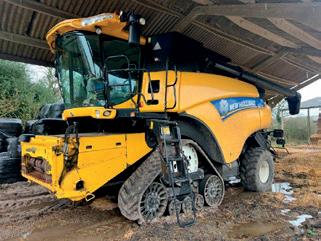

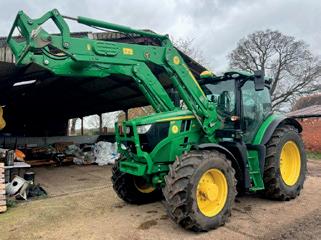










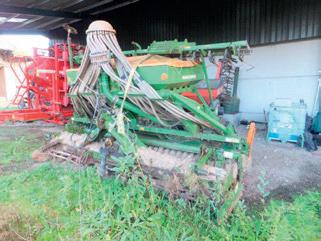
300 drill, Spaldings 90/150 flat lift, Lemken 5 furrow reversible plough, Kubota GR1600 diesel mower, further agricultural machinery, sheep handling equipment, workshop tools, spares & accessories. TIMED ONLINE








Breed Societies








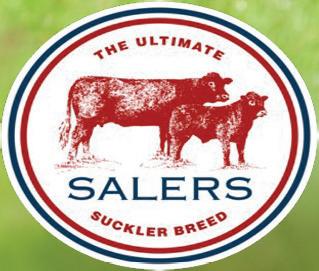














Visit jobs.farmersguardian.com for the latest job vacancies in agriculture


We are looking for an auctioneer to join our McCartneys livestock team. The successful candidate would assist with all aspects of the markets including procurement of stock, weekly auction sales of prime/store stock and on-farm dispersal sales. Experience is preferred but not essential as full training will be given. The successful candidate must have the following:
• Positive attitude and hard work ethic
• Confident communication skills
• Ambition to progress
• Agricultural knowledge and experience
Positions available across the whole McCartneys region. Competitive package and full training will be provided as well as enrolment onto the Livestock Auctioneers Association course at Harper Adams University.
PLEASE CONTACT JAMES AMPHLETT - 07972 653077 OR EMAIL JAMES.AMPHLETT@MCCARTNEYS.CO.UK MCCARTNEYS LLP, WORCESTER LIVESTOCK MARKET, THE HEATH MEADOW, NUNNERY WAY, WORCESTER, WR4 0SQ APPLICATIONS TAKEN IN STRICTEST CONFIDENCE

A fantastic opportunity has arisen for an enthusiastic and conscientious operator to join our small team in North Hampshire. The estate covers around 550ha, of which around 360ha is cropped. We have just started a Higher Tier Countryside Stewardship agreement and also have forestry operations and a shoot. We are looking for someone who can carry out all the major arable operations. In addition, they will be a key member of the wider estate team, assisting with machinery maintenance and work in the woodland.
THE SUCCESSFUL CANDIDATE WILL HAVE:
A high level of attention to detail.
An ability to work autonomously
· A strong awareness of health and safety.
· PA1 and PA2. Telehandler, Chainsaw and PA4s are also desirable, but training will be given.
The ability to keep complete, accurate, records. In return, we offer a competitive remuneration package with accommodation, opportunities for further training and continuing professional development. The role is available from June 2024.
We currently have a wide range of positions available nationwide to include:-
• Autonomous Unit Manager, Mid Devon, 350 cows
• Calf Rearer, Yorkshire, 600 cows
• Relief Herdsperson, West Sussex, 260 cows
Relief Herdspersons Nationwide
LKL provides the perfect solution for finding the very best herd carers and managers.
Visit our website for a full list of our current vacancies.


Agriconnect is a business unit within the Arc network, a global events, data, and media platform. Arc is a fast-growing global events, data, and media platform with a varied portfolio content led portals, magazines, and events.
Since 1844, the brands of Agriconnect have been the trusted source of information for farmers and with brands like Farmers Guardian, events, like LAMMA and Farm Business Innovation, and digital platforms, like FG Insights, Agriconnect continues to bring together the British farming community.
• We are now looking for a motivated and driven salesperson to join our Sales team.
• The main function of the role is to develop business through growth in revenue, yield, and to increase customer numbers. You will be required to identify new opportunities and influence companies’ media buying habits within the agricultural sector. Due to the ever-changing nature of the industry, this person will have the ability to spot new avenues and exploit market trends.
Hours: 35 hours per week – Mon – Fri
• Location: Preston – temporary hybrid remote
• Salary: Competitive, dependant on experience.
• Own, support and fully develop specific market sectors
• Conduct sales presentations by telephone, email or face to face to existing and prospective clients in order to develop existing business and generate new business wherever possible.
• Advise existing and new customers on the most effective solution to meet client needs within the Agriconnect portfolio.
• Continually seek and develop new sales & opportunities.
• Ability to accurately forecast future sales
• Keep abreast of all current trends, activities and relevant news within agriculture and specific sector
• An interest in agriculture
• Highly motivated & driven, with an ability to meet ambitious performance goals
• Be enthusiastic and motivated to continually explore new opportunities, whilst possessing a natural inquisitive nature
• Excellent communication written and interpersonal skills
We offer an excellent package including:
• A competitive basic salary
• 25 days holiday increasing to 27 after two years
• An extra day off on your birthday
• Free life assurance
• Contributory pension scheme
• Employee assistance programme
Arc has ambitious plans for growth, and this is an opportunity to be part of our continuing success story whilst enjoying a fabulous work/life balance. We strive to create a culture that is open and respectful, where differences are valued and celebrated. We want everyone to be able to reach their full potential, so we are committed to cultivating a company that promotes inclusion and belonging.
To apply for this role, please email amber.tabiner@agriconnect.com






ROMANCES
lasting connections with ‘Friends1st’, your premier agricultural introduction agency. Sow the seeds of companionship with like-minded individuals who share your passion for farming and the rural way of life. Our roots run deep in bringing hearts together. Join Friends1st and let love grow on your farm. Call us today to find out more: 0121 405 0941 and discover a much better and more successful way to meet fellow Christians. www. friends1st.co.uk/christian-farmers-datin




























“WITH ENERGY COSTS INCREASING CAN YOU AFFORD NOT TO HAVE A HEAT RECOVERY SYSTEM?”
• GRANT FUNDED
• ESTIMATED PAYBACK OFTEN WITHIN 12 MONTHS
• 60% – 70% REDUCTION TO WATER HEATER RUNNING TIMES
• IMPROVEMENT TO THE COOLING UNITS PERFORMANCE
• HOT WATER AVAILABLE ALL DAY
• DOMESTIC OR OFFICE HEATING
• ALMOST ZERO MAINTENANCE
• HUGE REDUCTION IN YOUR CARBON FOOTPRINT POWERED BY YOUR MOO POWER
For further details please call S.W Refrigeration specialising in “On Farm cooling Equipment” 01392 210344 or Paul on 07974 140949
Reaching deeper and further into UK farming than any other media group























3-5 weeks old available now. Quality store cattle sourced directly from Welsh/Shropshire Borders Farms, delivered to your farm. Delivery Nationwide. Livestock Supplies Ltd












For sale large selection of Bulls, all semen tested. Aged 17 - 24 months. From easy calving lines, with excellent temperament. £3,800 - £5,000. Also, Heifers & Cows in calf, please enquire. Elite Health Status, plus TB4, just tested. Visit www.elderberrylimousins.co.uk for pics, videos & info. Tel: 07825 868939 (Barry) or 07436 076636 (Paul) East Yorks (P) Can deliver or arrange transport nationwide.
A weekly selection of freshly calved & in-calf dairy cattle sourced from the UK. All guaranteed and delivered anywhere in the UK
Finance can be arranged.
Livestock Supplies Ltd
Ashley: 07831 887531, Office: 01829








Bulls for sale




Individually Health Tested
TB Tested
Ready to work
Delivery can be arranged
Tel: 01538 300331 or 07968 622950 Staffordshire (P)













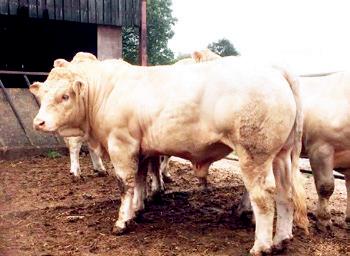
4ft round bales still on field Some water damage BARGAIN AT £10 PER BALE


One Tonne Bags Delivered UK & Wales
Biscon Meal (Approx. 12% Protein/14 ME)
£245 del Cereal Mixture (Approx. 14% Protein/13 ME)
£265 del Cereal Blend (Approx. 16% Protein/13 ME) £285 del Mixed Pellets (Approx. 18% Protein/13 ME) £305 del NEW STORE IN CUMBRIA
One Tonne Bag Collections
Mixed Pellets (Approx. 18% Protein/13 ME) £275 ex store
Biscon Meal (Approx. 12% Protein/14 ME) £225 ex store
CALL NOW 01949 844700 www.midlandfeeds.co.uk
CALL NOW 01949 844700 www.midlandfeeds.co.uk



















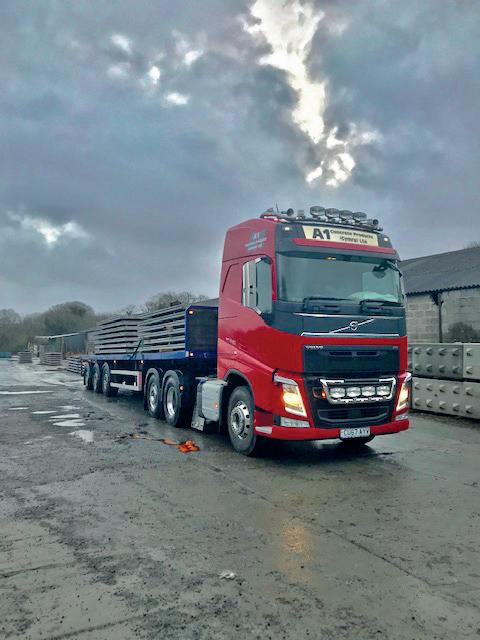









































Tel:01580212141
Mob:07710480259
Email:info@timberspecs.com













An agricultural worker’s dwelling serves several crucial purposes for a farming business including on-site availability, security, improvements to animal welfare and increased job satisfaction.
Obtaining permission for a dwelling in the countryside can sometimes be difficult due to restrictive planning policies. However, exceptions can be made, and the primary consideration is that there is an essential and functional need for a dwelling.

operations and maintenance of the proposed dwelling.
Providing evidence of healthy accounts, financial forecasts and investment in the business will improve the chances of permission being granted.

Although specific requirements may vary depending on the local authority, demonstrating this need is fundamental in securing planning permission for a rural dwelling.


Establishing a functional and essential need comes from assessing the day-to-day operations of the business to justify the necessity of an agricultural worker residing permanently on-site. Several factors contribute to this, such as current operations, man hours, stock numbers and area farmed.
Obtaining planning consent for an Agricultural Worker’s Dwelling can be a complex yet essential process for farmers. Providing permanent on-site accommodation for employees plays a vital role in retaining skilled workers.


In a recent approval I received, a letter of support from the vet confirming the requirement for on-site supervision also helped strengthen the application. One of the keys to success is illustrating that the viability of the business is dependent on an employee being within sight and sound of the farming enterprise.
In addition to the above, the business also needs to prove it is financially-sound. The economic test aims to ensure that the proposed development is fiscally viable, supporting both the current
It can be a necessity for maintaining the smooth operation of the farm, ensuring the welfare of livestock and promoting operational continuity which contributes to the farm’s overall productivity and profitability.
Understanding the regulatory conditions together with providing a strong case demonstrating the requirement will increase chances of success in navigating the planning process effectively.







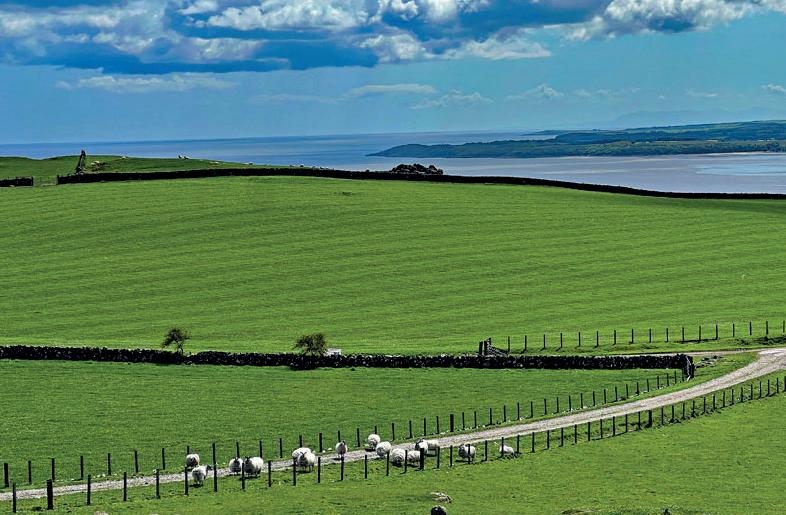

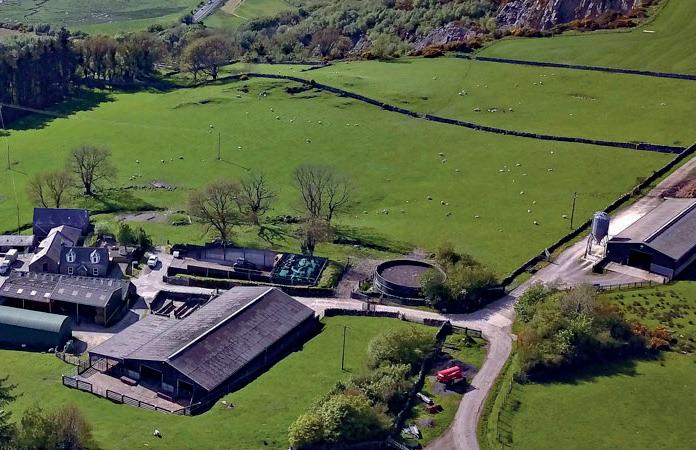
- VERY WELL-PRESENTED TWO BEDROOM FARM COTTAGE
- FARMHOUSE EPC RATING: E (40)
- COTTAGE EPC RATING: D (58)
- BASIC PAYMENT (204.99 REGION 1 & 69.92 REGION 2) - FORESTRY GRANT SCHEME











A ring-fenced block of productive grassland
A ring-fenced block of productive grassland located close to Redditch.
•Grade 3 grassland
•Ponds and woodland
•For sale as a whole by Informal Tender
• Tender deadline: 12 noon Thursday 30th May 2024
•Vacant Possession available
• In all about 122.03 acres (49.38 ha)

Gumley, Leicestershire

A ring-fenced block of productive grassland overlooking Pitsford Water.
•Grade 3 grassland
• Grade 3 grassland
•For sale as a whole by Informal Tender
• For sale as a whole by Informal Tender
• Tender deadline: 12 noon Thursday 30th May 2024
• Tender deadline: 12 noon Thursday 30th May 2024
• Vacant Possession available
•Vacant Possession available
• In all about 57.92 acres (23.44 ha)

• In all about 57.92 acres (23.44 ha) About acres (46.10 ha) of productive grassland in two lots close to Foxton Locks.
About 113.91 acres (46.10 ha) of productive grassland in two lots close to Foxton Locks.
Productive arable land extending to about 66.55 acres (26.93 ha).
•Grade 3 grassland
• Grade 3 grassland
•Grade 3 arable land in temporary grass
•Lot 1 - About 80.55 acres (32.60 ha)
• Lot 1 - About 80.55 acres (32.60 ha)
•For sale as a whole by Informal Tender
•Lot 2 - About 33.36 acres (13.50 ha)
• Lot 2 - About 33.36 acres (13.50 ha)
• Tender deadline: 12 noon Thursday 30th May 2024
•
•For sale by Informal Tender
• For sale by Informal Tender
•Vacant Possession available
• Tender deadline: 12 noon Thursday 30th May 2024
• Tender deadline: 12 noon Thursday 30th May 2024
• Vacant Possession available
•Vacant Possession available
Guide price – £1,025,000 (as a whole)
Guide price – £475,000
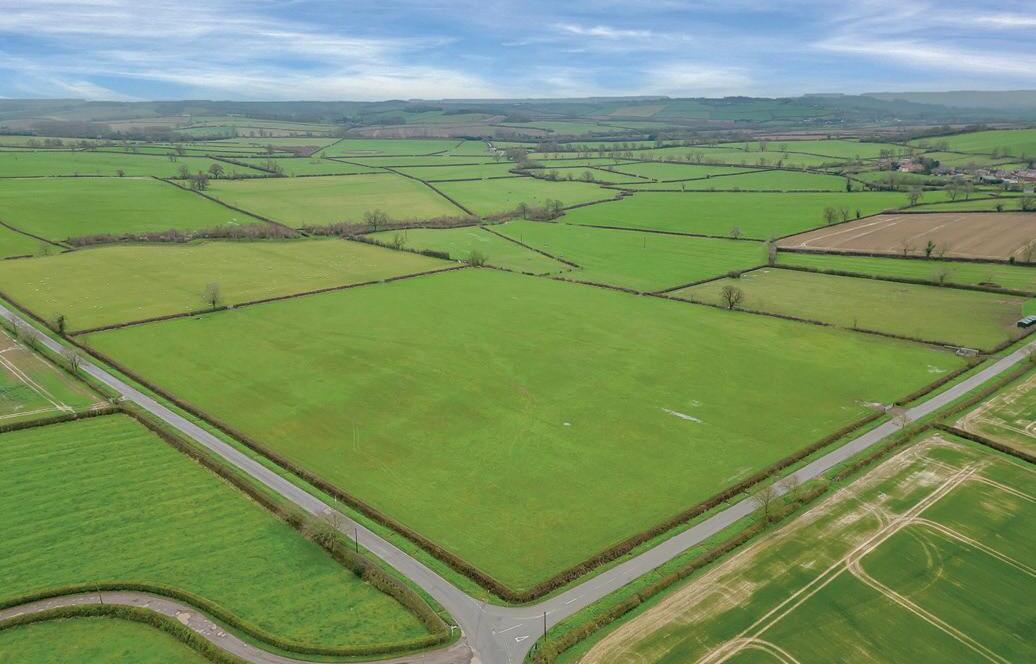

Productive grassland in two lots close to Slawston village extending to about 74.56 acres (30.17 ha).
Productive grassland in two lots close to Slawston village extending to about 74.56 acres (30.17 ha).
• Lot - About 55.44 acres (22.43 ha)
• Lot 1 - About 55.44 acres (22.43 ha)
• Lot 2 - About 19.12 acres (7.74 ha)
• Lot 2 - About 19.12 acres (7.74 ha)
• For sale by Informal Tender
• For sale by Informal Tender
• Tender deadline: 12 noon Thursday 30th May 2024
• Tender deadline: 12 noon Thursday 30th May 2024
• Vacant Possession available
• Vacant Possession available

About acres (53.93 ha) of productive grassland in three lots a strategic location.
About 133.25 acres (53.93 ha) of productive grassland in three lots in a strategic location.
• Lot - About 34.29 acres (13.88 ha)
• Lot 1 - About 34.29 acres (13.88 ha)
• Lot 2 - About 35.21 acres (14.25 ha)
• Lot 2 - About 35.21 acres (14.25 ha)
• Lot 3 - About 63.75 acres (25.80 ha)
• Lot 3 - About 63.75 acres (25.80 ha)
• For sale by Informal Tender
• For sale by Informal Tender
• Tender deadline: 12 noon Thursday 30th May 2024
• Tender deadline: 12 noon Thursday 30th May 2024
• Vacant Possession available
•
•
•
•
Productive grassland in two lots extending to about 99.21 acres (41.15 ha).
Productive grassland in two lots extending to about 99.21 acres (41.15 ha).
• Lot - About 32.04 acres (12.97 ha)
• Lot 1 - About 32.04 acres (12.97 ha)
• Lot 2 - About 67.17 acres (27.18 ha)
• Lot 2 - About 67.17 acres (27.18 ha)
• For sale by Informal Tender
• For sale by Informal Tender
• Tender deadline: 12 noon Thursday 30th May 2024
• Tender deadline: 12 noon Thursday 30th May 2024
• Vacant Possession available
• Vacant Possession available

Three-bedroom cottage with adjoining paddocks. Extending to about 1.35 acres (0.55 ha).
• Edge of village location
• For sale by Informal Tender
• Tender deadline: 12 noon Thursday 30th May 2024
• Tender deadline: 12 noon Thursday 30th May 2024
• Vacant Possession available
• EPC - E
• Vacant Possession available Guide price – £315,000





























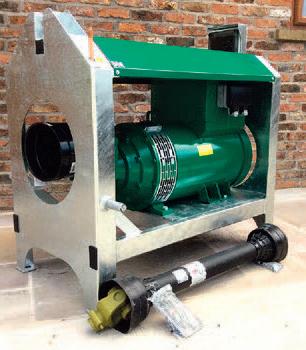





























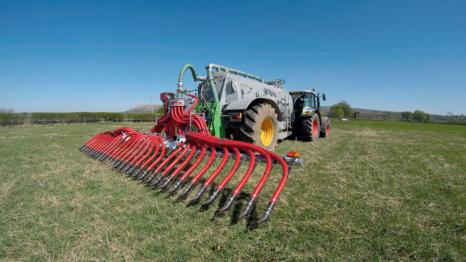

















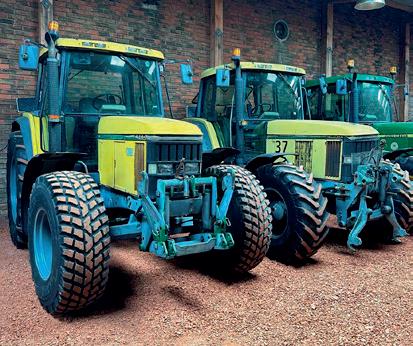



















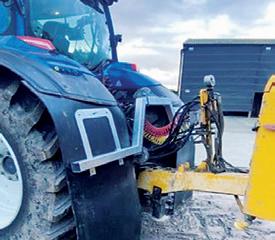

























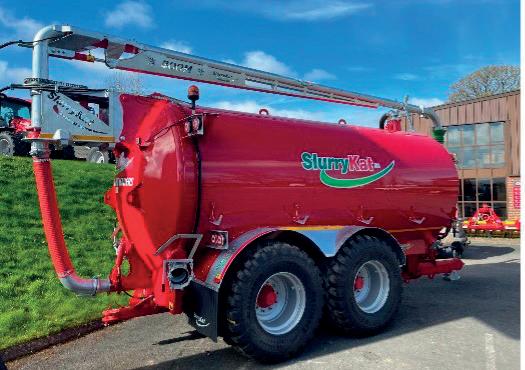

















SPEARHEAD SNIPER 250 SHD
Front or Rear linkage mounted flail mower. 8’2” ( 2.5m ) cutting width, 23 heavy duty hammer flails, adjustable height roller, Adjustable cutting height, replacement bolt on skids. £8,950 + VAT
SPEARHEAD SNIPER 280 SHD
Front or Rear linkage mounted flail mower. 9’2” ( 2.8m ) cutting width, 25 heavy duty hammer flails, adjustable height roller, Adjustable cutting height, replacement bolt on skids £9,250 + VAT

SPEARHEAD SNIPER S230 HD OFFSET
Heavy duty gearbox, Variable parallel arm, adjustable rear roller, heavy duty hammer flails, Bolt on skids, cowl angle. One only £7,950 + VAT


NEW S 55 TWIGA HEDGE / VERGE CUTTER
1.2m head, manual roller, Pilot hydraulic proportional controls. 18’ ( 5.5m ) reach. Linkage mounted. £19,750 + VAT
SPEARHEAD S60 Twiga hedge / Verge cutter
1.5m head, hydraulic roller, Minipilot electric controls, 6m ( 19’ 7” reach ) Linkage mount, £25,750 + VAT






































054
831


A spike in Land Rover thefts has sent ripples through the industry, causing insurance premiums to sky-rocket and residual values to plummet. For those with older models falling outside of JLR’s current security enhancement, what can be done to boost vehicle security? Geoff Ashcroft reports.
Often referred to as the UK’s most stolen car, there is much unrest among owners of Jaguar Land Rover’s (JLR) Range Rover, Discovery and Defender models.
So much so that JLR is rolling out a £10 million security enhancement as it seeks to restore customer confidence in the prestige brand.
While vehicles manufactured since 2022 are built with what the maker describes as its most advanced electrical architecture, it is earlier models that appear to be most at risk.
Updates are currently being rolled out on models built from 2018 to 2022, to provide the same level of protection as post-2022 cars.
JLR says its security updates have already been installed on more than 70,000 vehicles, reducing theft of Range Rover and Range Rover Sport models from 2018 to 2022 by more than 40 per cent.
And there is talk of the scheme being extended to older models produced from 2016-2018.
Farming insurance provider NFU Mutual says it knows from experience that both older and newer Land Rover models are frequently targeted by thieves.
“As well as opportunists, organised criminal gangs will scour the countryside for these soughtafter vehicles, often stripping older models for parts and shipping newer, luxury models as far afield as Africa and Eastern Europe,” says Andrew Chalk, car insurance specialist at NFU Mutual.
“We would urge all Land Rover owners to use a blend of technical

and physical security measures to protect their vehicles.
“If you have a newer model, make sure you install the upgrades issued by the manufacturer.
“All owners should consider the use of tracking devices and immobilisers and combine these with traditional methods such as steering wheel and pedal locks, as well as good site security.”
“Keyless theft can be quick and easy for thieves, but if you can slow them down with additional layers of physical security, you may deter a criminal,” he says.
The recent impact of thefts has resulted in residual values plummeting, with many owners reporting a doubling of insurance premiums.
Some have seen insurance being withdrawn at the point of renewal and JLR has recently responded by introducing its own Land Rover insurance solution for customers.
For owners of older models that currently fall outside JLR’s ongoing security enhancement, there are actions to help prevent a vehicle being taken.
Many Land Rovers are being taken by hacking into the car through the convenience of keyless entry.
Known as relay theft, criminals use a transmitter to search around the outside of a property for key signals.
These are then relayed to an accomplice stood by the vehicle, tricking the car into thinking the
key is present and allowing the doors to be unlocked.
Once inside the vehicle, thieves simply recode keys through the on-board diagnostic (OBD) port, allowing the engine to be started and the vehicle driven away.
One of the simplest deterrents to relay theft is to keep car keys in a Faraday pouch.
Other owners have also disabled the keyless function and have reverted to pressing buttons on the key fob to lock and unlock the car.
JLR says that pressing the lock button twice will activate the alarm and apply double-locking which prevents the doors being opened if a window is smashed.
JLR was one of the first makers to roll-out Ultra-Wide Band (UWB)


ation of different manufacturer’s after-market security products that communicate with each other.
“We have worked with insurance companies and key programming companies to eliminate a singlepoint immobiliser in favour of a more complex and robust mechanism,” explains Mr Capriglione.
We would urge all Land Rover owners to use a blend of technical and physical security measures to protect their vehicles
ANDREW CHALK
protection in 2018, to counter the relay method, and it is keen to point out that its vehicles are not vulnerable to this method of attack when equipped with UWB technology.
However, relay theft is not the only technique being used.
Devices known as emergency engine start boxes simply plug into the OBD, eliminating the need for a key, while CAN-injection methods seek access to a vehicle’s electrical architecture.
This latter method enables bogus messages to be run through the CAN-bus system to trick the vehicle into unlocking the doors and disabling the immobiliser.
Social media pages dedicated to the theft of stolen Land Rovers have highlighted several models which have been compromised
through the rear tailgate, with the help of a battery drill and a hole saw.
Once opened like a tin of beans, the wiring loom is accessed and the vehicle is unlocked and driven away.
Aside from more drastic measures such as battery disconnection and wheel clamps – neither of which are practical – a number of owners are turning to the adoption of multiple security measures.
These can include visual deterrents, such as a physical steering wheel lock.
On its own, it could be enough to encourage a would-be thief to seek an easier target.
In response to recent attacks, the maker of Disklok has released a Diamond Edition of its metal steering wheel cover.
Priced from £260, it includes a greater amount of composite material called Diamonite, which is said to be better able to withstand an angle grinder attack from more determined thieves.
Increasingly, multi-layered vehicle security systems are far more likely to stall a thief to the point where theft takes too long, and the risk of being caught is increased.
Andy Capriglione of Kent-based Specialist Auto Solutions has created a multi-layered security package specifically aimed at Land Rover vehicles.
Marketed as the SAS-Track package, it installs a multi-layer security system that uses a combin-
“It is all about making life more difficult for thieves.”
He says that his £699 SAS-Track package uses a combination of a secure Bluetooth encrypted fob that combines with two immobilisers and a tracker.
He says: “Unless the Bluetooth fob is within five metres of the car, the ignition will not come on.
“The fob over-rides the ignition completely and also prevents a thief from reprogramming a key via the OBD.
“If the key is used without the fob, the owner gets a text message within 30 seconds to inform
them that the vehicle is being tampered with.”
The Bluetooth fob also connects to a communication module which provides a vehicle tracking capability, along with a battery-back-up.
Should the vehicle be taken using its key and its encrypted fob, the SAS-Track package delivers a further layer of control.
“In addition to letting the owner know where the vehicle is through live tracking, the communication module contains an extra immobiliser function for remote engine shut-down,” Mr Capriglione adds.
“It requires the owner to send a command from a smartphone to the vehicle, to authorise this function.
“Once activated, the communication module monitors vehicle movement and, as soon as the speed drops to 12mph or less, it will cut the engine and will not enable a restart until the additional immobiliser is reset through the app.”

Mechanical weeders are increasingly of interest for mainstream cereal crops, as growers look for alternative methods to supplement pesticide applications. Geoff Ashcroft looks at some of the options available, and how they could be used to support broadacre farming.
Mechanical weeders have long been the preserve of the organic sector, but interest for mainstream cereal crops, primarily to supplement pesticide regimes, is growing.
Along with wider spaced rows and advanced precision through camera guidance, the mechanical weeder can operate with more speed and precision than before.
Usefully, these implements come in two formats – inter-row hoe, and rotary hoes.
While the more traditional interrow type cuts through the soil between rows of crop to leave weeds on the surface to wither and die, the more cereal-focused rotary
hoe teases its way through the standing crop, removing small weeds.
Being non-row specific, it is the rotary hoe that can be more effectively applied to cereal crops.
The star wheels format does the work of uprooting, exposing and sweeping weeds out of the soil, leaving the stronger cereal crops to withstand the effects of aggressive combing.
New entrants for this low precision rotary hoe format include KRM’s Carre Rotanet, Kverneland’s Helios and Pottinger’s Rotocare V. Pottinger UK’s marketing manager Shaun Kent says: “Rotary hoes
need to be set-up correctly to match the location-specific field and crop conditions.
“So while you do not need precision guidance to accommodate early growth stages, you should be prepared to adapt the weeding tools to the type and size of weeds.”
Mr Kent adds that by avoiding the sophistication and cost of inter-row guidance, the rotary hoe can be a much faster, simpler and lower-cost process.
“A 12.5-metre Rotocare V operating at 18-20km/hour can soon cover a lot of ground,” he says.
“But timing is everything. Used in spring when ground conditions are soft makes it easy for rotary hoes to uproot weeds.”


Pottinger’s Rotocare range of rotary hoes offer working widths of up to 12.5 metres.

“But if those weeds are rooting at 30-40mm deep, then it is probably time to park the rotary hoe and switch to an inter-row unit with A-shares which can work to a greater depth,” he says.
“The trade-off here is cost, speed and, of course, the need for crops grown at wider row spacings.”
Rotary wheels also feature on Kverneland’s Helios, but unlike others, the star wheels operate in reverse.
Kverneland product manager
Adam Burt says: “The Helios uses cast-iron star wheels, though they are mounted so they operate as if you are using the back of a spoon to work the surface.
“This enables the weeder to gently break the top layer rather than digging into it, which delivers a much less aggressive process that still pulls out shallow-weeded roots.
“And a following harrow ensures weeds are kept on the surface to die, rather than risk being covered in soil, where they could easily regrow,” he adds.
The Helios uses star wheels mounted in pairs on tandem axles across its working width.
Downward pressure for each pair of star wheels is controlled by

adjusting the amount of hydraulic pressure applied.
This allows fine, delicate control to suit the soil surface and achieve shallow weeding in the top 1020mm of soil.
“If there is a need to apply more pressure, we can do that through the frame and also by altering the angle of the following harrow,” he adds.
“We have found the Helios to be an effective mechanical solution for black-grass control, with the star
wheels pulling out small weeds without impacting on crop growth.”
The key to its effectiveness, says Mr Burt, is to use the weeder little and often.
“It is a low-cost solution, so making repeated passes in spring is the best way to manage weeds as they poke through,” he says.
“Done correctly, this weeding action can also encourage tillering in cereals, though timing and soil conditions are fundamental to the success of the process.”
Kverneland suggests that growers should consider drilling around 10mm deeper than normal, if mechanical weeding is going to be more widely used in cereal crops.
Among the organic sector, mechanical weeding has become a proven practice, with manufacturers including Garford Farm Machinery, Edwards Farm Machinery, Opico and Terrington Machinery among the established players with inter-row hoes.
Alongside them sit several revised options.
These include Lemken which bought the Dutch-built Steketee range; Standen Imports for the Italian-built Ferrari hoes and Claydon for its front-mounted Terrablade inter-row hoe.
A new name in the UK market is Schmotzer and, while the German firm has been making hoes for almost 100 years, its new owner Amazone believes the Venterra 2K series could be one favoured by


With its cast-iron star wheels operating backwards, Kverneland says its weeding action is gentler on the crop yet still effective at removing shallow-rooting weeds.

British farmers. A key feature of the Venterra is said to be its ability to be used over much longer growing periods due to a deep underframe clearance and increased lift-out height.
Amazone says this enables the continued use of the hoe during the season, in crops of up to 50cm high.
Its technology includes automatic section control on individual hoeing units, enabling the implement to lift and lower every tine element at headlands.
Amazone says models are available in working widths of 4.56.75m and are capable of dealing with row widths from 45cm up to
75cm, making its range suitable for maize and sugar beet, for example.
The Venterra 2K is guided between the rows using the Horus Pro camera set-up which affords precise guidance at high forward speeds, with downtime minimised by the Rapido quick-change blade system.
Additional tools, such as row protectors and following harrows can also be added if required, while a multi-purpose, interchangeable tool system enables the hoe to be set-up for a number of different functions, with ridging discs or finger wheels being mounted on a separate parallelogram for improved contour following.

In addition to the Helios rotary hoe, Kverneland’s weeder range also includes the Onyx row-specific tined hoes which can be combined with its Lynx guidance interface and up to two colour scanning self-steering cameras.
In working widths from 3-12m, the Onyx can provide section control through automatic raising and lowering of individual weeding assemblies at headlands, when equipped with IsoBus and the X-Control parallelogram for each weeding unit.
Vaderstad says the purchase of all intellectual property rights to Danish manufacturer Thyregod’s TRV inter-row cultivator range –including the Swingking – will give the Swedish maker a line-up that dovetails with its Tempo precision drill and Proceed direct drill.
Initially, the inter-row cultivators will be sold under the Thyregod brand, and be manufactured in Thyregod’s production facilities in Denmark.
From June 2024, the products will carry the Vaderstad name and adopt the firm’s red and yellow liv-
ery. Thyregod’s TRV technology includes a patented section lift, extensive adjustment options and is claimed by the firm to be the world’s first inter-row cultivator with individual frames that are each controlled by a camera.
With inter-row models relying on high-accuracy, most mechanical weeders are chosen with a working width that matches the drill.
However the TRV Swingking features a chassis design which can carry two independent weeder frames in one implement.
As such, it can accommodate working widths of up to 18m, suiting drills up to 9m wide.
Andy Gamble, sales and marketing manager of Vaderstad UK, says: “Using a Tempo precision drill with a 6m working width and 75cm row widths would usually require an eight-row inter-row cultivator to be used when following exactly where the drill has been.
“In this instance, the doubleframe creates a 12m inter-row setup with two six-metre weeding units to achieve high precision, without damaging the crop on a pass-to-pass basis.”
■ Amazone
■ Claydon
■ Edwards Farm Machinery
■ Garford Farm Machinery
■ Horsch
■ KRM
■ Kverneland
■ Lemken
■ Opico
■ Pottinger
■ Standen Imports
■ Terrington Machinery
■ Toucan Farm Machinery
■ Vaderstad





Visitor Stats*
Taken from the 2024 event
40,000+ 650+
87%
of exhibitors were satisfied with the event exhibited at LAMMA 2024 attended LAMMA 2024

80% of exhibition space is booked
Benefits of exhibiting at LAMMA
✔ Engage with key decision makers
✔ Promote your products and services
✔ Increase brand awareness
✔ Increase brand credibility
✔ Launch new brand, product or service
✔ Meet current customers
For all sales enquiries or to book a stand scan or click on the below QR code and fill in the form:







We’ve had a really great show here at LAMMA – Full of quality conversations. Our stand is particularly interactive this year so it’s been really drawing people in. We’re looking forward to next year already!
-AGCO-LAMMA is a great place to meet up with our existing clients and meet new, it’s what brings us back each year. The show has been very busy for us once again.
-Agrifac-





Using a tine harrow for mechanical weeding is a familiar concept, but the latest designs are aimed at higher outputs and more effective targeting of weeds.

Amove to reduce herbicide use on his farm in a Severn Trent priority catchment has led Bruce Gilbert back to an implement familiar from days spent working with his father.


Jane Carley speaks to a Herefordshire farmer getting good results.


He says: “He had an old Einbock tined weeder, and I have been looking into the idea for a few years, as I am keen to cut spray use and costs, which are just not sustainable.”
Lower House Farm, near Ledbury, is in the Wye Valley catchment, so he was able to approach Severn Trent for a grant towards the cost of a tined weeder under its Severn Trent Environmental Protection Scheme, and received £6,000 funding.


FUNDINGformechanicalweeding maybeavailabletofarmsinpriority catchmentareasforwater companies.
In the spotlight were a number of brands of tined harrows, which work by removing and/or destroying small weeds over a number of passes.


Forexample,SevernTrentoffers upto£10,000(amaximumof50 percentfundingofthecost)for non-chemicalweedcontrolequipment forarablecrops.
Thisisdefinedasinter-row
He says: “This method simply takes out the weeds rather than tilling the soil as wider tined hoes do. We had a number of demonstrations, but par- ticularly liked the design of the Horsch Cura, which has six support wheels at the rear, allowing it to float and follow ground contours.”
Supplied for the 2023 season, the


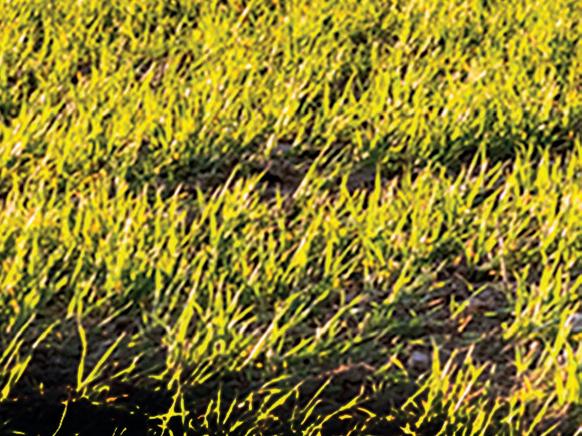





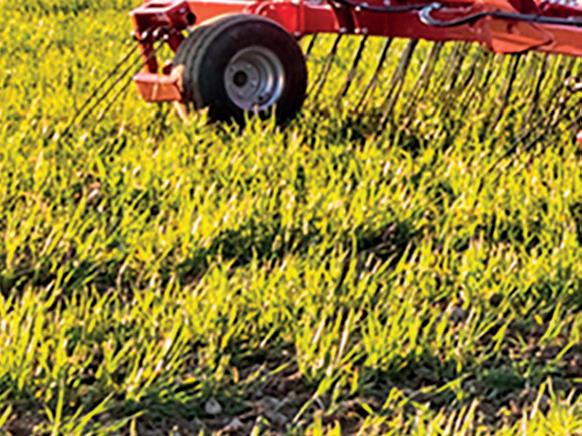


weeders,rakes,combharrows andhoes.
SevernTrentimposescertain conditionsforitsscheme:
■ Sizeandspecificationofthe equipmentisofthefarm’schoosing; however,theprimaryfunctiononthe equipmentmustbemechanicalweeding
■ Iffittedtoanotherpieceofequipment –forexample,adrill–onlytheweeding

Cura at Lower House Farm has a working width of 12 metres with fivepart folding to a 3m transport width.
Mr Gilbert says: “We aim to start in February with a pass at 45 degrees to the direction of drilling, followed by a second pass up and down the tramlines in April.
“By removing weeds before they get chance to establish, we aim to cut herbicide use by at least 25 per cent, a saving of £4,000-£5,000, which will soon see the machine pay for itself.”

Weeding can continue until growth stage 32, with the frame offering sufficient clearance for taller crops. The suspension springs are attached above the frame to avoid crop damage.
While not every year allows the Cura to be used to its greatest effect (2024 being a case in point due to the continuing





componentsmaybeclaimedfor underthisoption
■ Applicationsformachinery notoriginallyintendedforweeding cannotbefunded
■ Itemisedquotesmustbeprovided
■ Mechanicalweedingmaynot besuitableforallcrops,soiltypes orconditions,andfarmsshould considertheimplicationscarefully

wet conditions), Mr Gilbert says it will make a significant difference. He says: “Forward speed needs to be enough to pull the weeds out, about 12-15kph, but soil condition is paramount. For best results, you need a slight crust or haze on the surface, it must not be too wet. If it is too dry or you go too fast, the harrow will ‘bunny hop’.”
The fine, closely spaced tines which are individually suspended via a double spring also need a clean, trashfree seedbed for accurate weeding.

He says: “We used the ma-
















Plenty of horsepower is needed to give sufficient lift capacity for the robustly built harrow.


chine post-harvest, but it did not work as well as we hoped; we are still learning. The tines can be adjusted hydraulically for pressure from 0.3kg to 5kg using double springs, so you can use it more aggressively on very weedy ground. We were pleased with the results in a trial area, so we are also looking at using it on spring crops.”
Another development will be to fit a seeder, allowing the Cura to be used for establishing cover crops, which will extend its season.
Mr Gilbert says that horsepower is important – about 200hp is needed to give the required lift capacity. Outputs of





80 hectares per day are possible, he says, with the side wings lifting slightly to give easier turning.
The 7mm carbide tines are 130mm long in the wear area and are arranged in steps on six bars for improved clearance. They are cranked for improved transmission of force.
In its first year, the Cura has shown little wear, adds Mr Gilbert. “Our soils are mainly clay, so not abrasive on the tines, but it is a wellbuilt machine all-round.”






Mr Gilbert runs the farm with his wife and it is diversified as well as progressive. There is a nod to local tradition, with 25ha of cider apples alongside 300ha of arable, which includes crops grown for seed, pumpkins and flowers for picking to bring in additional income.
He says: “It is good to experiment – I am always keen to try new techniques and we will be able to get a lot out of the Cura.”





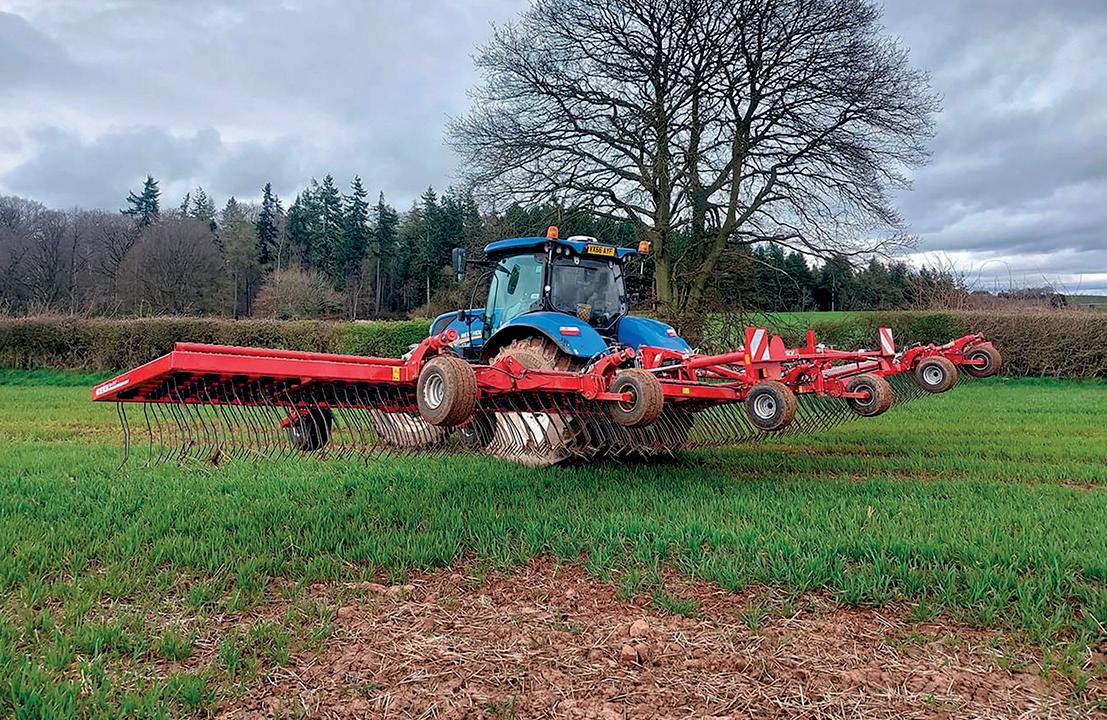

















Established by Ford in 1964, the New Holland plant in Basildon, Essex, is celebrating 60 years of tractor manufacturing. Toby Whatley reports.
DEVELOPED from a greenfield site in the early 1960s, the New Holland production plant at Basildon was constructed by Ford as tractor production was moved away from its Dagenham plant in London.
The factory and surrounding area covers 40 hectares, with the now iconic 37-65hp Ford 6X series beginning production in 1964, which comprised of the 2000 Dexta, 3000 Super Dexta, 4000 Major and 5000 Super Major.
In recent years, the plant has evolved into the New Holland Alternative Fuels Centre of Excellence, with the plant currently the only production site for its compressed natural gas methanepowered tractor.
New Holland says the methanepowered range will be expanded to cover larger models and, in addition, research work into a wider range of alternative fuel solutions will take place.
The plant assembles the T6 and T7 ranges from 125-300hp for the worldwide markets, in addition to Case IH tractors for export to the USA. The plant’s owner, CNH, says a new tractor leaves the line every five minutes. Overall, 85 per cent of the products produced at the factory are exported.
To mark the anniversary, New Holland has created a special edition


of its T7.300 tractor, styled with graphics inspired by the colours and patterns of the swinging 60s era.
Two machines to feature this styling are currently planned for production, with one remaining at the Basildon plant’s visitor centre, and the second to be exhibited at events throughout 2024.
Alongside the special edition machine, the manufacturer presented a comparison of the operator’s seating from the first machines manufactured at the site to its current iteration.
The obvious increase in electronic and software-based control systems aligned with the launch of its remote monitor service for machines using its PLM connect technology.
The service, operated through its dealer network, is designed to provide telematic data analysis, service diagnostics and remote support.

EFFECTIVE soil preparation will be vital to ensure that this year’s maize crops get off to the best possible start, says Simon Montgomery, technical lead of ProCam’s Field Options division.
After months of being waterlogged, with large areas of maize ground sitting under ‘several inches’ of water, soils will need ‘a lot of work’ to get them into the best condition possible before drilling, says Mr Montgomery.
The main effects of the winter’s remarkably wet conditions will be soil compaction, silting and nutrient losses.
Mr Montgomery adds: “Soil compaction will be especially bad on ground which was harvested in wet conditions last autumn, or where farmyard manure has been carted onto wet fields in readiness for spring spreading.
“The wet conditions will also have caused valuable nutrients to be leached out of the soils, and for those left bare over the winter to silt up and become anaerobic.
“The extent of the damage will vary from field to field and according to topography and soil type, but it is safe to assume that the majority of maize ground will need at least some remedial management to ensure the new cropping cycle starts well.
“The quickest, simplest and most cost-effective way of determining


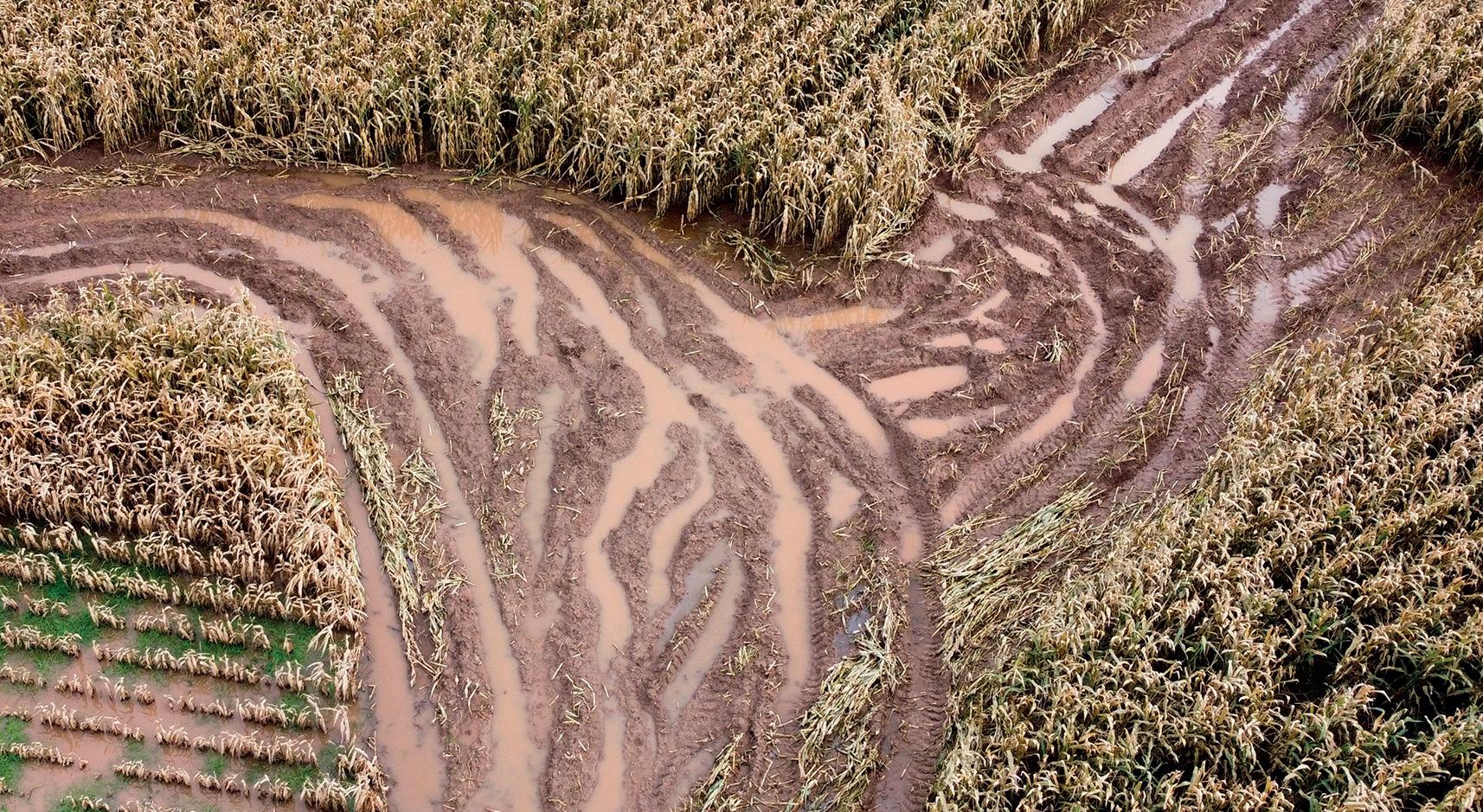

soil condition is to grab a spade and dig a test pit in a handful of locations per field.”
Beyond visual inspections to assess the physical damage incurred, Mr Montgomery also recommends soil sampling to understand the extent to which nutrients have been lost.
He says: “Residual nutrient reserves will have been depleted by leaching, so it is a worthwhile investment to get soils tested properly.
“The key is to test not only for soil-stock nutrient levels of the main macro- and micro-nutrients,
Residual nutrient reserves will have been depleted by leaching, so it is a worthwhile investment to get soils tested properly
SIMON MONTGOMERY
but also to test for plant-available nutrients.”
Mr Montgomery also says that growers should not rush back into fieldwork too soon.
He adds: “It is understandable that farmers and contractors will want to start fieldwork as soon as possible, especially as workloads are already under pressure due to the wet conditions.
“But it does not make sense to travel on land until it is able to withstand heavy machinery.
“Where possible, wait for the conditions to improve sufficiently. Otherwise, there is a danger of inflicting further damage onto already compromised soils.”
When conditions are right, growers should focus on aerating soils to remediate the anaerobic conditions, he says.
“Incorporating manure will help to improve soil structure, but the worst-affected ground might require an extra cultivation pass to break up the more severe cases of compaction or silting. Either way, there is no point skimping at this stage in proceedings,” adds Mr Montgomery.
He says that workload planning could also be a challenge this spring.
“Cropping schedules and workloads are likely to be significantly hampered this spring, especially if conditions remain cool and wet for the next few weeks.
“There is a danger that this year’s window for maize drilling could coincide with first cut silage-making. If this happens, growers should prioritise the latter to ensure they gather a good first cut of grass before focusing on maize drilling.
“If drilling is delayed by more than a week, a starter fertiliser will help the crop to catch up, but growers might also want to look at a slightly later variety of maize to suit the season’s conditions. However, there is always a chance that the most popular varieties will sell out, so plan ahead wherever possible.
“Undersowing maize with ryegrass Westerwolds to protect soils at harvest and to produce a secondary forage crop is also worth considering this year, especially if harvesting is likely to be pushed back as a result of late drilling.
“Grass seed can be sown between the rows of maize when the main crop is at leaf stage 4-6, and after weeds such as fat hen and redshank have been taken out,” says Mr Montgomery.
rLatest RBST Watchlist shows ‘major challenges’By Katie Jones
THE Rare Breeds Survival Trust (RBST) is calling for targeted Government action to encourage more people to keep native pig and poultry breeds. This follows the release of the latest RBST Watchlist, which moves all native poultry breeds into the Priority rare breed category and also shows major challenges for the UK’s rare native pig breeds.
RBST chief executive Christopher Price says: “The new RBST Watchlist reflects the major challenges faced by people keeping pigs and poultry over
the past two years, notably the avian flu outbreaks and the sustained increase in animal feed and husbandry costs.
“We have moved all native poultry breeds to the Priority category as we continue providing urgent support for these irreplaceable breeds’ conservation.
“Seven of the UK’s 11 native pig breeds remain in the Priority category, with most of the rare pig breeds now showing a sustained downward trend in total sow numbers. The ‘at risk’ Welsh pig for example has fallen from 457 sows in 2020, to 296 in 2023. We must reverse these worrying declines before it is too late.”
Mr Price also says that while the Environmental Land Management (ELM) scheme encourages farmers and smallholders to choose native
Scotland
26.3kgdrymatterperhectareperday (10.6kgDM/acre/day) 30.4 7.6 36.9
The North
60.6kgDM/ha/day (24.5kgDM/acre/day) 31.1 9.5 33.5
Wales
39.1kgDM/ha/day (15.8kgDM/acre/day) 29.5 9.4 46.9
The South
46.5kgDM/ha/day (18.8kgDM/acre/day) 32.9 10.2 13.9
Grass growth Soil moisture (cb)
Soil temperature (degC) Rainfall (mm per week)

Region Seven-day forecast
NorthEngland 54.1kgDM/ha(21.9kgDM/acre)
Wales 50.4kgDM/ha(20.4kgDM/acre)
14-day forecast
39.9kgDM/ha(16.1kgDM/acre)
42.6kgDM/ha(17.2kgDM/acre)

Tamworth pigs have seen total sows reduce from 304 in 2020 to 239 in 2023.

breeds for grazing, it does ‘nothing to help safeguard the future of our native pig and poultry breeds’.
He says: “The outlook for our rare pig and poultry breeds is a great concern, we want to see the ELM’s SP8 supplement broadened to include native pigs and poultry, as well as grazing animals.”
The Watchlist confirms growing concerns about a number of individual rare breeds including the Priority category pig breeds. British Pig Association data shows declining numbers overall for the Priority category pig breeds, including the Berkshire pig (total sows down from 363 in 2021 to 288 in 2023), and the Tamworth pig (total sows reduced from 304 in 2020 to 239 in 2023).
The Shetland cattle breed was already in the At Risk category and has seen a further 19 per cent decline in the number of dams in 2023.
THEREispositivenewsforsome rareUKlivestockbreeds,including:
■ Greyface Dartmoor sheep: Nolongercategorisedasrare. Since2009thenumberofflocks hasincreasedby155percent
■ Norfolk Horn sheep: 2023saw a14percentincreaseinthenumber ofbreedersforthisAtRiskbreed
■ Vaynol cattle: ThisPrioritybreed remainsoneoftheUK’srarestcattle breeds,buthasnowrecordedtwo yearsofstablenumbers
■ Irish Moiled cattle: ThisAtRisk breedhasseenanincreaseof8per centinthenumberofdamsin2023
■ Saddleback pig: Thenumberof damsproducingpedigreeregistered progenywasup16percentin2023, alongwiththenumberofbreeders whichwasup12percent
And already in the At Risk category, Original Population Lincoln Red cattle saw a 39 per cent reduction in the number of dams in 2023.
■ Despiteverywetconditions,soil temperaturesandrecordedgrowth rateshaverisen,withaforecastof about50kgofdrymatter(DM)per hectareperday(20.2kgDM/acre/day) overthenextsevendays
■ Continuetowalkthefarmregularly toidentifypaddocksorsectionswhich aregrazeablewithgoodaccesspoints
■ Atthistimeoftheseasonconditions
canchangerapidly,soitsimportant toestablishagrass‘wedge’asthe growthraterises
■ Establishedewe/lambgroupscould beamalgamatedtogettherotation movingandfacilitatefertiliserspreading
■ Thewetweatherhaslimited opportunitiestoapplyorganicand artificialfertiliser;fertilisershouldbe inplaceforwhenconditionsimprove
GrassCheckGBisacollaborationbetweenTheUKAgri-TechCentre,Agri-FoodandBiosciencesInstitute,RothamstedResearch,AHDB,HybuCigCymru,Germinal, HandleyEnterprises,SciantecAnalytical,Yara,Pilgrim’sUKandQualityMeatScotland.Regularupdateswillappearin Farmers Guardian.


Thistles reduce grazing and can increase the chance of Orf in sheep.
Thistlex gives outstanding control of all species of thistle, killing down to the root so they won’t grow back.
Kind to grass, it also controls nettles and dandelions. Stock can return to the field just 7 days after application.



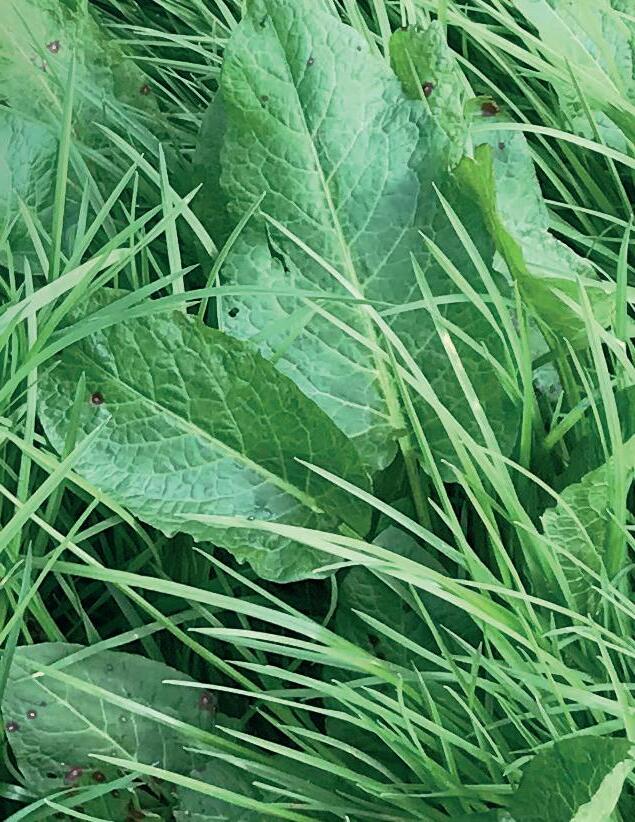

If you have a problem with broad or curled leaf docks, Doxstar Pro’s concentrated formulation combines the power of triclopyr and fluroxypyr to deliver outstanding dock control.
It is highly effective on chickweed and dandelions too and is very safe to your grass.





For harder working grassland, talk to your advisor or find out more at www.corteva.co.uk/forage
New entrants Andrew and Suzanne Jardine have successfully converted a tenanted Dumfriesshire farm into a dairy unit. Chris McCullough reports.
Taking on a farm tenancy is a huge challenge in itself, but a certain amount of determination is required to convert a tenanted farm with no dairy facilities into a thriving dairy business.
This is exactly what Andrew and Suzanne Jardine have done and they now run more than 100 Jersey cows on Newfarm, part of the Applegarth Estate, Moffat.
It has been a steep learning curve for the duo and their two children Howie, 12, and Tilly, 10, who are now halfway through their 10-year lease.
The logistics and infrastructure
of the farm have certainly changed since the Jardines took on the tenancy in August 2019, when they started off with only one heifer and no buildings.
Mr Jardine says: “The farm is part of the Crown Estate Scotland and extends to 242 acres.
“It was in a fairly dilapidated condition when we took it on, with no dairy facilities at all.
“We started the foundations of the dairy during the Covid-19 lockdown in early 2020, and purchased 32 bulling heifers from Denmark to start building a herd.”
He says the only existing infrastructure on the farm were 32 cubicles, built in the 1970s, and a



409,148-litre (90,000-gallon) slurry tower.
The family purchased a secondhand parlour which had been replaced by robots on a farm 30 miles away, along with a bulk tank from another farm that had been sold.
Mr Jardine says: “In order to keep our costs low, I worked off-farm a lot with the builder to gain credit with him so he would come and construct the parlour without money changing hands.”
In June 2021, the first heifer calved at Newfarm and formed the foundation of the Jardine’s Applegarth Jersey herd.
ing heifers this year and 65 heifer calves to serve next winter.
“I prefer the Jersey breed due to their high milk solids and smaller body weight.”
Mr Jardine adds his goal is to breed cows with good depth and width, with plenty of power in their chest and good feet.
The herd has been based on both Danish and North American genetics, but he has been using the latter predominantly across the herd for the past two breeding seasons.
He explains his future plans include genomic testing of all the calves to match them with the best genetics to breed from.
Mr Jardine says: “Our current cow numbers total 104 milking and three dry. We have about 45 bull-
Cows are run as one group for ease of management, with calving taking place between August and February.






In June 2021 the first heifer calved at Newfarm and founded the Applegarth Jersey herd which is now more than 100-strong.


Mr Jardine says: “We tend to feed the cows very well over the winter when fresh, hoping to increase fertility. When April and May come we can start grazing and reduce the concentrates, with hopefully all cows in-calf.”
Cows have up to three sexed semen inseminations and, this year, an Aberdeen-Angus bull will run with anything not in-calf.
Mr Jardine wants to make further improvements to infrastructure and introduce technology to the farm, but says that, as new tenants, they are limited by what they can afford currently.
He says: “We started using Uniform for the cow management two years ago and we added a Lely Discovery slurry collector.
“Next winter I hope to buy Cow

Manager eartags for health and fertility monitoring.
“The estate is currently building us a new calf shed and would like to install a computerised calf feeder in it.”
He adds that he has plenty of plans for the farm in the future including expansion, but finding extra land to do so could be difficult.
“I believe this farm could run in excess of 200 milkers if the youngstock are reared off-farm.
“Currently all heifers, from weaning up to bulling, winter in sheds we rent five miles down the road.
“I would like to add silage pits as soon as possible and we have just completed building a one-million gallon slurry lagoon with help from a Scottish Government Agri-Environment Climate Scheme grant and from the estate.
“The opportunity to gain more land here can be an issue for us due to uncertainty in the Scottish tenanted sector.
“We hope to overcome this by building and growing good relationships with anyone we rent
■ Cows are milked twice-a-day, with the herd achieving an annual yield of 7,545kg at 5.8 per cent butterfat and 4.16 per cent protein and a somatic cell count of 63
■ The rolling 12-month calving index is 389
■ The herd was recently placed second for the highest yielding Jersey in Scotland using NMR milk recording data
■ Milk is sold to First Milk
■ Last year four cuts of silage was taken and made into round bales
from. Funding this entire venture has been really challenging as we have had to buy stock and also build a parlour, tank house, feed bin and install 100 new cubicles and mattresses.”
Mr Jardine is the only full-time worker on the farm and uses three relief milkers to allow him extra time with his young family.
“It is an area I need to address. Hopefully next winter we will be in a position to take on someone else full-time,” he adds.
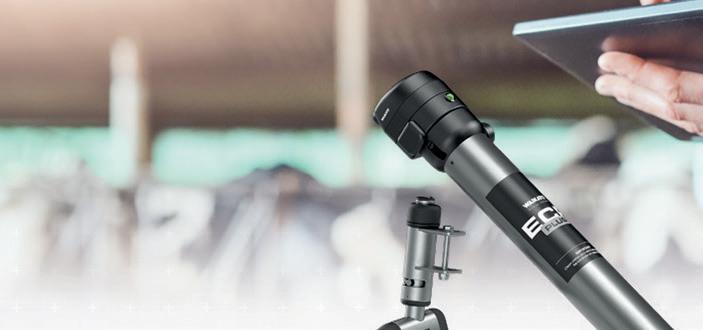



















There is often a perception when entering that you have to be the biggest and the best, but we aim to showcase innovation, dedication and adaptability, no matter the size and scale of the business.



Don’t miss your chance to enter, visit: britishfarmingawards.co.uk





r
Some farmers will have a sacrifice field
By Katie JonesA WET autumn followed by a very wet spring means weeds are thriving and giving grassland farmers yet another problem to grapple with.
Many pastures were left unsprayed in autumn as the wet weather set in, allowing grassland weeds to become more established than ever.
Ryan Came-Johnson, area manager at Corteva, says: “There were a lot of weeds untreated in the back end of last year, with some unable to be sprayed last spring, so the situation has intensified. The weed burden across the country has kept on building as ground remains wet, preventing access.
“Weed-infested grasslands pose an additional economic burden for livestock farmers by reducing the quality and quantity of available forage.”
Added to this, farmers have been contending with higher levels of poaching this season, another risk factor for vibrant weed growth. And although typically associated with cattle, even sheep are causing poaching issues on the unusually sodden land.
Mr Came-Johnson says: “Poaching creates thin areas of pasture and gaps, potentially leaving a more open sward, as well as disturbing the soil structure, and can allow problem weeds to encroach in these areas. We are currently seeing problems with chickweed, buttercup and docks.
“To make the most of a difficult
THE UK’s progeny test for terminal sire breeds, RamCompare, is looking for commercial sheep farms across Wales to join the project and support its drive to improve sheep genetics around the country.
RamCompare, jointly funded by Meat Promotion Wales (HCC) and AHDB, provides data from commercial farms and abattoir records for genetic evaluations, delivered by Signet Breeding Services.
HCC’s Dr Heather McCalman says: “There are many benefits for the farms involved in RamCompare, including engagement in one of the UK’s leading sheep breeding projects, the provision of recorded rams for natural mating, funding to undertake artificial insemination [AI] and access to AI sires for a portion of the flock, as well as a farm payment.
“By utilising the best genetics avail-
able, flock performance and profitability can be significantly improved.
“Selecting breeding stock with high performance figures is widely recognised as the single most effective tool for increasing economic returns and efficiency of livestock production.”
The new farms will join the project ahead of the 2024 mating season and will remain involved for two breeding seasons.
The flocks will need to meet a set of criteria, including keeping a minimum of 300 uniform breeding ewes, and have a known flock health status.
The application process is now open and will close on May 3, 2024; additional details can be found at hybucig.cymru

Weed-infested grasslands pose an economic burden for livestock farmers.
situation, I strongly advise farmers to tackle weeds in their grassland this spring with robust weed control. It will be worth the time and effort.”
To cope with the wet conditions, some farmers will have had a sacrifice field where silage bales have been put out, accepting the ground will be ruined by livestock. These fields will need a spring reseed, Mr CameJohnson adds.
“If you are reseeding, do not forget weed control in the newly sown ley. Once grasses have reached the 3 leaf stage, check whether a herbicide spray is needed to remove any annual weeds, such as chickweed and redshank, or perennials, such as docks and thistles. Left unchecked, they will take hold and smother the new grass.
“Herbicides should be applied when weeds are small and actively growing.
“It is more economical and effective to treat weeds at this stage than wait for them to establish and treat when they are bigger.”
I strongly advise farmers to tackle weeds in their grassland this spring
RYAN CAME-JOHNSON
LATEST British Cattle Movement Service (BCMS) data shows AberdeenAngus calves made up 27 per cent of total calf registrations in 2023.
The 524,360 calves registered in 2023 compares to 508,881 registered in 2022.
This is the third year in a row Aber-
deen-Angus has led the calf registration data, with the breed seeing a 10 per cent growth over the last six years.
And the BCMS data also shows us that in 2023, 2.28 million cattle were slaughtered in Great Britain. And about 52 per cent of these animals were born to dairy dams.






















Figures show livestock numbers first, then average price per head.
Source: LAA/MartEye
Source: IAAS/ScotEID


Source: LAA/MartEye
Brecon
Bryncir
Carmarthen We -/- -/- -/- -/- -/- -/-
Dolgellau Fr 24/1235.4 27/1354.3 27/1431.5 14/902.5 19/1152.9 39/1348.6
Gaerwen Mo\Tu
Primestockthroughput,priceandpricechange(p/kg).
WeekendingApril14,2024.
THE strong trade has continued in the sheep rings at English and Welsh marts, with lamb prices jumping 11.2p/kg.
It meant average prices tipped over the 400p/kg mark, at 405.8p/kg.
There was a mixed picture in the cattle rings, with young bulls bucking the trend with a 0.8p/kg rise to 265.6p/kg. Heifers saw the largest fall of 3.7p/kg to 274.5p/kg, while steers were down 1.4p/kg at 272.5p/kg.
Pig prices were mixed, with a large increase of 14p/kg for cutters taking it to 181.3p/kg, while porkers and baconers fell.
As Farmers Guardian went to press on Wednesday (April 17) UK LIFFE wheat prices for May 2024 were trading at £173.50/tonne, up £3.25/t on the week.





O/SdeadweightpricesfortheweekendingApril13,2024. Source: AHDB
730.7 (14) 748.3 (3)
E 873.1 (42)
(102)
(15) R 861.4 (3730) 857.2 (7494) 860.3 (3062) 843.5 (495) 837.3 (47) O 852.4 (3165) 855.6 (3124) 850.2
DeadweightsheeppricesarecollectedfromasampleofGBabattoirs.Thesampleaccountsforabout one-thirdofdeadweightsales;pricesquotedp/kgareaveragesforallqualities12-21.5kg.



April17,2024
GOOSTREY: Mon, hay, square bale to £160/tonne, round bale to £172/t; haylage, round bale to £164/t, square bale to £102/t; barley straw, square bale to £140/t, round bale to £236/t; wheat straw, square bale to £140/t; oat straw, square bale to £150; silage, square bale to £72
delinkpaymentlessthan£30,000post-transfer. SubjecttoDelinkagevalues2025-27.
BIODIVERSITY NET GAIN: English:Defra estimates£25,000-£200,000/unitexcluding VATandassociatedfees,subjecttolotsize. LasttenderMarch8,2024,nextApril19,2024.
NUTRIENT NEUTRALITY: Long-termsales alltypesagricmanexcludingspecialisthabitat creation.Nitrates£3,000-£4,000/unit(£18,000£206,000/ha);phosphates£50,000-£65,000/ unit(£2,000-£169,000/ha). CARBON: Woodland Carbon>£35/WCU>£25/PIU.May2023WCG reverseauctionaverage£19.76. WATER: English abstractionlicenceslessthan£3-£15/cu.m.




LastupdatedApril16,2024
Source: AHDB/LAA/IAAS HOLSTEIN
Guidepricesindicatedincludedeliverychargeof£6/tonne. ✸ =Aftersafearrival; F =Firsthalf; S =Secondhalf; ● =March; ✥ =April; ✦ =November/January; ◗ =November/December;
January2024
Source: AHDB
1.Thiscontractwillreceivea1.33pplguaranteedminimumpayment.
2.Thiscontractwillreceivea0.50pplmemberpremiumpayment.
2.Thiscontractwillreceivea1.54pplTescocheesegrouppayment.
3.Thiscontractwillreceivea1.00ppldirectpremiumpayment.
4.Thiscontractwillreceivea0.40pplactual13thpayment.
5.FormerlyGlanbia-Llangefn.
Retailerpricesupplementsareincludedwhereapplicable.Supplementslistedareinadditiontolistedmilkprices.
UK milk deliveries in January 2024 were down 0.3 per cent on the year at 1,241 million litres. Cumulatively, this was 0.4 per cent down on the year to date.
January 2024 GB milk deliveries were down 0.6 per cent for the same period at 1,024m litres. GB milk deliveries for the year to date were 0.5 per cent down.
In print, in pocket, informed, in profit.

















Liz Fletcher entered the world of agriculture knowing very little, but it has captured her heart. Emily Ashworth visits her to find out about family, farming and daily life with the Fletchers.















t is no wonder, really, that Liz Fletcher has found her feet in farming. She is down to earth and willing to get stuck in, both of which are attributes needed to succeed in an ever-changing, and sometimes testing, industry.
And despite TV and fashion success – Fletchers on the Farm became a firm favourite with viewers and her fashion line with Fat Face has just launched – farming is where she has found the most reward.

Three years ago, Liz and her husband, Kelvin, took on a farm on the edge of the Peak District.
Despite coming from non-farming backgrounds, they have relished in growing the business and their knowledge, rooting themselves in the agricultural community.
“It has been a huge learning curve,” says Liz.
“It has been an amazing journey so far, but this was never what we set out to do. We were planning on moving to America; we only had one child at the time, so we thought we

It has been a huge learning curve, and it has been an amazing journey so far
LIZ FLETCHER


would just see what happened. But then Covid-19 happened.”
When they bought the 48.6hectare (120-acre) farm, the plan was not to actually farm it, says Liz. It was more of a lifestyle move – she laughs as she recalls them ‘turning up in flip-flops on their first day’. But as those in farming know, it can quickly consume you until suddenly you find yourself with a full flock of sheep.



Liz says: “We were talking to different people, and they said: ‘Oh, you should get some sheep’ or ‘you should get some pigs’.
“We fell in love with it – we started with 10 sheep and now we have 240, and we had four pigs and ended up with 35.”
For Liz, this has been a chance to really soak up new knowledge and a different way of life.



It is clear she is happy here and enjoys sharing her experience –allowing viewers of Fletchers on the Farm to go on this farming journey with them has been a real highlight for her. She is also a people person and can make anyone feel at home within moments of meeting her.
“I have so much respect for farmers who diversify because the work that goes into it is huge,” she says.
“It is not just putting animals out for people to see. As a performer, my forte is knowing how to entertain, but thinking about a farmer who has spent 40 years on their own in a field and then has to think: ‘I have got

to invite the public here to keep this running’ – I think it is amazing to pull that off.
“I always say that I know nothing compared to farmers who have done this for years. I am still very much learning and I love speaking to other people and finding out about where they started. You could ask 10 different people and you would get 10 different answers.”

Showing livestock and visiting agricultural shows as a family is something Liz has loved from the











outset. This year, she says, is particularly exciting because they might have a surprise up their sleeves and ‘be showing an animal that you have never seen before’.
She says: “We love the shows; I love the tradition of it all. At the first one we went to we showed our sheep, and my sheep was just the most embarrassing. I was standing still, and the judge said ‘10/10’ for behaviour.
“But as soon as she went to look at his teeth, he started jumping up and doing whatever he wanted.
The judge just turned back to me and said: ‘Do not worry’. I thought:
I am out of the competition here. My daughter Marnie actually won at that show, and I was crying my eyes out – there was such a sense of pride.”
She may have survived her first time showing sheep, but before starting out Liz had no prior experience. The only connection she had came from visiting farms with the children on days out. She had, she says, no realisation about how hard farming is or ‘what it takes to keep it going’.
Liz has also played a key part in renovating the 18th century cottage on-farm, and her latest business venture is wool blankets using a


traditional mill in Oldham – a nice touch considering this is where she formerly lived.
She says: “I used to work in fashion on a buying team, and I thought: there must be something we can do with this amazing fabric, it is a luxury. The mill in Oldham turns the wool into whatever you want. I started with blankets because who does not want a blanket in their front room or on their bed? I am so proud – at Christmas, everyone got a blanket.”
The Fletchers’ life is chaotic – in


the nicest way possible. They have four children – Marnie, Milo, and twins Maximus and Mateusz – and of course, bringing children up on-farm has its advantages. Plus, the idea of being able to pass the farm on is special.
Liz says: “I cannot wait to see what they do, and I hope they can create something and do something that makes them happy.
“They are learning from us, and I hope that when they are older they have the strength and knowledge to fit in the world that they are living in.
“I do not want them to think




JENNY Jefferies shares two seasonal recipes to put a taste of spring on your plate from her award-


winning cookbook For the Love of the Land II , which features recipes from UK farmers.
“You will require six glass dishes for this recipe, which make the pink and cream colours look delightful. I prefer to leave the panna cotta in the dishes, preventing any mishaps when serving. If you do want to turn them out, do not forget to grease the dishes beforehand.”
Preparation time: 30 minutes, plus chilling overnight
Cooking time: 30 minutes
Serves: 6 people

For the panna cotta
■ 6 sheets of leaf gelatine
■ 600ml single cream
■ 300ml double cream
■ 85g caster sugar
■ 1 tbspn vanilla extract
For the rhubarb topping
■ 2 sheets of leaf gelatine
■ 800g forced rhubarb
■ 85ml pure orange juice
■ 85g caster sugar
■ Mint or edible flowers to garnish
For the panna cotta
■ Soak the gelatine leaves in a small bowl of cold water for about 10 minutes until soft.
(this makes it easier to fill the dishes).
■ Pour the panna cotta mixture carefully into your six glass dishes, leaving enough room for the rhubarb topping.
■ Allow to cool for about 30 minutes before covering with cling film and chilling the dishes in the fridge overnight. The panna cotta should be set and firm to the touch.

■ Meanwhile, combine the creams and sugar for the panna cotta in a saucepan over a medium heat. Bring to the boil, stirring gently until the sugar has dissolved. Remove from the heat just as it starts to boil.
■ Remove the gelatine leaves from the water, squeezing gently to remove excess liquid, then add them to the cream and stir until completely dissolved.
■ Stir in the vanilla extract, then pour the mixture into a large jug
For the rhubarb topping
■ Soak the gelatine leaves in a small bowl of cold water for about 10 minutes until soft.
■ Meanwhile, wipe the rhubarb with damp kitchen roll to clean it and then cut into small chunks. If you are making this in summer, use 400g of outdoor rhubarb and 400g of hulled and sliced British strawberries for great colour and a lovely tangy flavour.
■ In a pan, combine the orange juice (for a special occasion, try replacing this with sparkling wine) with the sugar and then add the rhubarb chunks. Simmer gently until the sugar has dissolved and the rhubarb is cooked, then squeeze out the soaked gelatine leaves and stir them into the pan until completely dissolved.

■ Transfer the rhubarb mixture to a glass bowl and cover with cling film.
■ Once the panna cotta has set firm, carefully spoon over the cooled rhubarb mixture and smooth out. Finish with sprig of fresh mint or edible flower placed on top before serving.





 by Olivia Shave of Eco Ewe
by Olivia Shave of Eco Ewe
“An ode to our award-winning rare breed Norfolk Horn lamb, encompassing our heritage and provenance with a twist. We have swapped the traditional white potatoes for sweet ones to complement the natural notes of pasture and foraging which are evident in this beautiful meat.”
Preparation time: 30 minutes
Cooking time: 1 hour 30 minutes Serves: 6-8 people
■ 750g lamb mince
■ 1 onion, finely chopped
■ 2 cloves of garlic, crushed
■ 3 heaped tspn dried oregano
■ 2 tspn ground cinnamon
■ 2 bay leaves
■ Pinch of salt
■ Freshly ground black pepper
■ ½ tbspn light brown soft sugar
■ 2 tbspn tomato puree
■ 200ml red wine
■ 400g tinned chopped tomatoes
■ 6 tbspn rapeseed oil
■ 3 medium aubergines, thinly sliced
■ 550g sweet potatoes, peeled and thinly sliced
For the bechamel sauce
■ 40g unsalted butter
■ 40g plain flour
■ 400ml whole milk
■ 30g parmesan, finely grated
■ ½ nutmeg, finely grated
■ 1 large free-range egg, beaten
■ Place the lamb, onion, crushed garlic, oregano, cinnamon and bay leaves into a frying pan and cook for eight to 10 minutes on a medium heat. Break up the mince using a wooden spoon.
■ Once the lamb has browned, drain off any excess fat. Continue to cook the mince mixture as you stir in a pinch of salt and pepper with the sugar, tomato puree, red wine and tinned tomatoes.
Bring to a gentle simmer and then leave to cook for 30 minutes, stirring occasionally until the lamb has tenderised.
■ Meanwhile, heat a frying pan over a high heat. Drizzle the oil over the sliced aubergine and fry for four to five minutes on both sides until golden brown. Set aside on kitchen paper to soak up any excess oil.
■ Preheat the oven to 200degC, 180degC Fan or Gas Mark 6, and bring a large pan of lightly salted water to the boil. Add the sweet potato and cook for six minutes, then drain in a colander under cold running water before placing on kitchen paper to drain.
For the bechamel sauce

■ Melt the butter in a saucepan, then gradually whisk in the flour and cook over a medium heat for one minute.
■ Remove from the heat, slowly adding the milk and continuing to whisk until the sauce is smooth.
■ Return to the heat and gently simmer for three minutes while stirring in the parmesan and grated nutmeg, plus seasoning to taste. Let the sauce cool to room temperature before whisking in the beaten egg.
■ Spoon a third of the lamb mixture into an ovenproof dish and spread out evenly, followed by a third each of the aubergine and potato slices. Repeat twice more to create layers, then pour the bechamel sauce on top and smooth it out evenly. Sprinkle with extra grated parmesan if you like, then place in the oven for 35-45 minutes or until you have a nicely golden topping. Serve with a herby green garden salad.
Lancashire
Amy works on her family’s tenanted farm at Halsall, Lancashire. Working mainly with her dad, Amy farms 285 hectares (704 acres) of arable crops and 550 beef cross cattle which are all reared through to finishing. You can follow her on Instagram @amygingewilkinson
Iam currently writing this in the only place it is fit to be in at the moment – the pub.
It is safe to say the weather has many a farmer drowning their sorrows – just as their fields are especially here in the North West.
We are miles behind drilling and have not been able to turn out any cattle yet; it definitely feels like the 100th day of January here.
But many are in the same boat.
I always find the best way to gauge the feelings of local farmers is to speak to our local knacker man.
Some may call him the dead stock man we, however, have always said knacker man. Basically, if it is knackered he takes it away.
I would not say it is always great to see him, but there is always a good gossip to be had.
Whoever made up the saying about gossiping fish wives must have never met farmers, as we all love a good gossip.
Our local knacker man and best source for all gossip is the man, the myth, the legend, Paul Martland.
All winter he has arrived in the yard, head out the window of his specially decorated van saying ‘it’s sh*te innit?’,

‘I have to keep myself entertained somehow; it has been a long winter’
referring to the rain. He is a top-tier bloke, in my opinion, who likes to tell me I am as ‘strong as a bloke’, which I am choosing to take as a compliment.
He was telling me last week a tale he had heard about there being a double moon last June and that is why it has rained for eight months straight. I have no idea what he means by a double moon, but I will take his wisdom as gospel because it has rained for eight months.
He is cut from that proper old school, farming stock, with many a tale to tell and I absolutely love it.
My current favourite thing is watching our new, 18-year-old, work lad try and interact with him, especially since I have been telling him Mr Martland is a secret billionaire (I have to keep myself entertained somehow; it has been a long winter).
Paul had just put something out of its misery for us, while I held it, afterwards he turned to our work lad and said ‘made you flinch that, didn’t it lad’, then just started chuckling to himself while shaking his head walking away.
Our cage fighting work lad had no
IT was a chilly start to this week as winter reminded us that it is not quite done with us just yet.
However, high pressure is now building and so better weather is ahead, although it will be supercritical as to where the high becomes positioned and, therefore, how widespread any drier and brighter weather is.
Current thoughts are that eastern areas may well see some showers at times and that it stays pretty cool.
As our high builds, showery weather is being pushed into central and eastern Europe. Here
it is going to be staying cool too, and some of the showers may well be heavy.
For the British isles, the wind being generally from the northern half of the compass should allow low humidities and some further drying of the sodden ground.
Of course, cold weather in April is not that unusual. In 1919 widespread snowfall was reported across the east of England, including London as late as the 27th of the month with a whopping 30cm of lying snow.
I may regret saying this, but I do not see that being a problem for us
right now. Globally, April so far has been warmer than average across most of Europe, the US and South America, as well as eastern Australia. For western Australia and the far west of the US, it has been notably colder.
Rainfall has been above average in much of the northern half of Europe, although as we are experiencing, things are starting to turn a little drier now. Wet weather has also been affecting the eastern parts of the US together with much of Brazil. It has been wet in eastern Australia with nearer average rainfall in the west.
comeback whatsoever, just opening and closing his mouth like a fish.
I had to hold back a laugh myself to be honest.
Some of the dreariest, most terrible days and jobs in farming can be made better by something as silly as this sort of interaction and a different face appearing on the yard to talk to.
It is rubbish at the minute for lots of us, but it is important to grasp on to the funny everyday happenings to keep yourself sane sometimes.
He did flinch by the way – he is not as hardened as some of us, yet.

For location specific forecasts visit farmersweather.co.uk and for video updates go to weatherweb.net or call the number below. Call Farmers WeatherLIVE
Monmouthshire Kate Beavan
Cheshire Ian Garnett
Scottish Borders
Kate is a fifth-generation farmer running the 750-hectare (1,853-acre) Hundleshope Farm on the Haystoun Estate, Peebles, where the family have been tenants for 150 years. She runs the hill unit with her husband Ed and their four children. She is also a vet and chair of Quality Meat Scotland.
Iam writing this during a quick lunch break as lambing here is in full swing and I know that if I leave it until the evening I will be nodding off over the keyboard. As we trudge through one of the worst springs for many years it is very tempting to moan about the endless rain, mud and wind and the extra work it is causing both in the lambing shed, which is bursting at the seams, and
outside where the stock look absolutely sick to the back teeth of the weather.
However, everyone else is also in the same situation and so I thought I would try to be a bit more upbeat.
We have got some of our hill ewes inbye with lambs already (a neighbour’s tup had some fun in the autumn) and I stopped while going around them the other day to watch several pairs of oystercatchers pulling goodness knows what out of the ground for breakfast.
There has been a pair nesting behind an old door chucked at the back of the sheep shed for the past five years who usually rear three chicks, so that is a great excuse for not having to tidy.
The other day, I noticed a group of birds in the only field on the farm with some grass in it, which will be very welcome when the sun starts shining and we finally get some of the ewes and lambs out of the shed.

I got a bit closer, I realised it was a group of curlews – apparently called a ‘herd’ which seems fitting. They lifted off together and started that distinctive call that you do not realise you have missed until you hear it again and is a real sign of spring.
We always have one or two but I do not think there have been that many before, so it was brilliant to see them.
The peewits have also started circling around over the hill parks, scolding me for daring to drive round the sheep and, especially annoyed when I have my dog, Peggy, with me, even though she is sitting on the bike.
first time I hear it. Same with the first swallows spotted around the steading. The trees are starting to bud up, all but the ash, which still refuse to accept that winter is nearly over – and who can blame them this year? The icing on the cake is the return of some red squirrels who occasionally run along the dyke beside me as I am driving down the road.
I am listening out for the cuckoo every day and will get that yearly thrill and note down on the calendar the

There were eight of them and, when NAME ADDRESS
This spring has been really tough for farmers, but it definitely lifts my spirits to see nature getting on with things as usual. Like every farmer out there, I am incredibly proud of the biodiversity our farm supports and want to continue farming in a way that keeps it thriving, as it has for generations, no matter what the weather.
Sendinyourcorrectentriestobeinwithachanceofwinning£20worthof Love2shopvoucherseverymonth.Sendto:CrosswordNo.1241,FarmersGuardian, Unit4,FulwoodBusinessPark,CaxtonRoad,Fulwood,Preston,PR29NZ.
1 Changing the direction of complicated interior decoration, rejecting intricate doric (13)
8 A storm in this won’t amount to much (but you’d prefer cha!) (6)
9 Head-louse and tup turning over bird (6)
12 Evenly balanced equation, periodically usable (5)
13 Underlying principle is intelligent and ultimately wise (9)
14 Scandinavian country abandoning northern root vegetable (6)
15 Response to stimulus of invention with cover originally moving on (8)
18 In the main very small change (4,4)
20 One good Conservative in club -fierce, roaring one maybe (3,3)
23 Surprisingly USA filmed old social system (9)
25 Tourist utterly absorbed revolutionary Bantu people (5)
26 Maybe itsy-bitsy teeny-weeny yellow polka-dot thing you wore in W Pacific atoll (6)
27 Schoolmate unhappily abandoning scruffy sham fur (6)
28 Speedy mammal with dogs chasing it in paper chase (4,3,6)
2 Carry out, removing four from government body that puts laws into effect (7)
3 Remember about short prayer (9)
4 Transfer abroad old partner with drink (6)
5 Two disheartened partners consuming round red fruit (8)
6 Trunk in doctor’s office (5)
7 Japanese art or leader of island magi turning up (7)
10 Some jumpers on if you represent a character on stage, say (9)
11 Mixed aloe input, producing ingredient of soap, maybe (6,3)
16 Sadly ice ran out in orangeflavoured liqueur (9)
17 Increase in drug dependencycaught out! (8)
19 Female students admitting bit of interest in metal oxide (7)
21 Burmese or Persian fare? (7)
22 Slippery indeed about money (6)
24 Intensely interested in a conflagration (5)
Answers to crossword 1239: Across: 1: 1 Weasel, 5 Gerbil, 10 Shrew, 11 Plumb line, 12 Dehorning, 13 Ingot, 14 Prolong, 16 Drip-dry, 18 Vamoose, 20 Laggard, 22 Riser, 24 Congruent, 26 Itinerant, 27 Otter, 28 Chaste, 29 Entice. Down: 2 Earthworm, 3 Sewer, 4 Lapwing, 5 Glugged, 6 Rabbiting, 7 Icing, 8 Used up, 9 Sentry, 15 Odourless, 17 Dialectic, 18 Vermin, 19 Enclave, 20 Lunette, 21 Dotard, 23 Swish, 25 Roost.
At the time I pitched this article, Defra announced changes to the Sustainable Farming Incentive to ensure that food production remained the primary purpose of farming – I think that farmers already know this is the purpose.
The food industry is a major area of commerce in the UK, and the population demands various food types sourced from other nations. The UK climate only allows farmers to produce certain types of crops and livestock; we produce
between 70 to 75 per cent of these indigenous foodstuffs.
Domestic food production is important because UK-produced food has consumer trust, low food miles and is produced to high-quality standards throughout the food chain. This constant daily demand for foodstuffs is a positive factor for farmers and any additional demand depends on the UK population figures.
The Office for National Statistics has currently put the UK population at 68 million people (2024), and it has recently predicted that
this figure will rise to 74m people by 2036. Assuming three meals per day, 68m people require 204m meals per day (74.46 billion meals per annum). By 2036, the UK will need to feed an extra 6m people per annum.
Currently, supermarkets pay farmers prices which are often only just above the costs of production. Farmers’ input prices are also subject to high inflation, and if enterprise inputs levels are reduced then productivity levels may be compromised.




of the food it consumed by value. The net cost, after adjustments for imports and exports, was £26.6bn. In 2020, the self-sufficiency ratio for the UK was therefore 54 per cent. The trade gap increased to £33.2bn in 2022.

UK-produced food has consumer trust, low food miles and is produced to high-quality standards, says George Parkinson.

The loss of income from the Basic Payment Scheme has not been replaced by an increase in farmgate prices or any additional income from the new environmental schemes. The reality is that many farmers are simply not making a reasonable profit margin given the persistent demand for foodstuffs. Food production must be profitable so that farmers can make business investments for the future to maintain productivity levels.
Defra, Ministers and policymakers have talked about maintaining self-sufficiency levels at about 60 per cent and have also suggested introducing an annual self-sufficiency index. We may be 60 per cent self-sufficient by volume of food consumed but the self-sufficiency by value figures (£) look very different.
National statistics show that in 2020 the UK imported 46 per cent
Ministers and policymakers need to make a choice between having a significant trade deficit in foodstuffs or a resilient production in agriculture.
If we do not maintain UK domestic self-sufficiency levels at 60-65 per cent of total food supplies, we simply cannot ramp up agricultural production to 75 or even 80 per cent by volume if this became necessary in response to a short-term crisis, such as a major conflict.
Farmers have the skills, business acumen and drive to produce the nutritious food that the UK consumer requires, but it is clear that a change in agricultural policy is needed to support food security.


